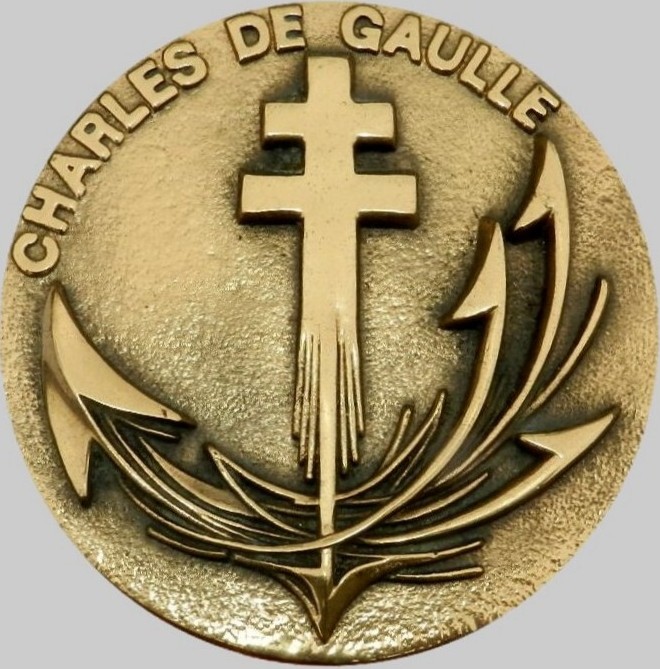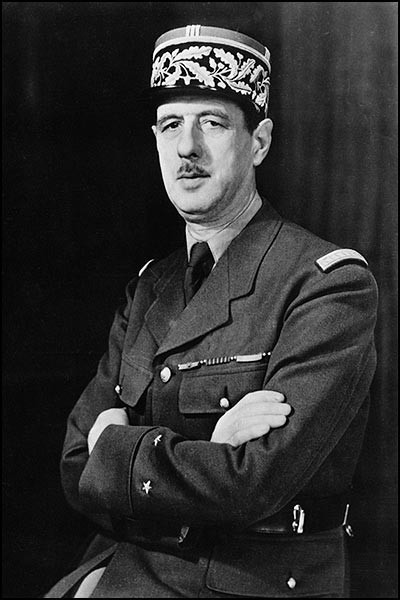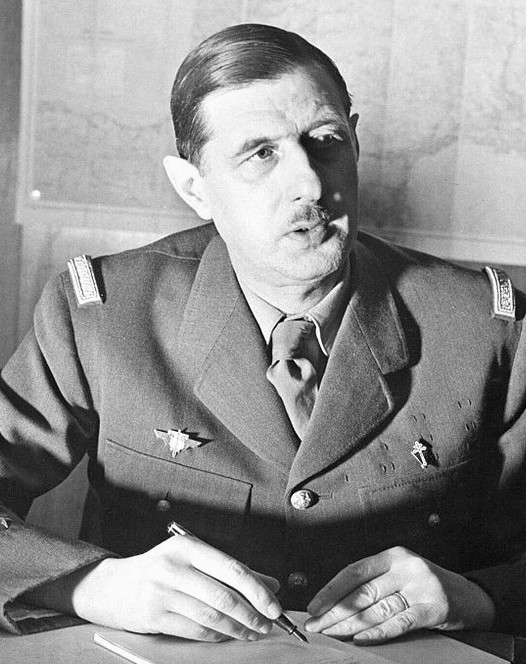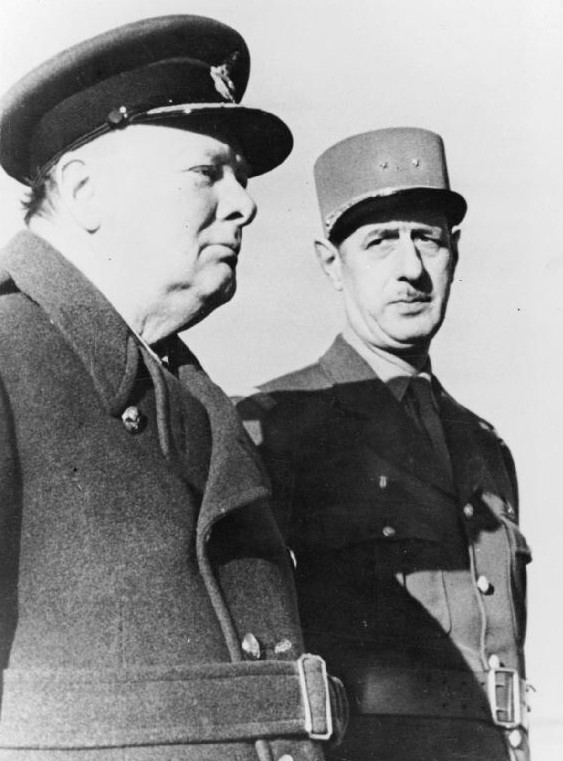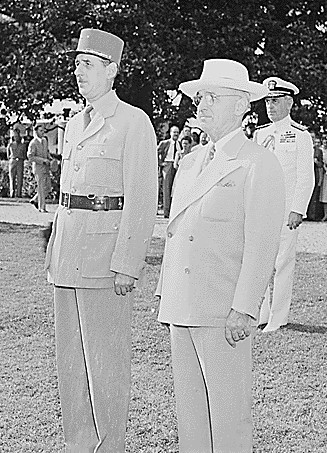 |
||||
|
HOME
|
US Navy -
ships
|
US Navy - air
units
|
USMC - air
units
|
International
Navies
|
Weapon Systems
|
Special Reports |
||||
|
French Navy / Marine Nationale
-
Aircraft Carrier R 91 FS Charles de Gaulle |
||||
|
||||
| 11/22 | ||||
|
Type,
class: Aircraft Carrier / unique unit / ordered as
Richilieu - renamed Charles de Gaulle in 1987 Builder: DCNS, Brest, Brittany, France STATUS: Ordered: February 3, 1986 Laid down: April 14, 1989 Launched: May 7, 1994 Commissioned: May 18, 2001 IN SERVICE Homeport: Toulon Namesake: General Charles Andre Joseph Marie de Gaulle (1890-1970) Technical Data: Lenght: 261,5 meters (858 feet) Beam: 64,36 m (211.2 ft) Draft: 9,43 m (30.9 ft) Displacement: 42500 tons (full load) Speed: 27 knots (50 km/h) Complement: ship 1350 / air wing 600 Propulsion: 2 x Areva K15 pressurized water reactors (PWR) 150 MW each 2 x Alstom steam turbines with 61MW (81800 hp) total shaft power 2 shafts / 2 propellers Armament: 4 x SYLVER A-43 (8-cell) VLS for MBDA Aster 15 SAM 2 x SADRAL launchers (6-cell) for Mistral SAM 8 x GIAT 20F2 20mm machine guns 3 x Nexter Narwhal-20 NWS Aviation: full flight deck (12000 m2) / angled landing area (203 x 20 meters) hangar: 4600 m2 / 2 aircraft elevators up to 40 aircraft: Rafale M / E-2C Hawkeye SA365 Dauphin / EC725 Caracal / NH90 Caiman Systems: DRJB 11B 3-D air search radar DRBV 26D air search radar DRBV 15C low altitude air search radar Arabel target acquisition radar ARBR 21 detector ARBB 33 countermeasures suite ARBG2 MAIGRET interceptor 4 x Sagaie decoy launcher SLAT torpedo countermeasures |
||||
| images | ||||
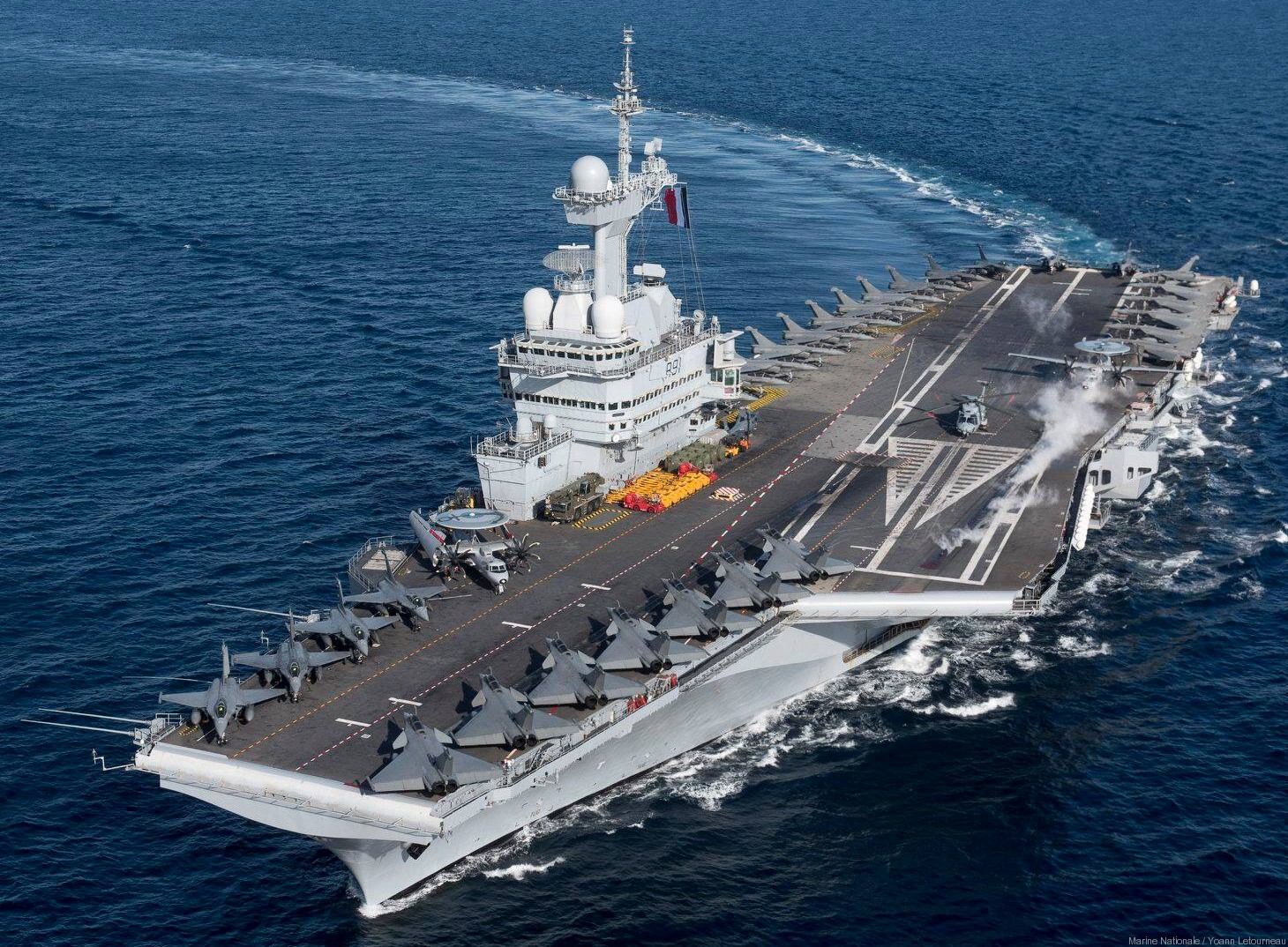 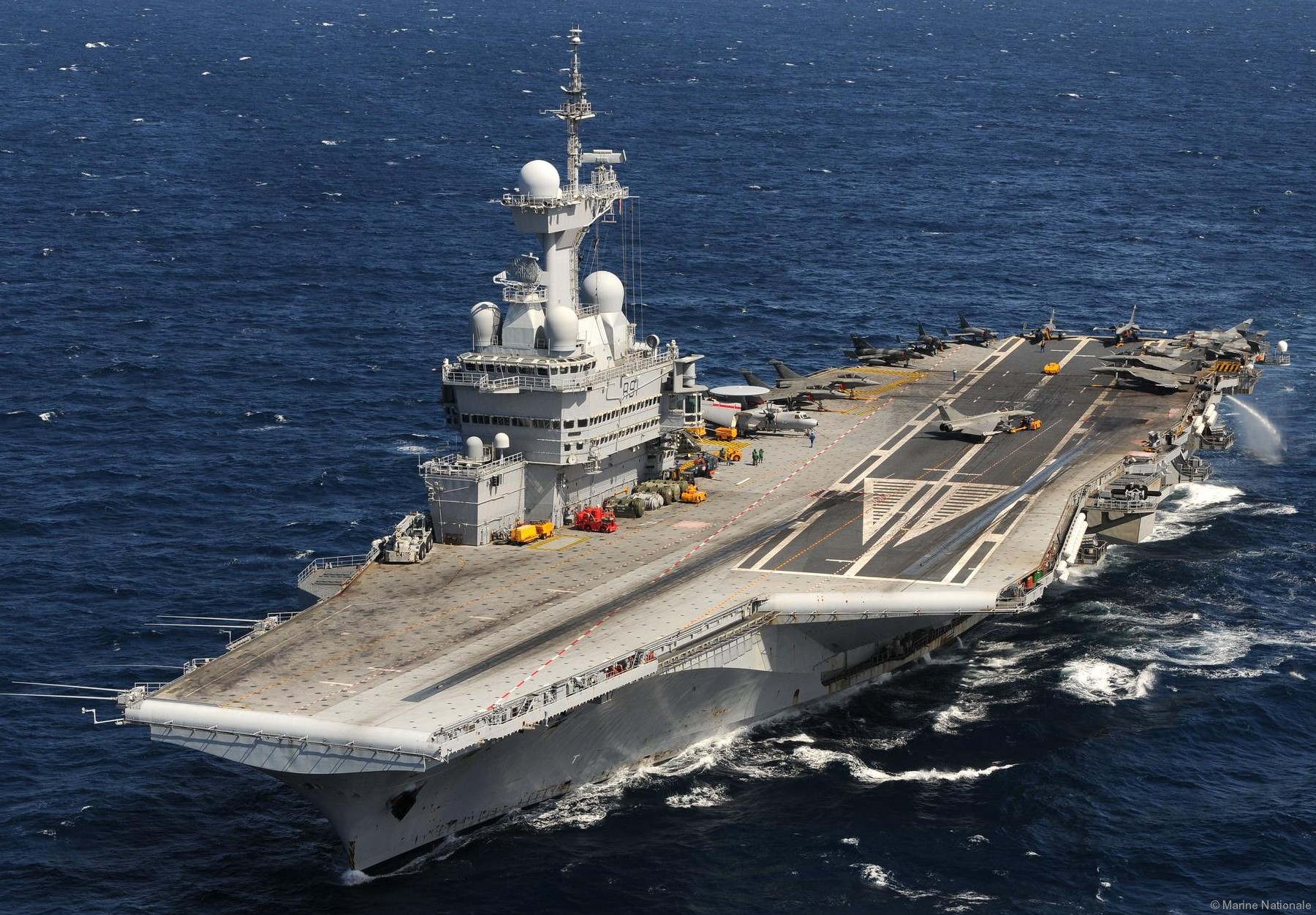 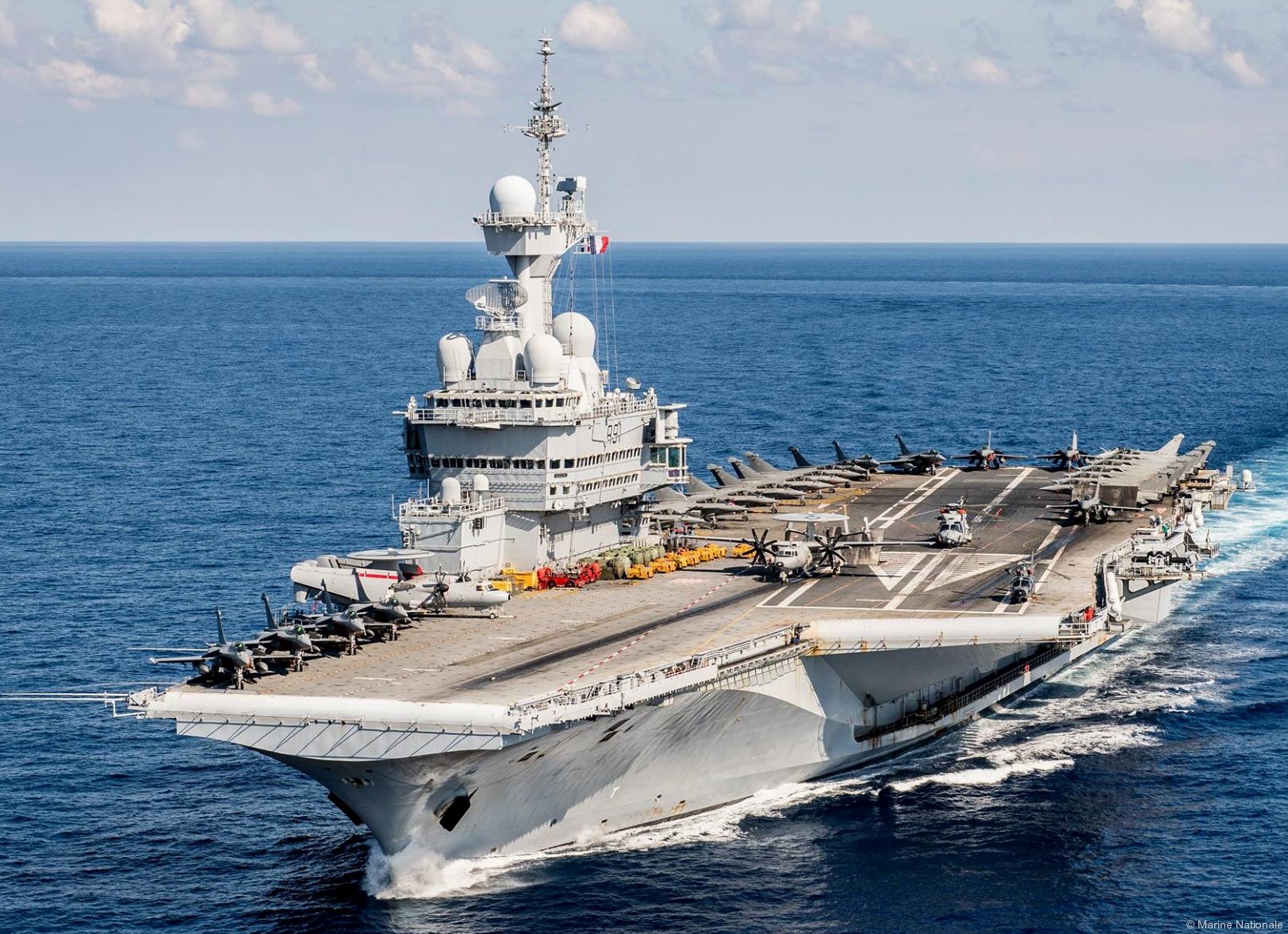 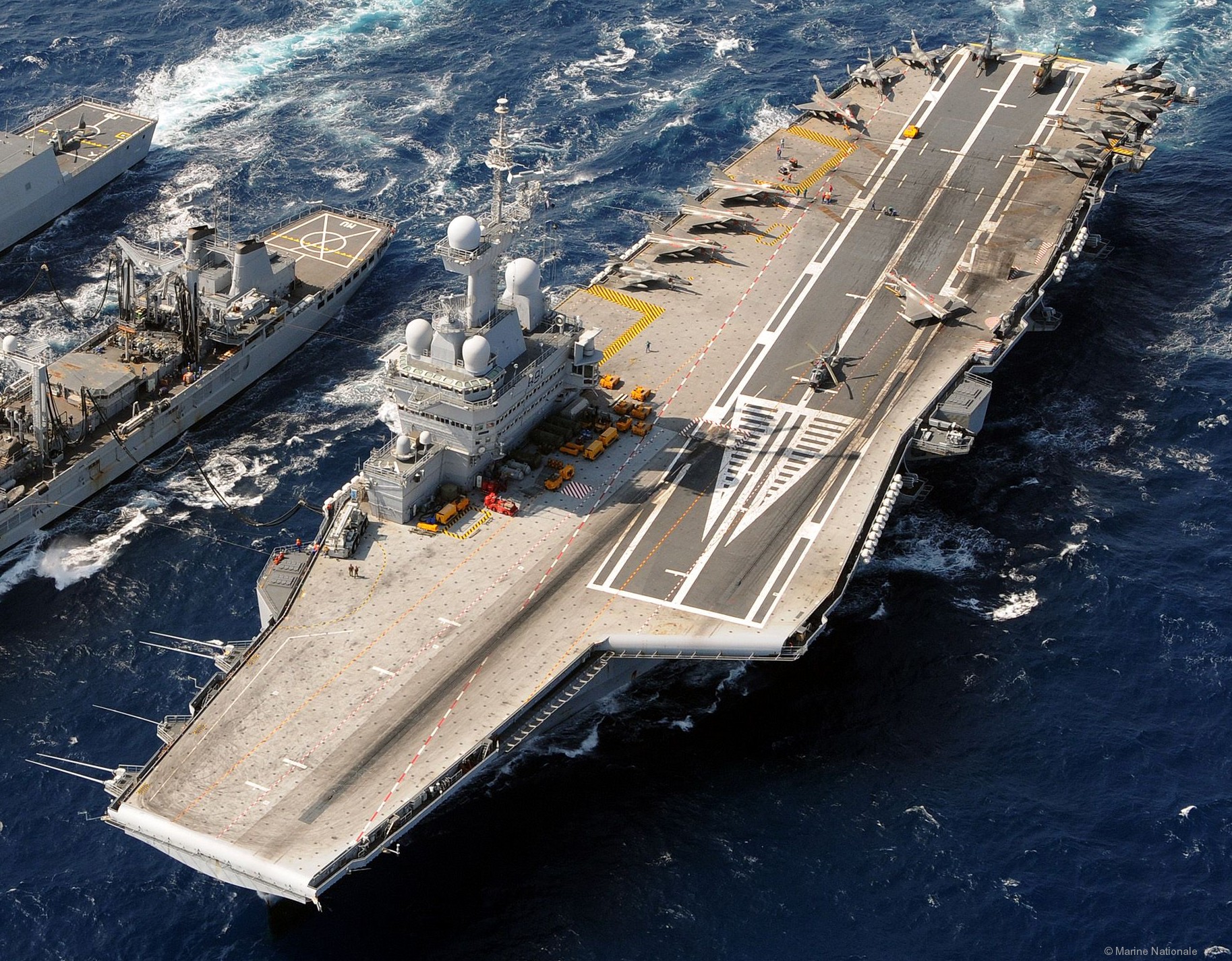 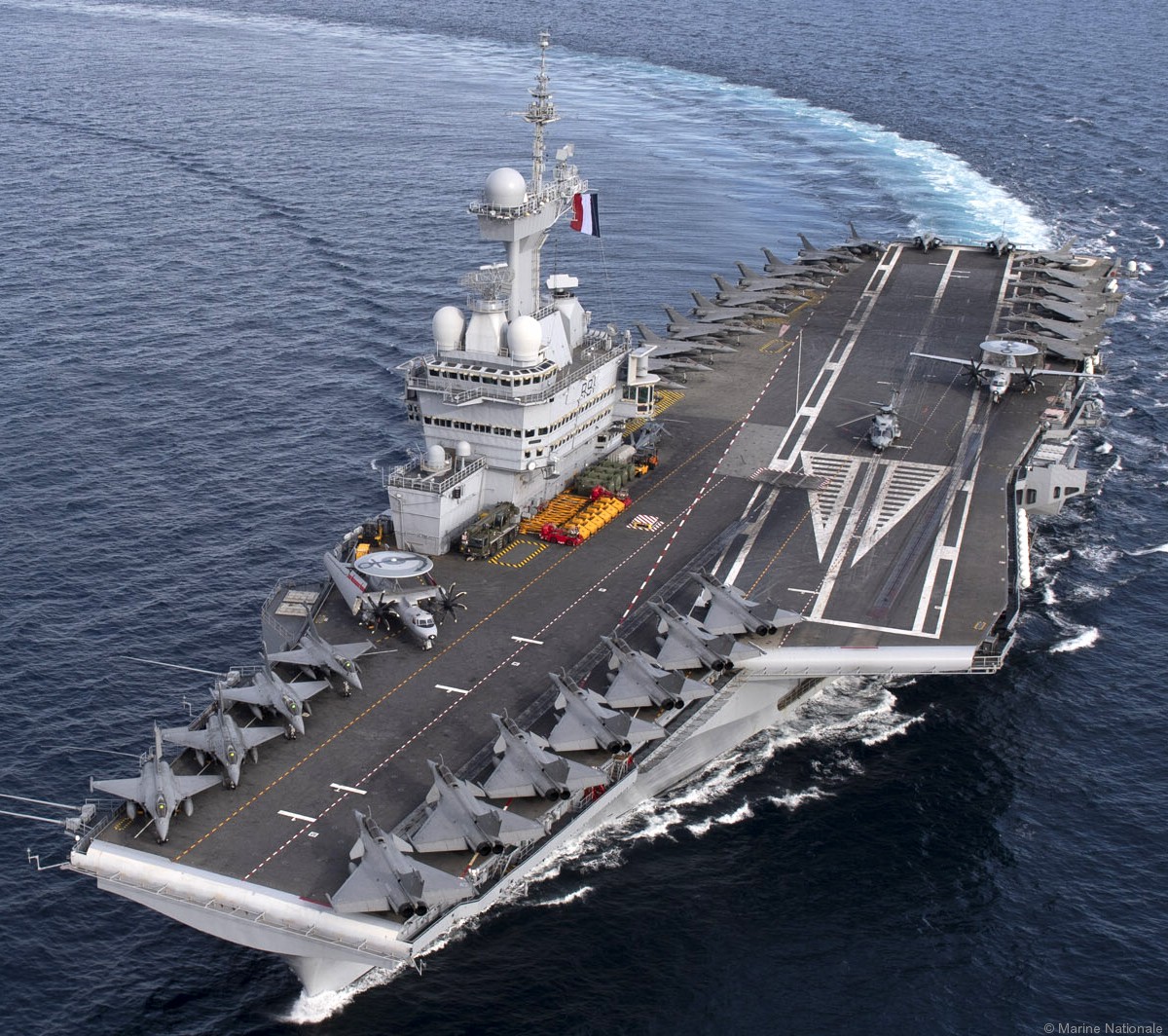 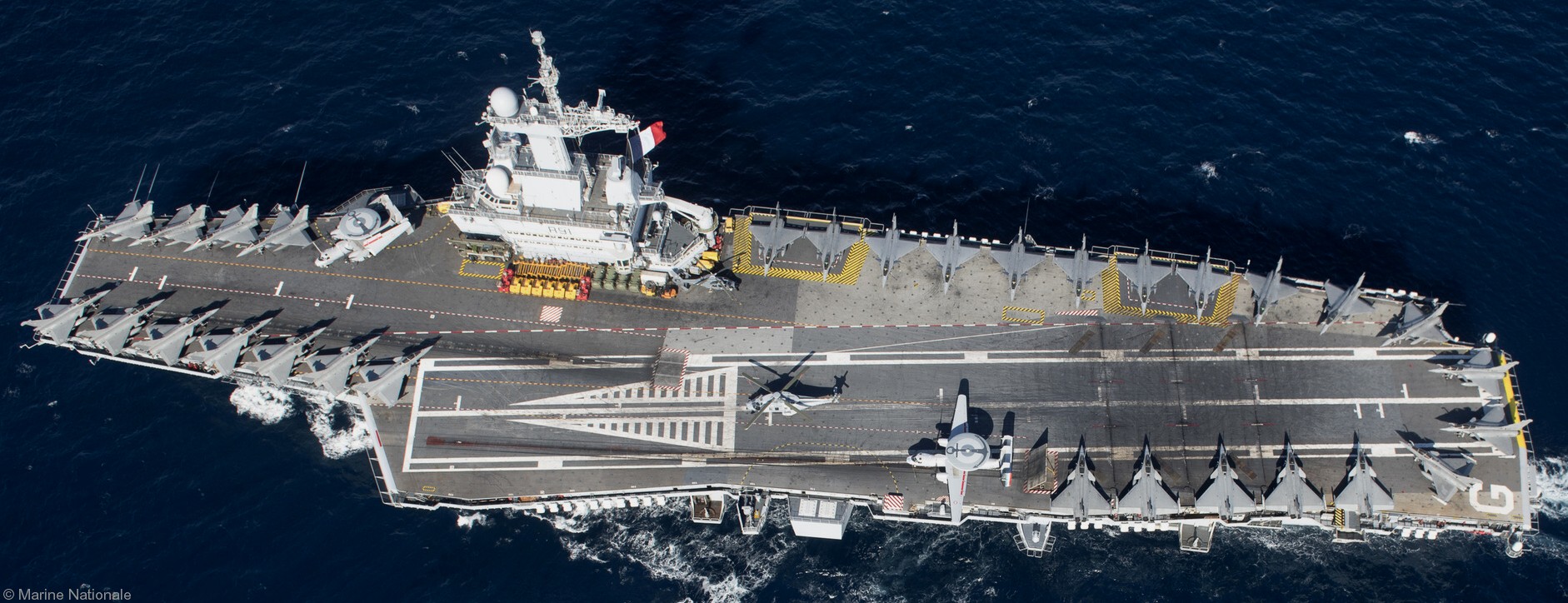 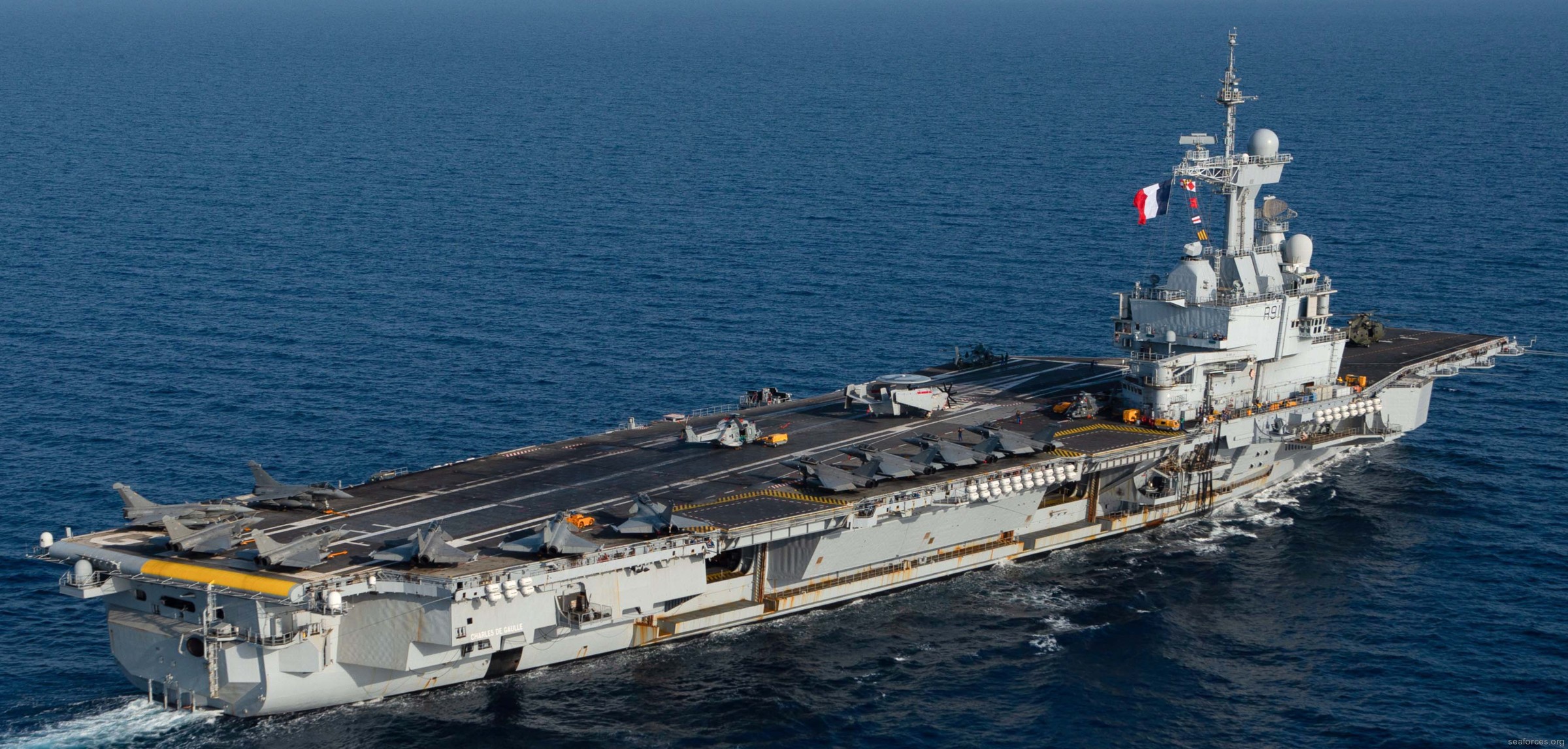 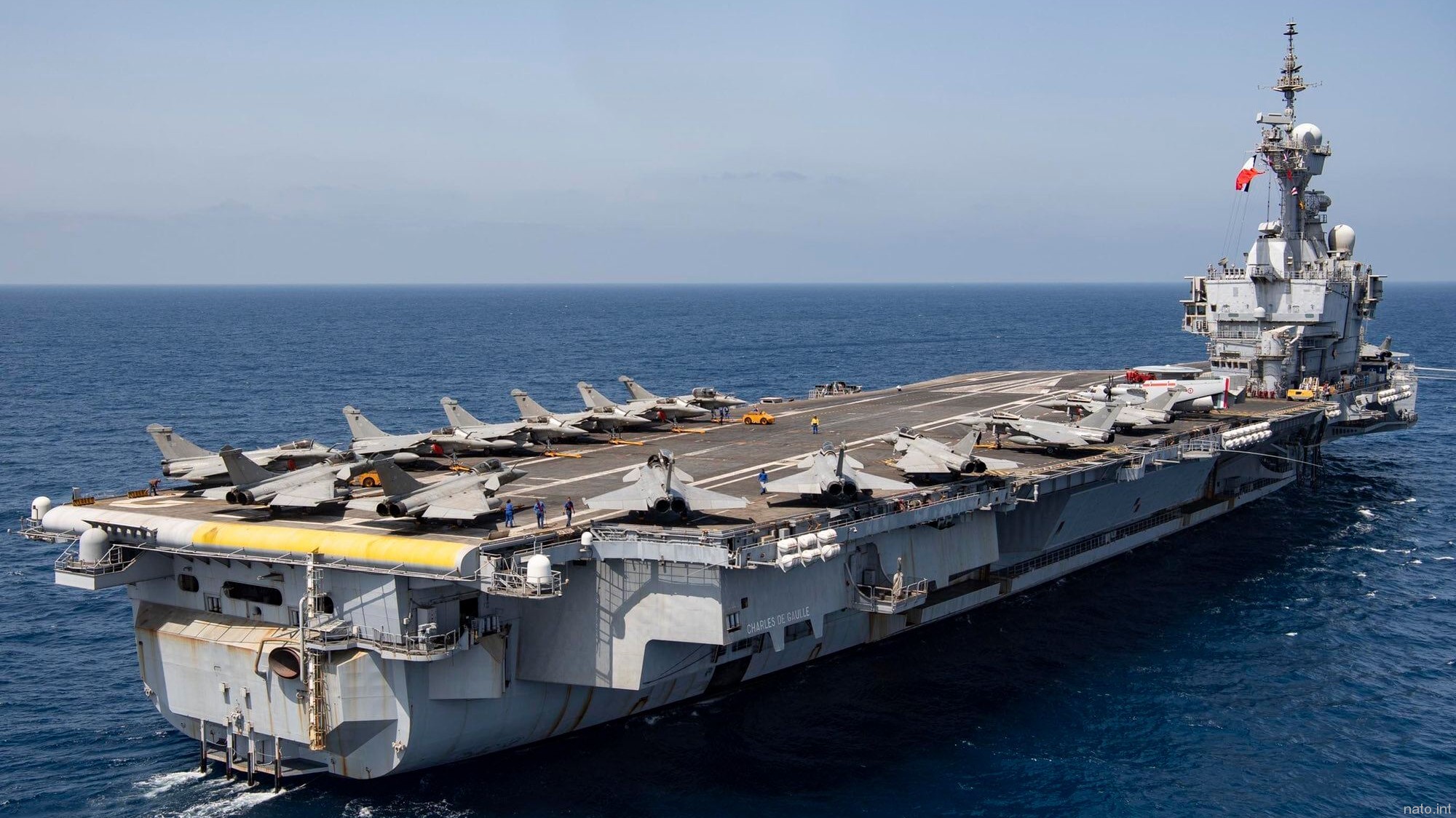 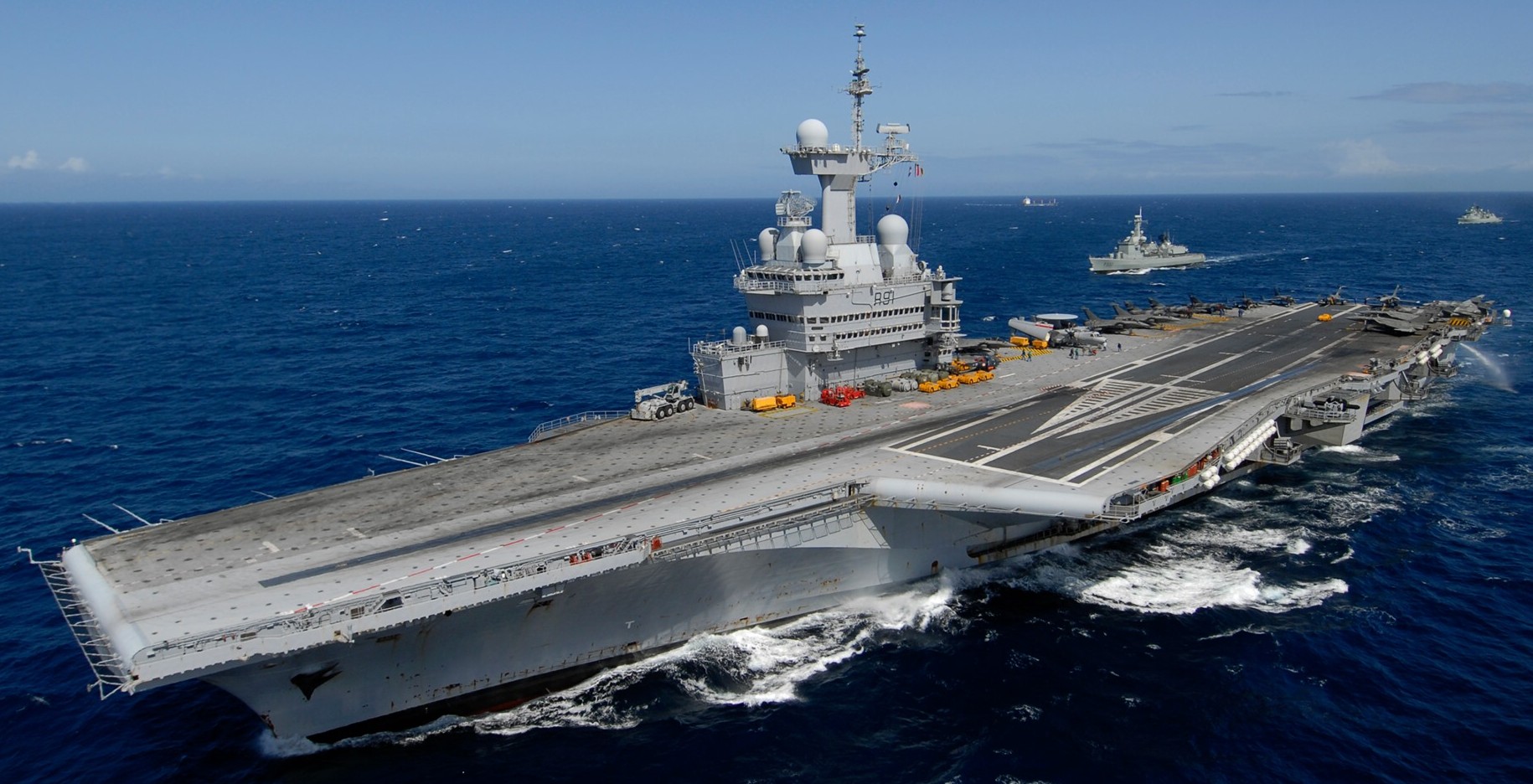 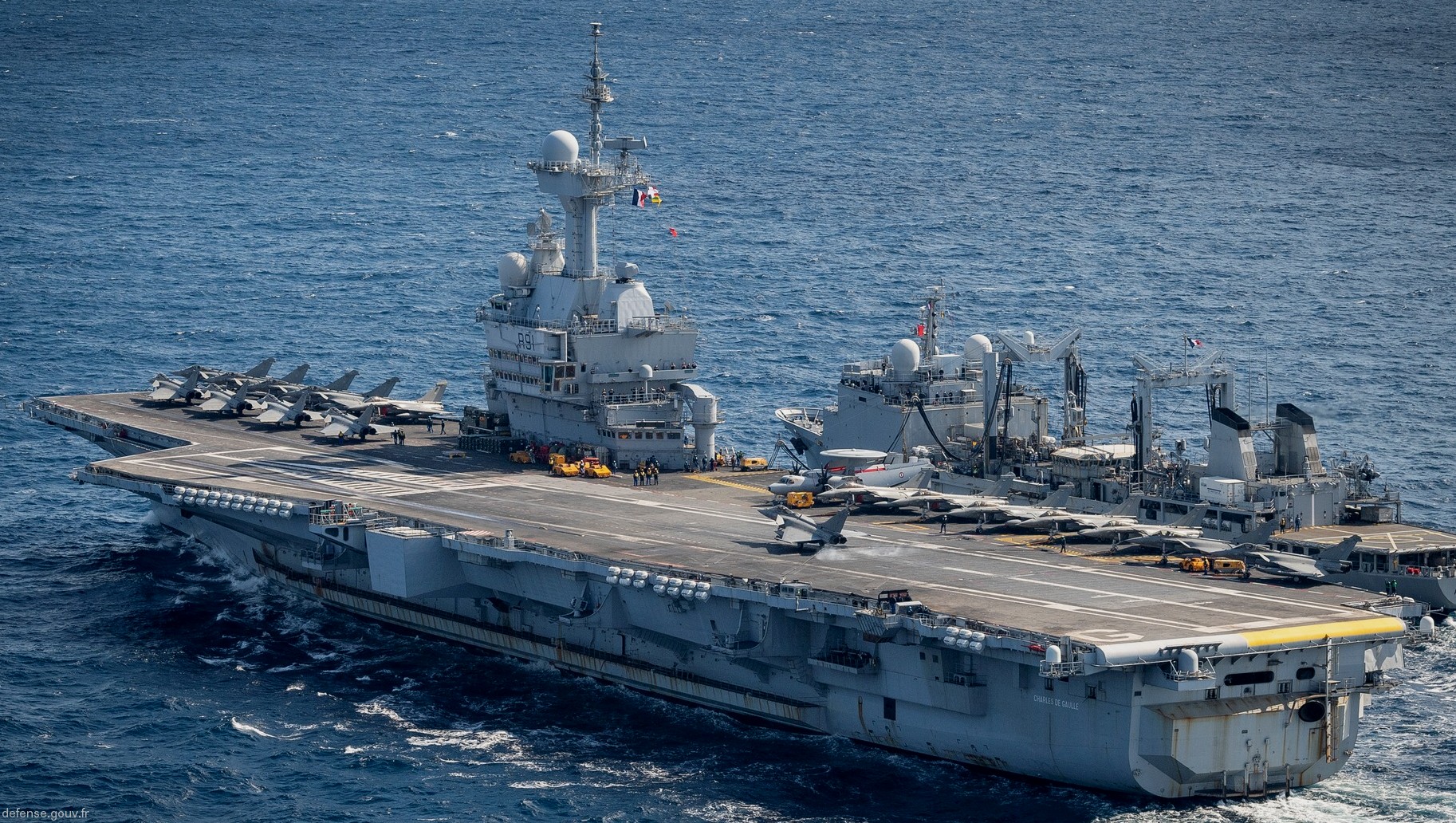 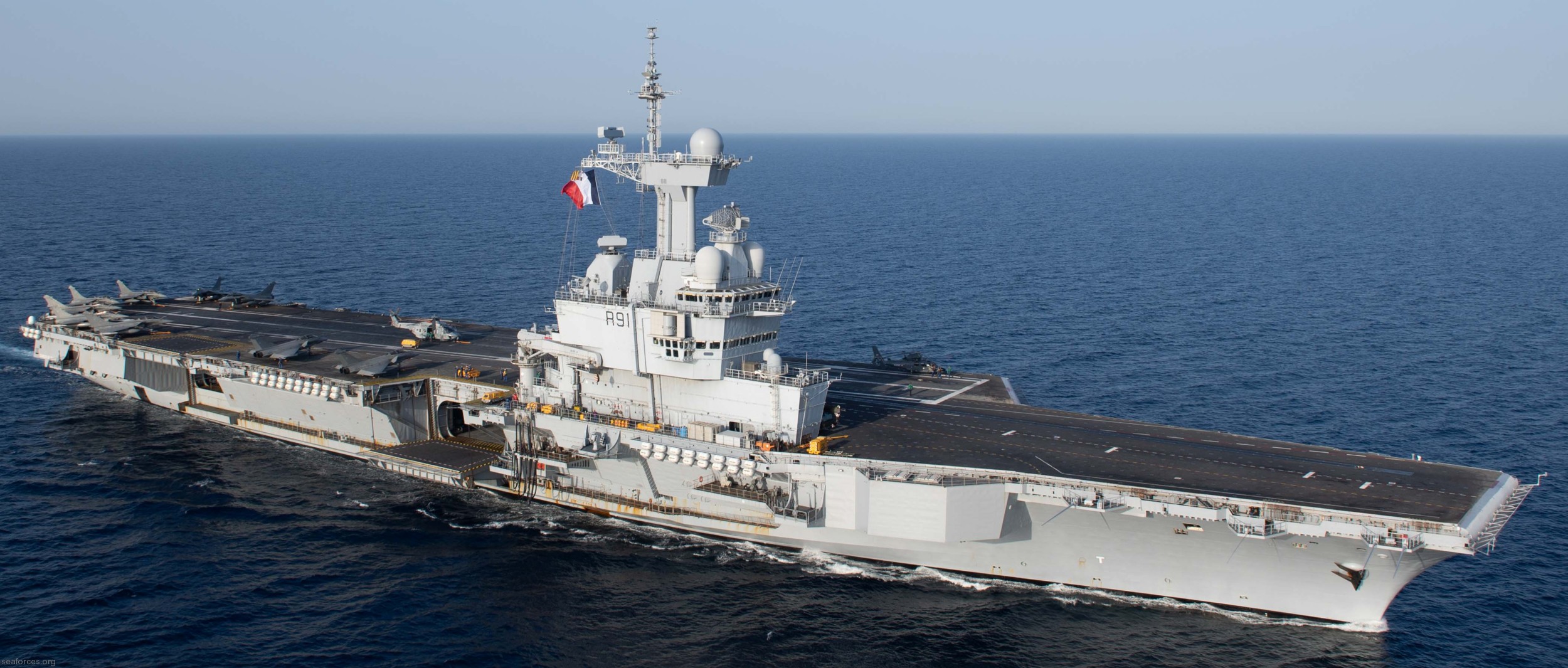 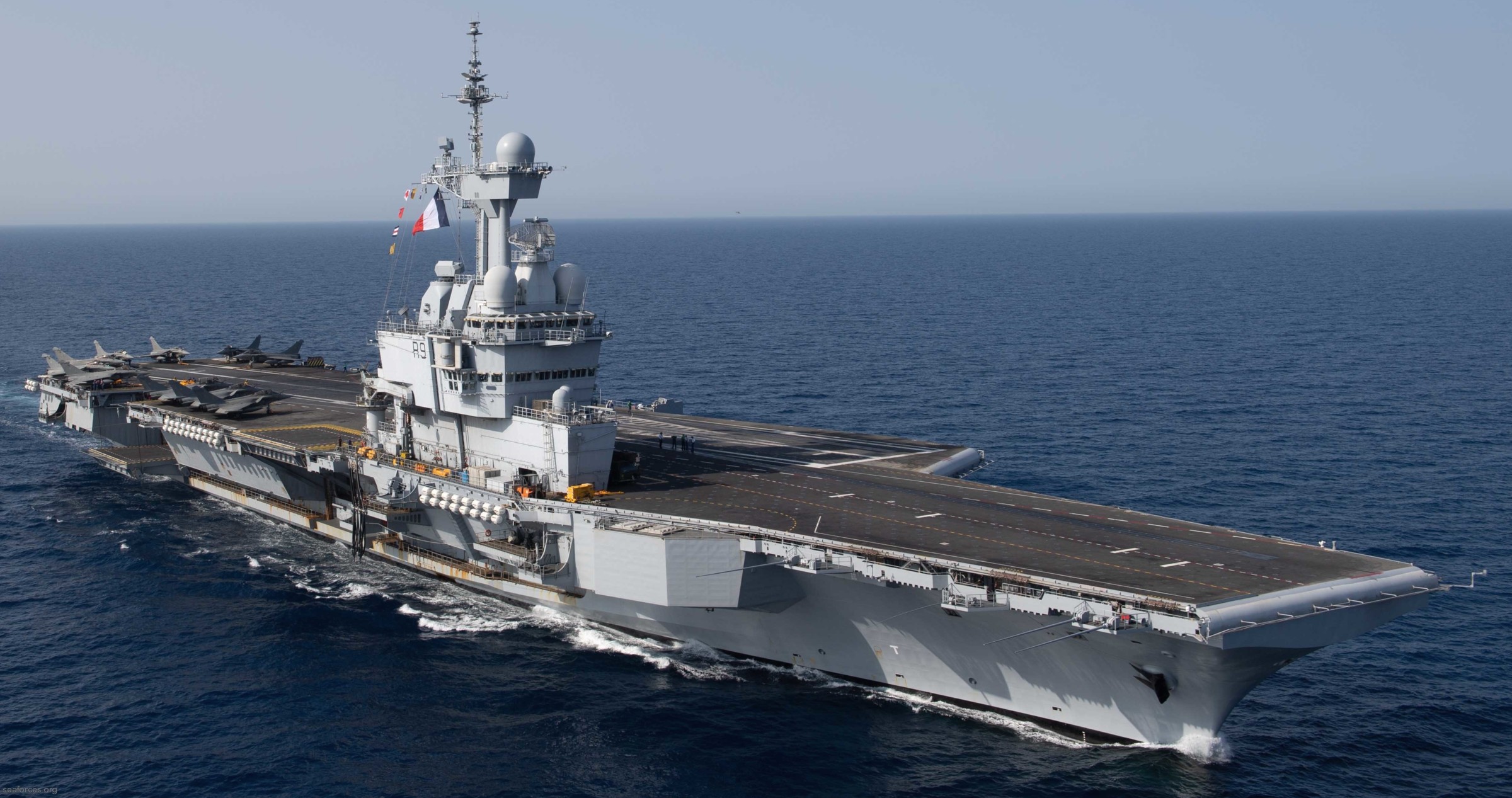 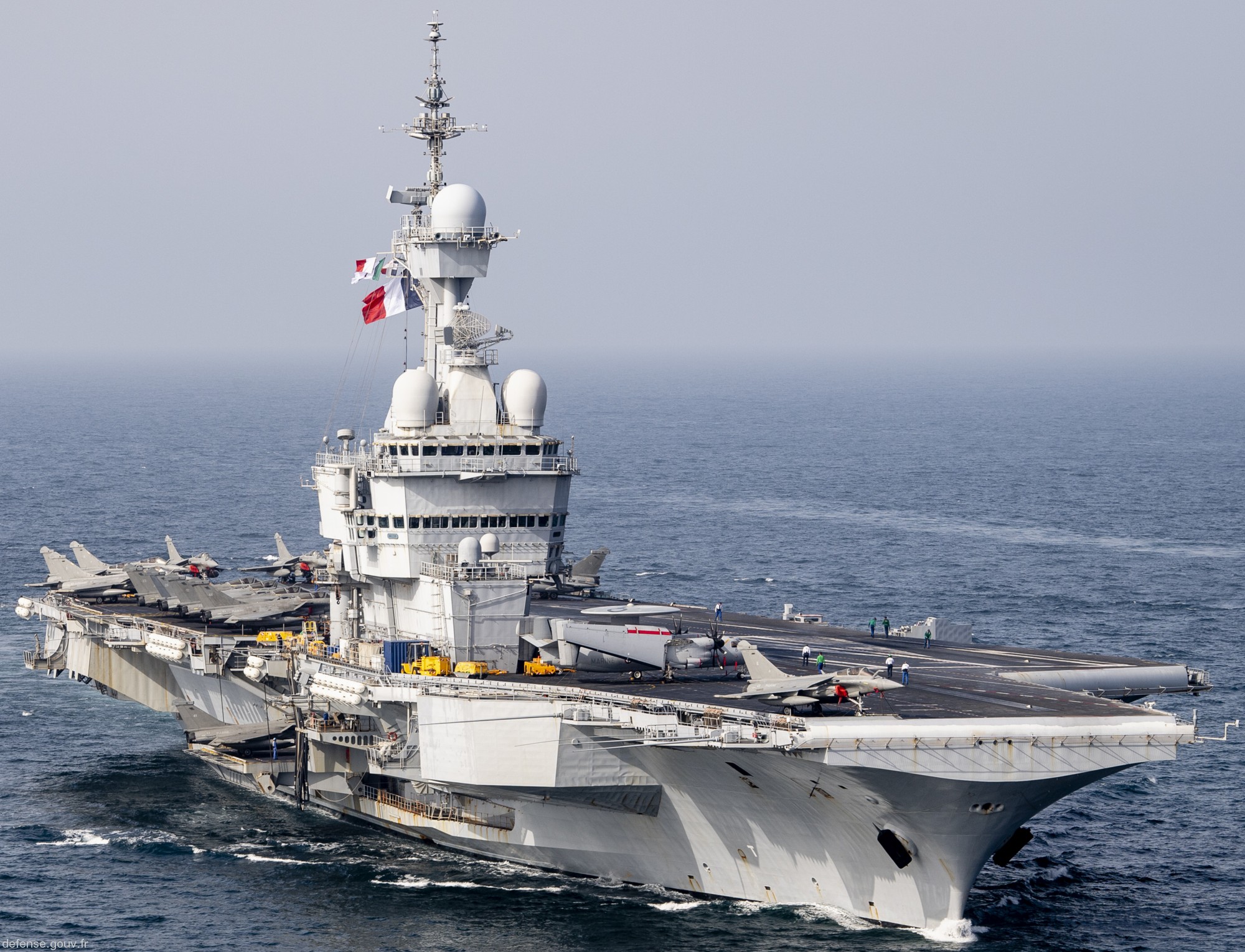 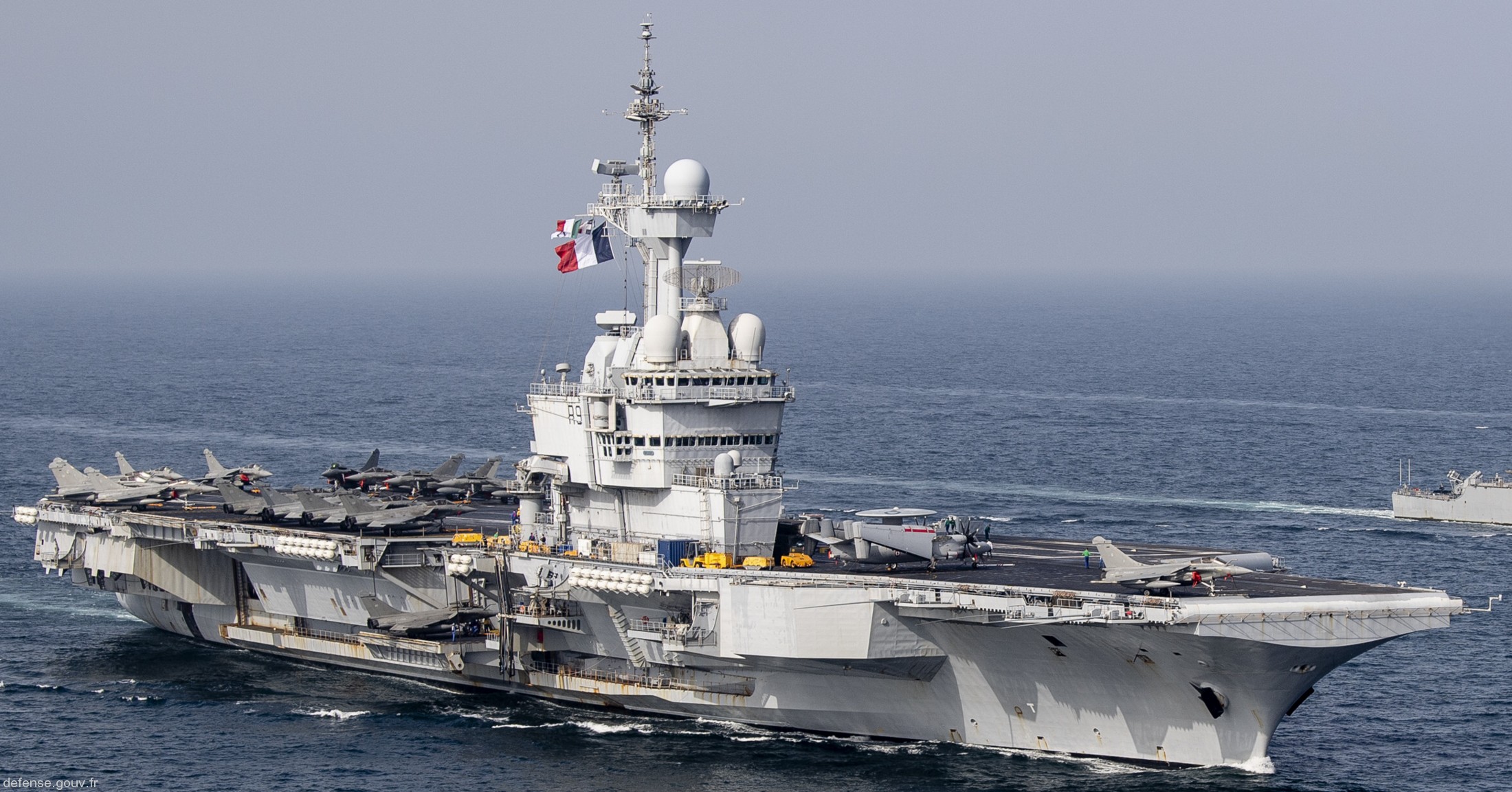 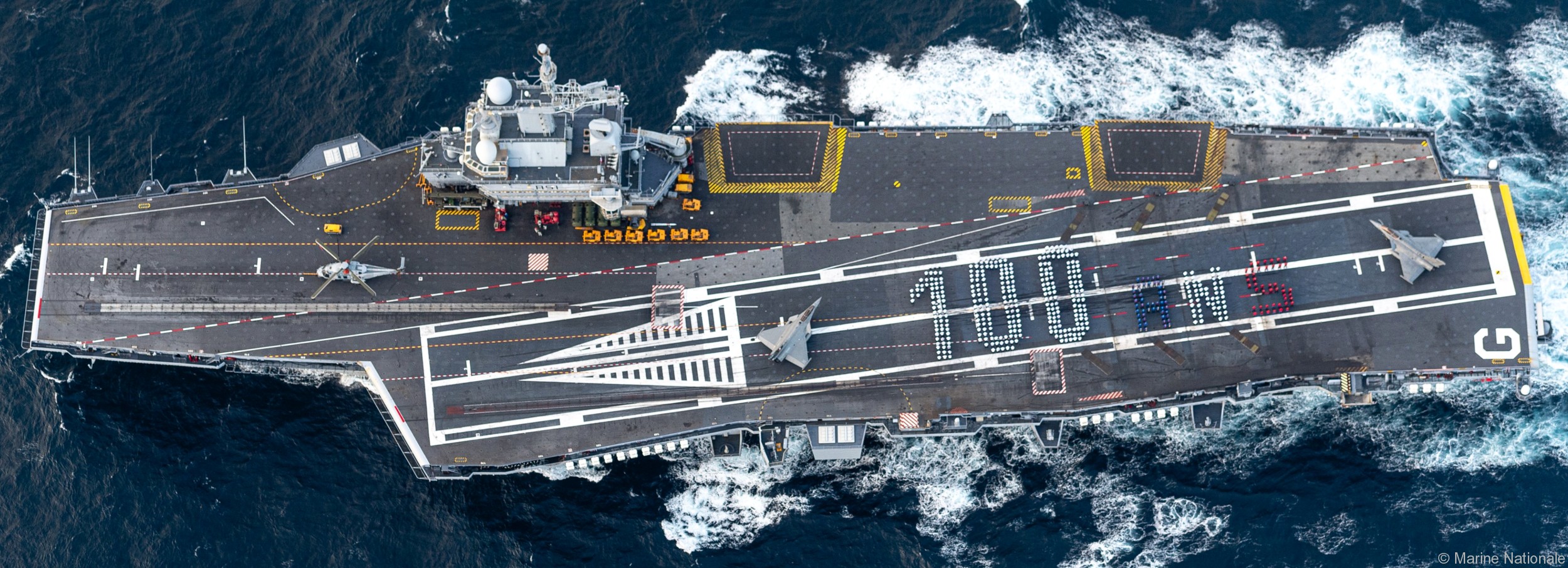   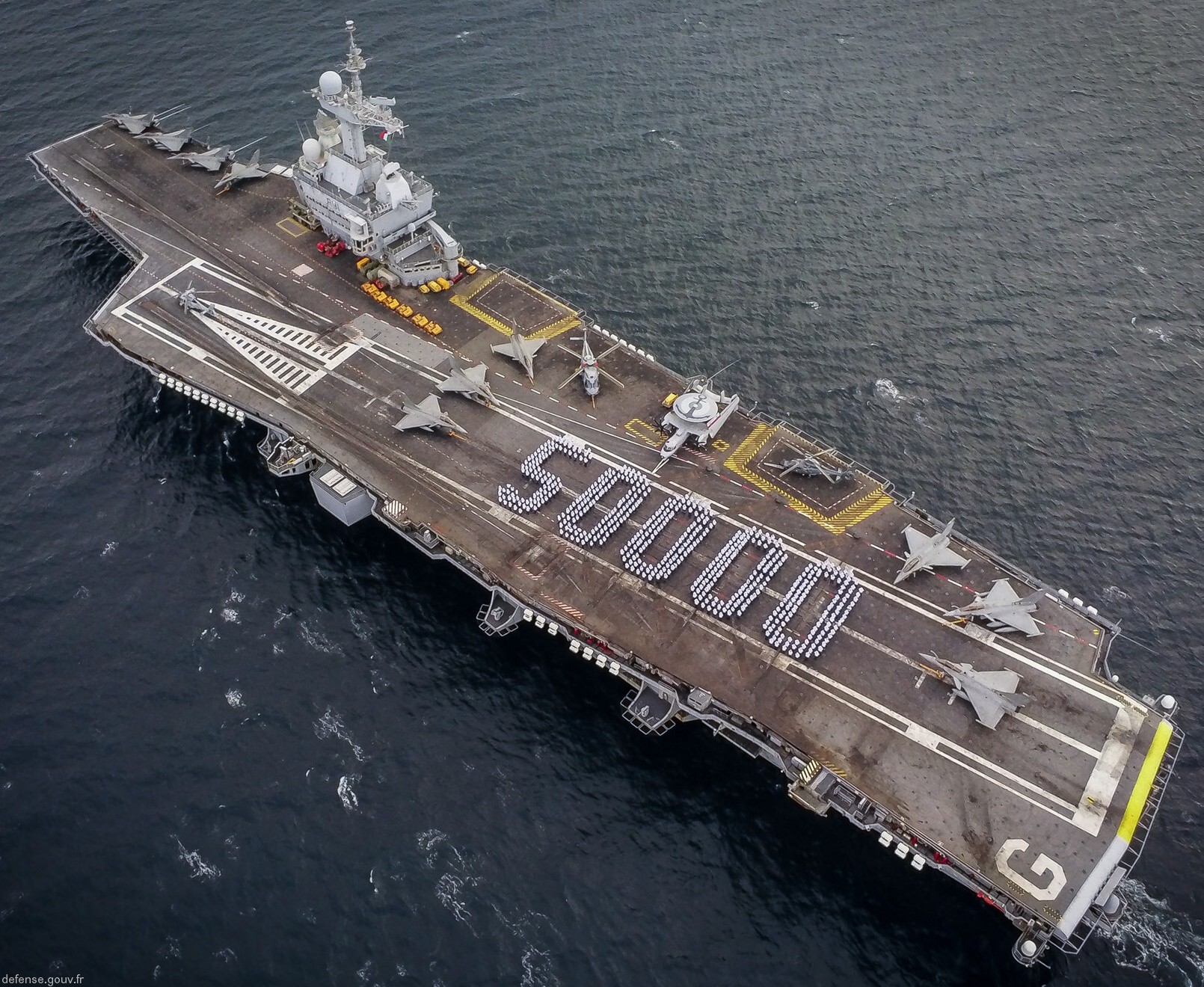 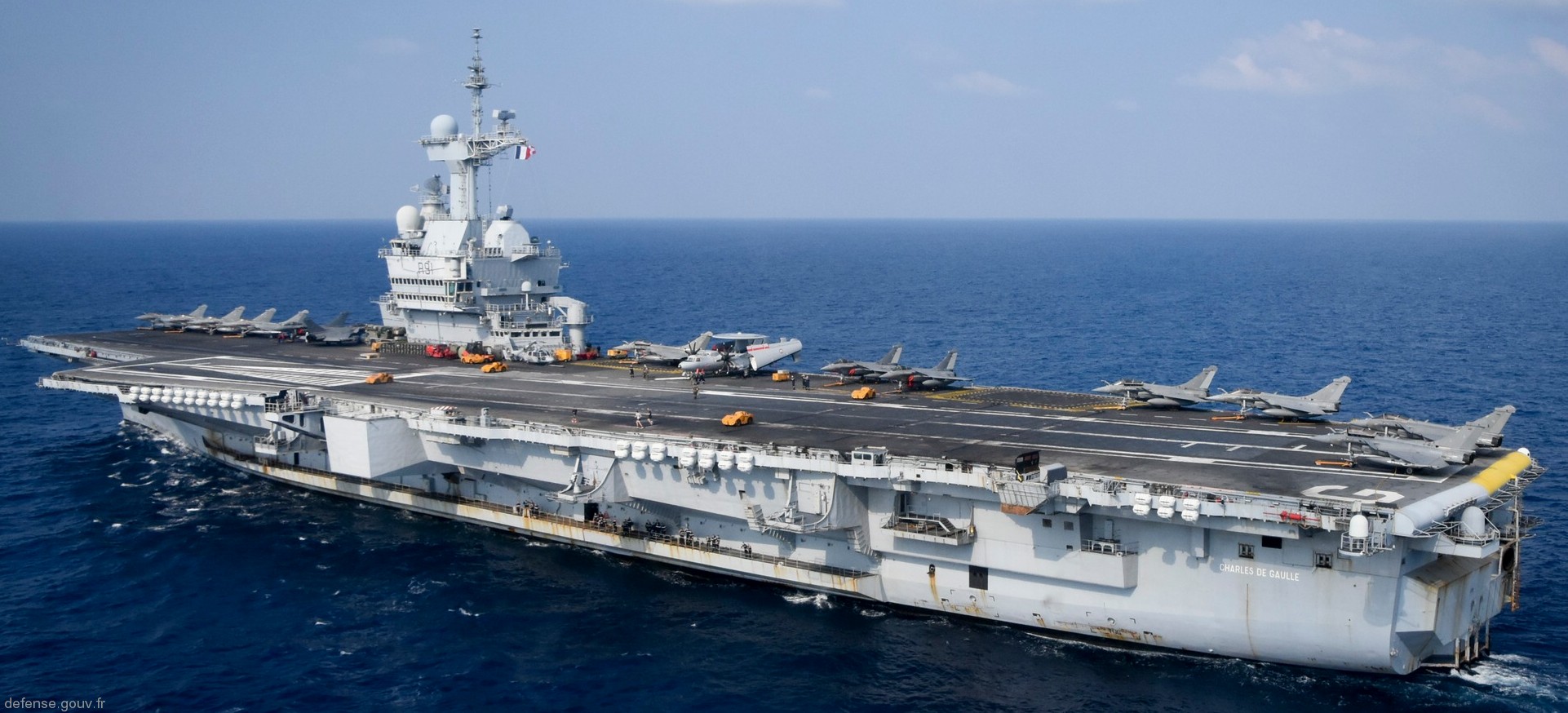 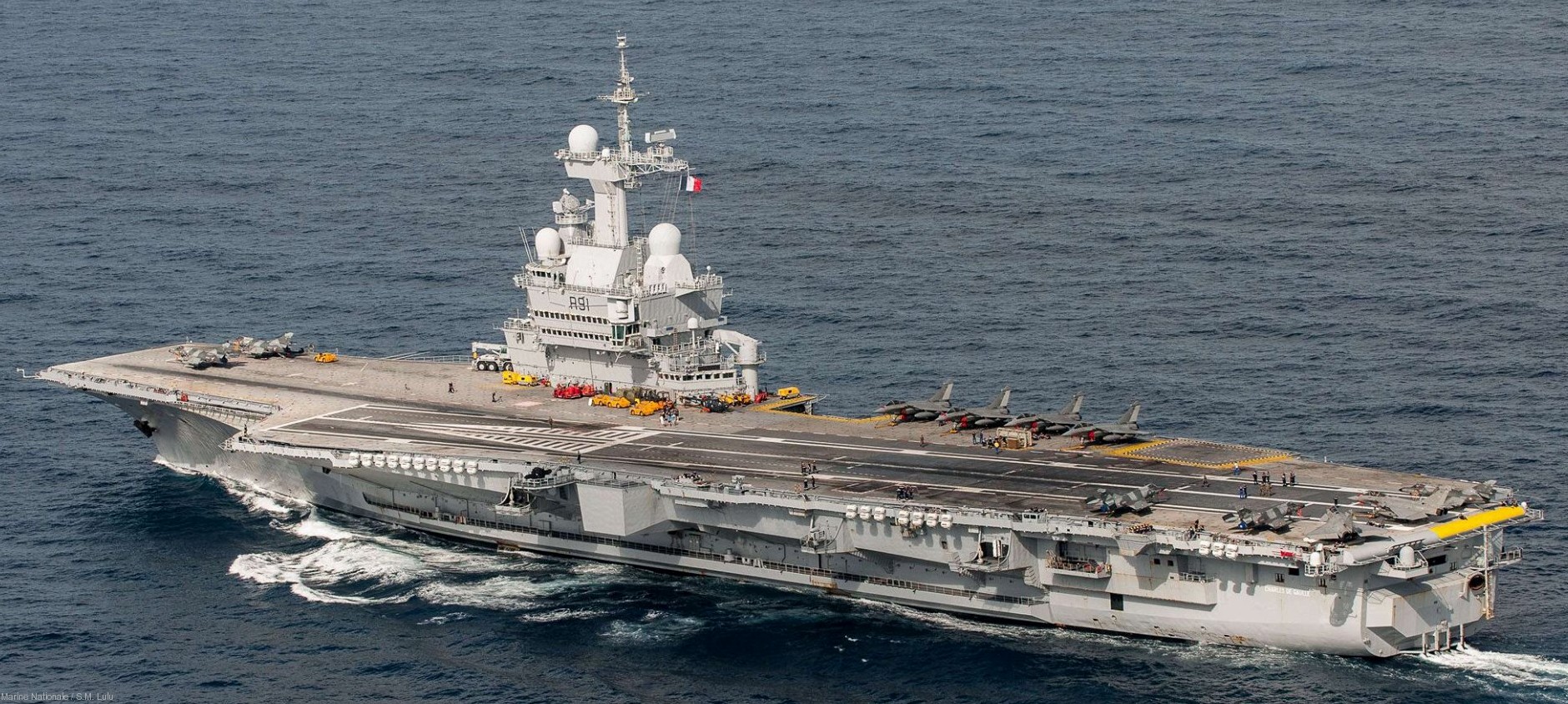 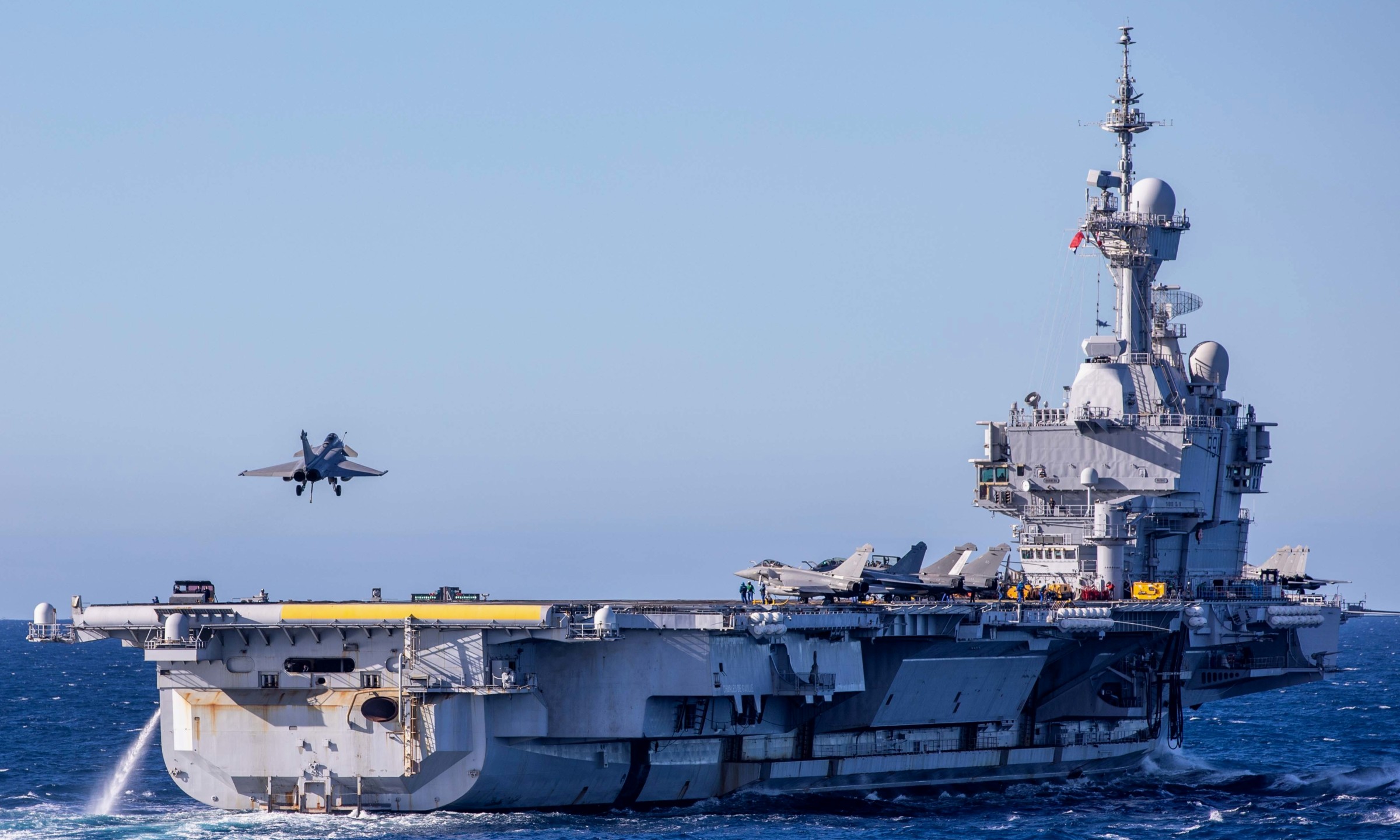 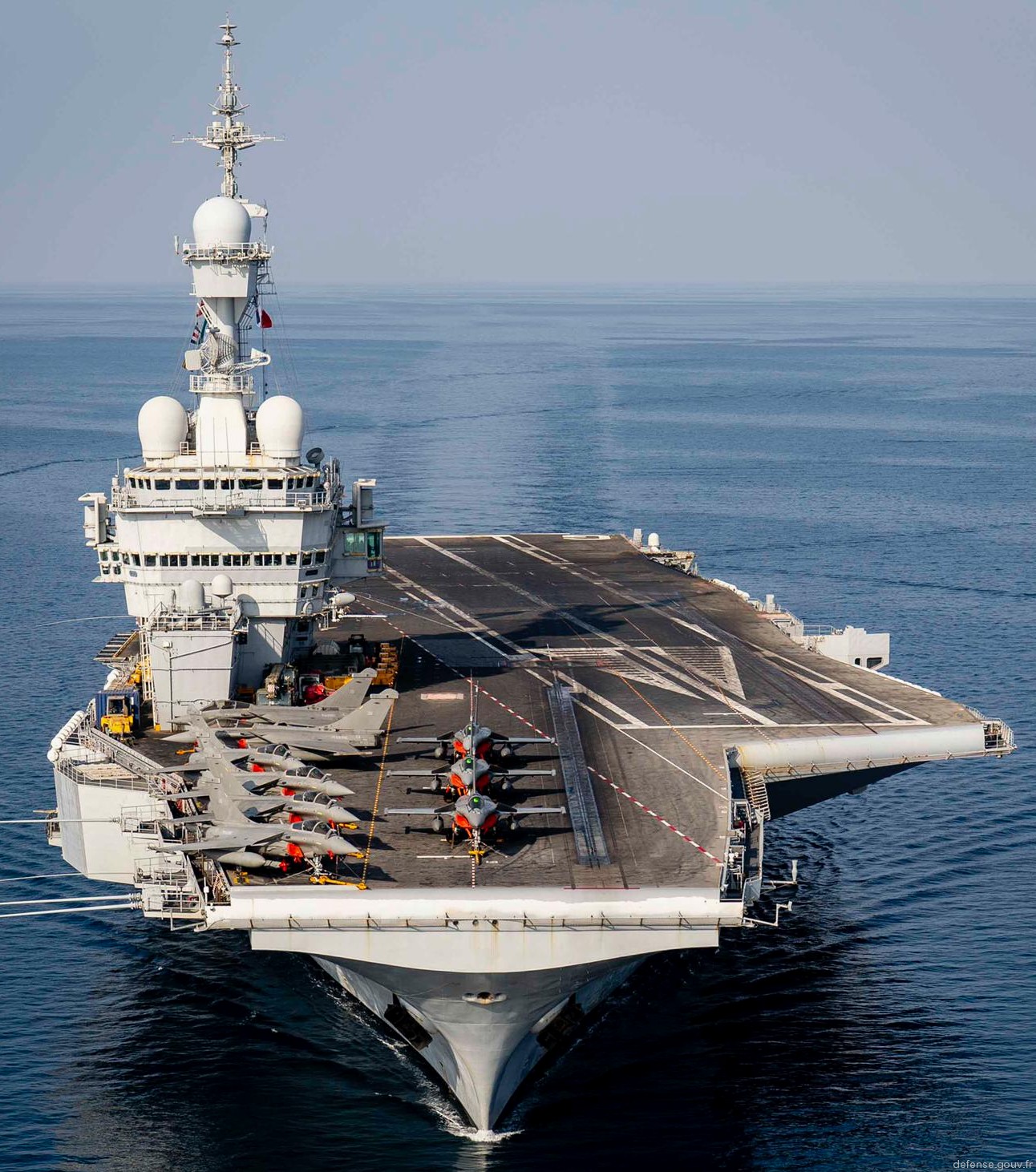 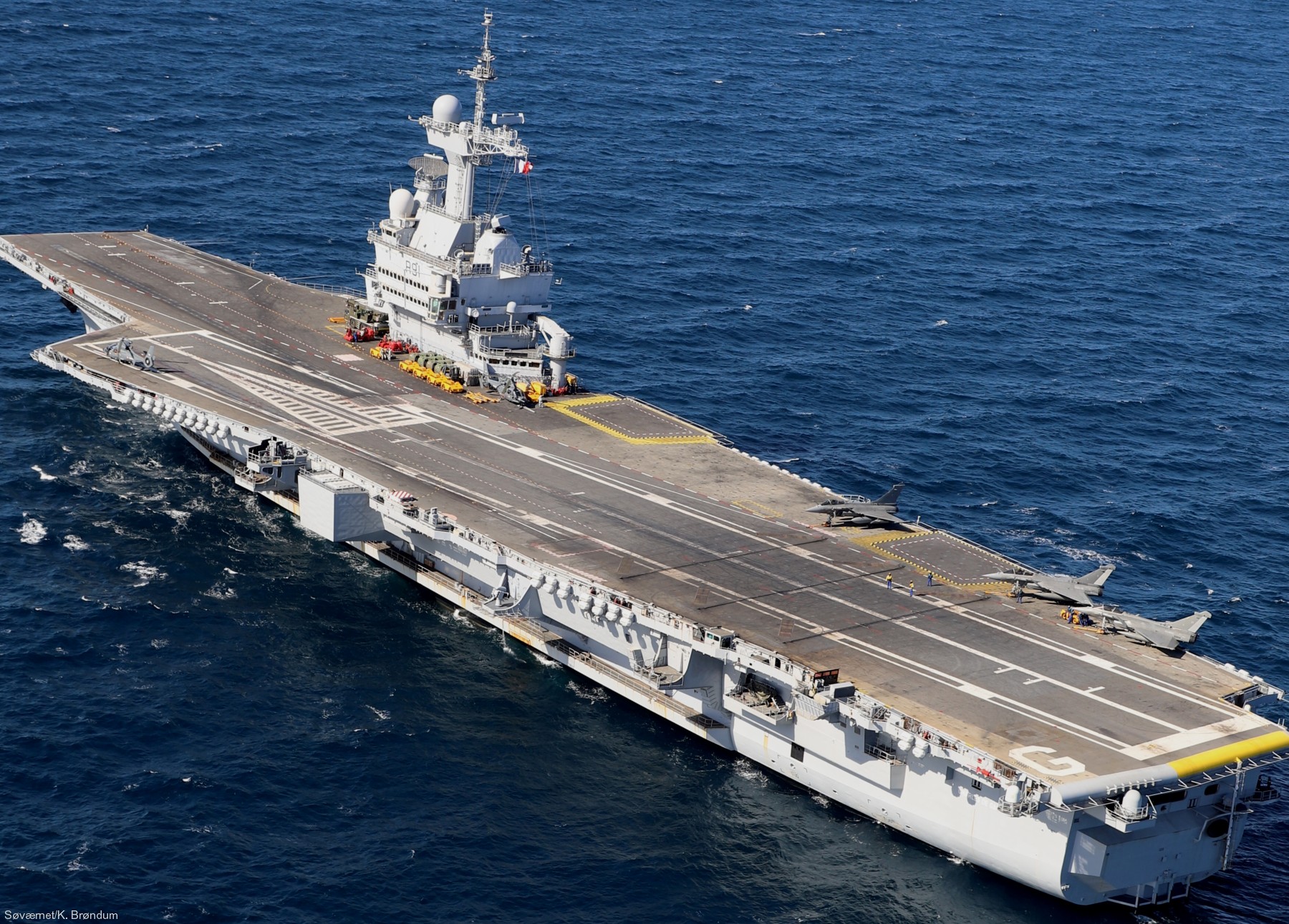 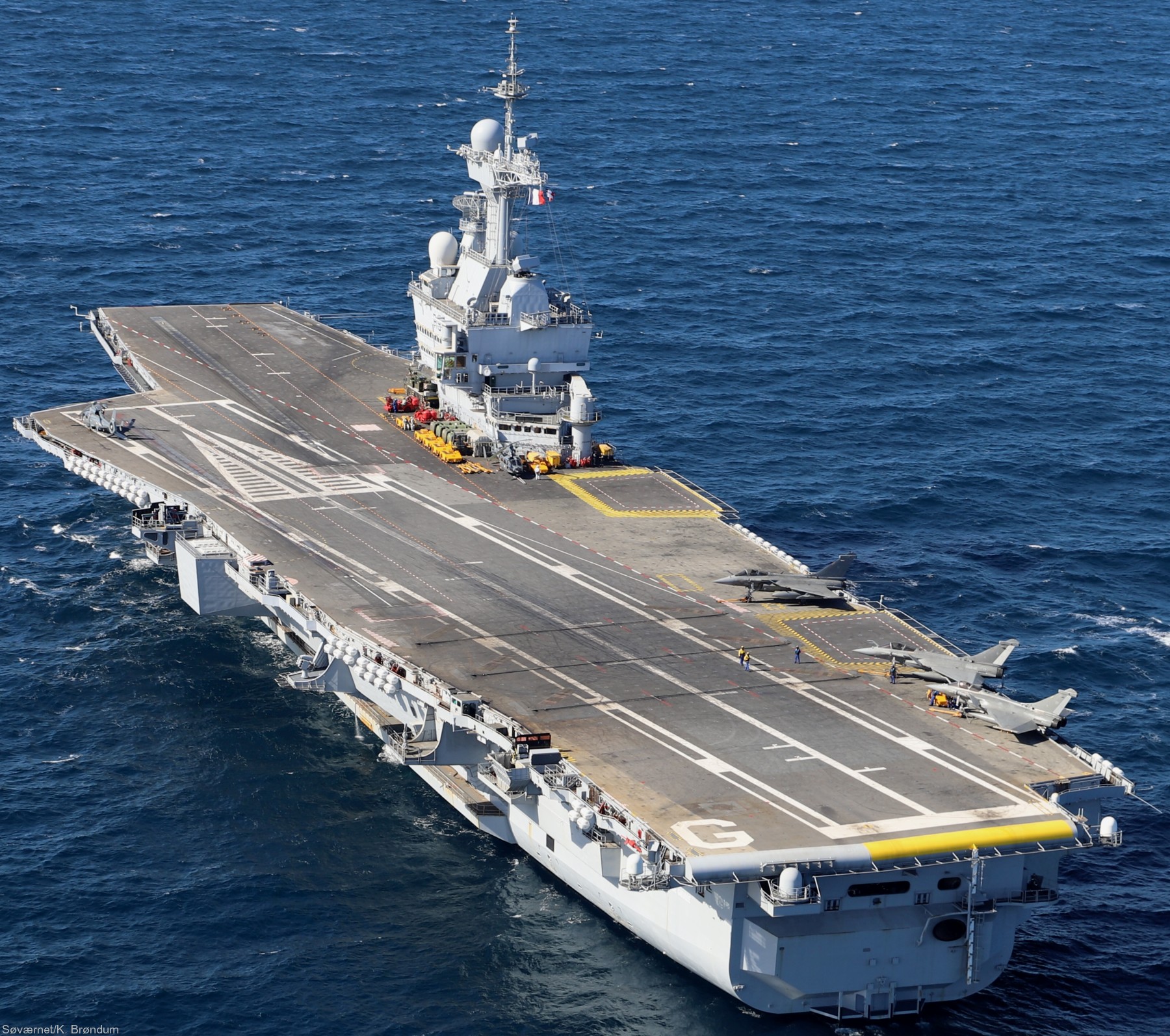  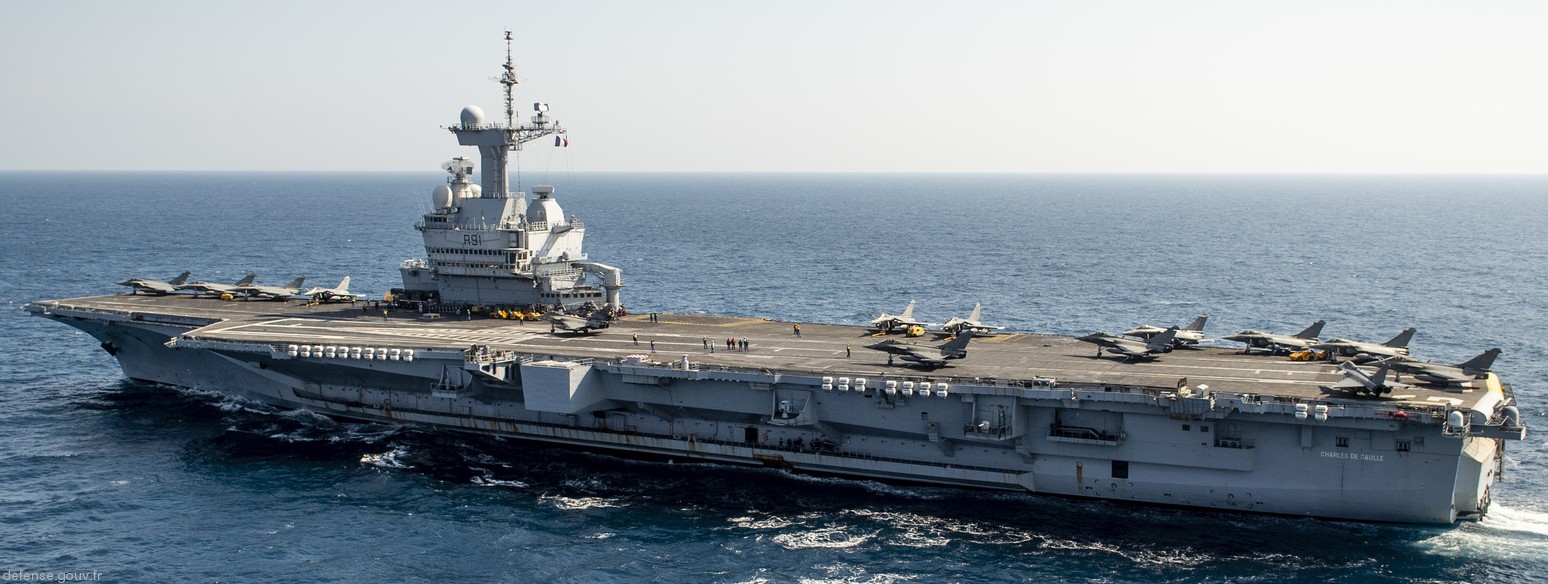 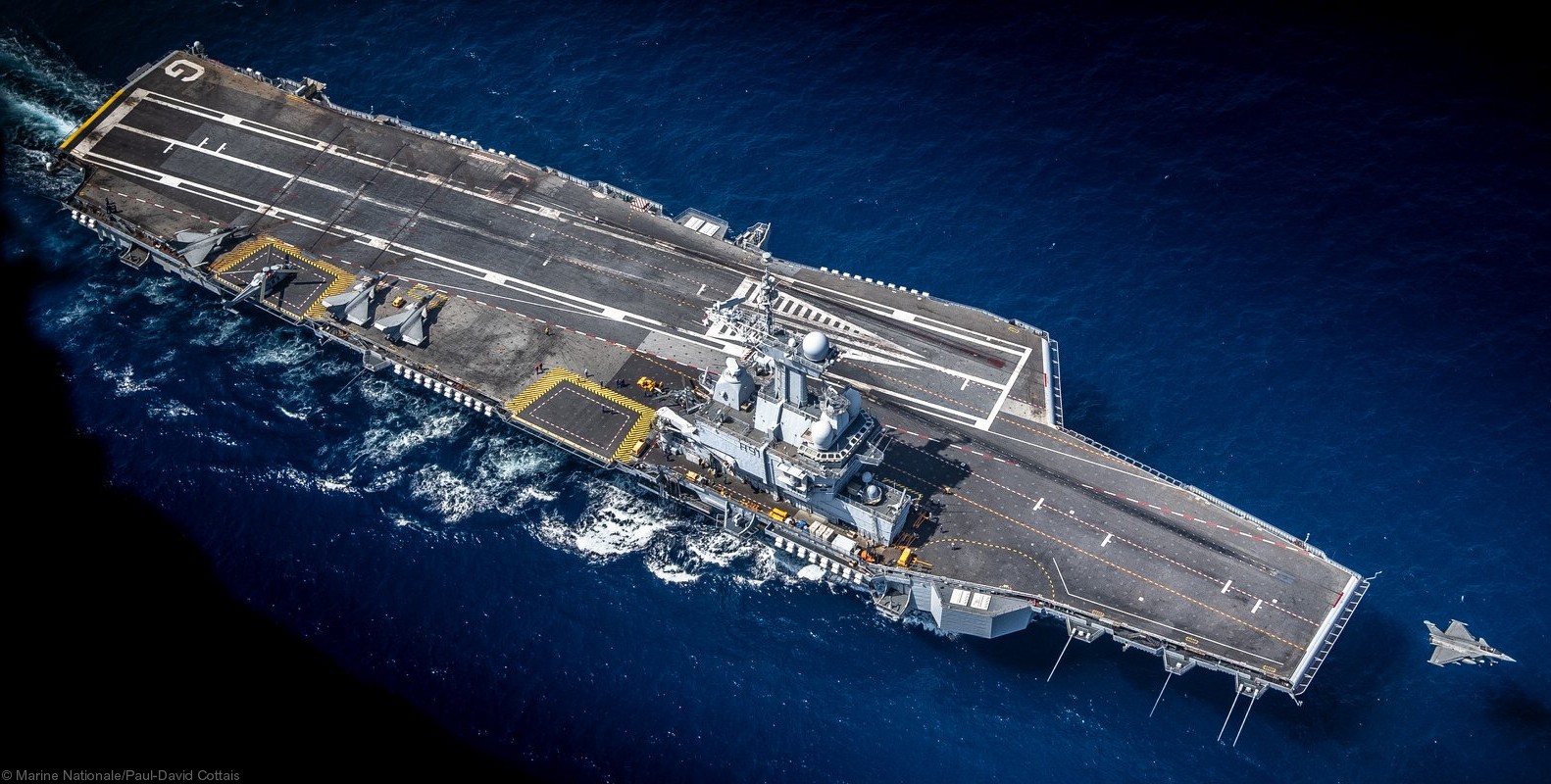 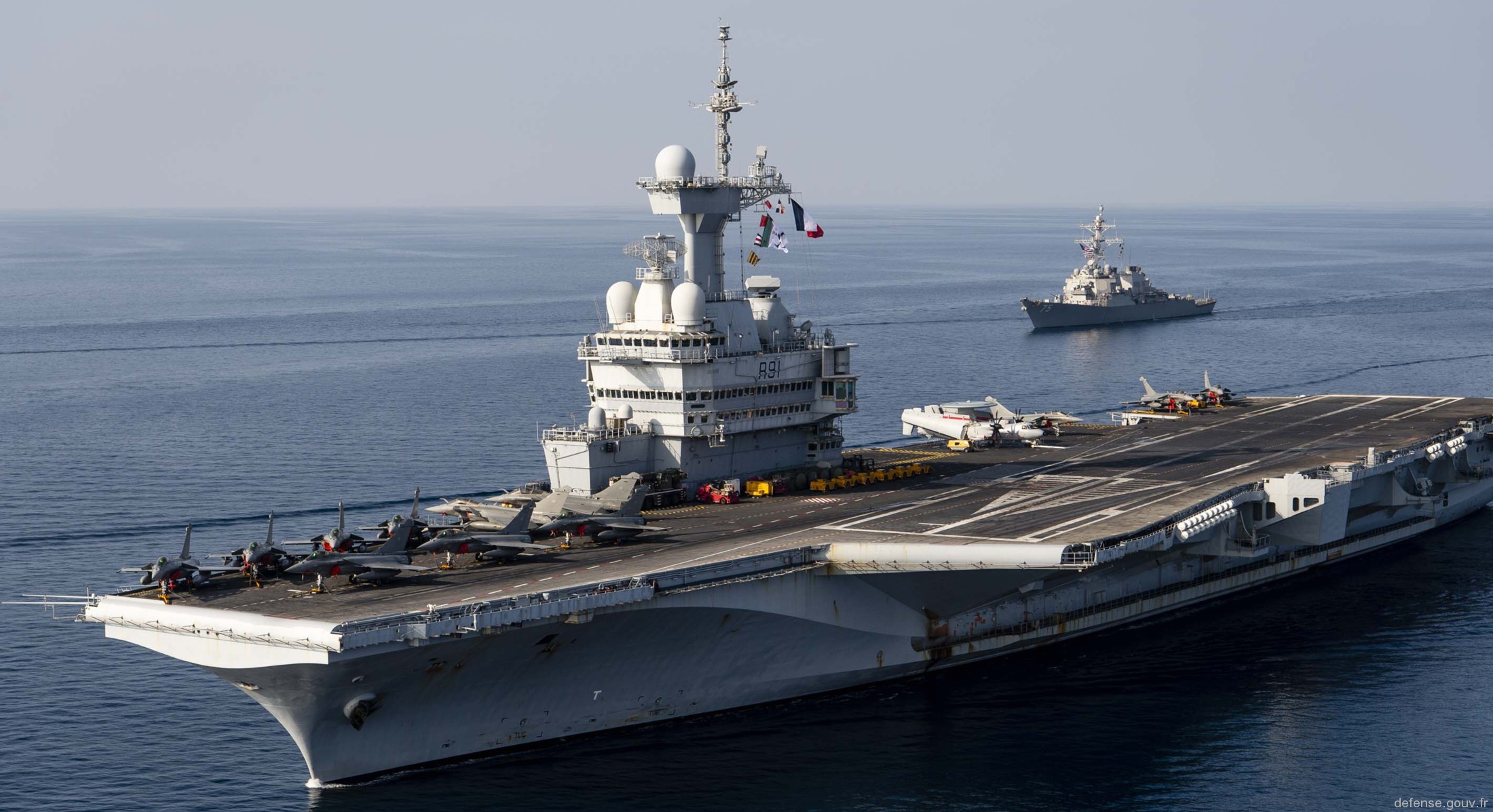 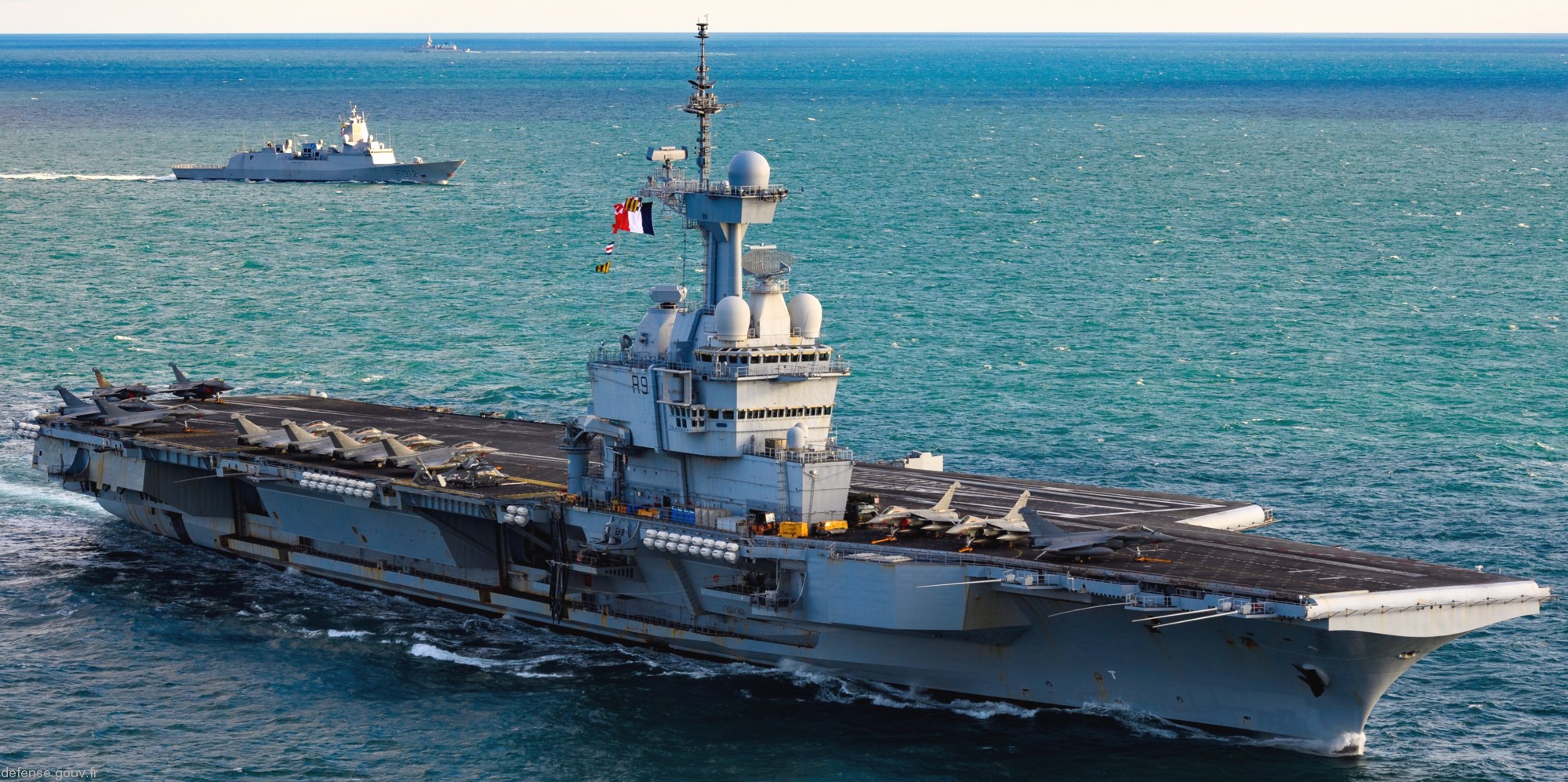 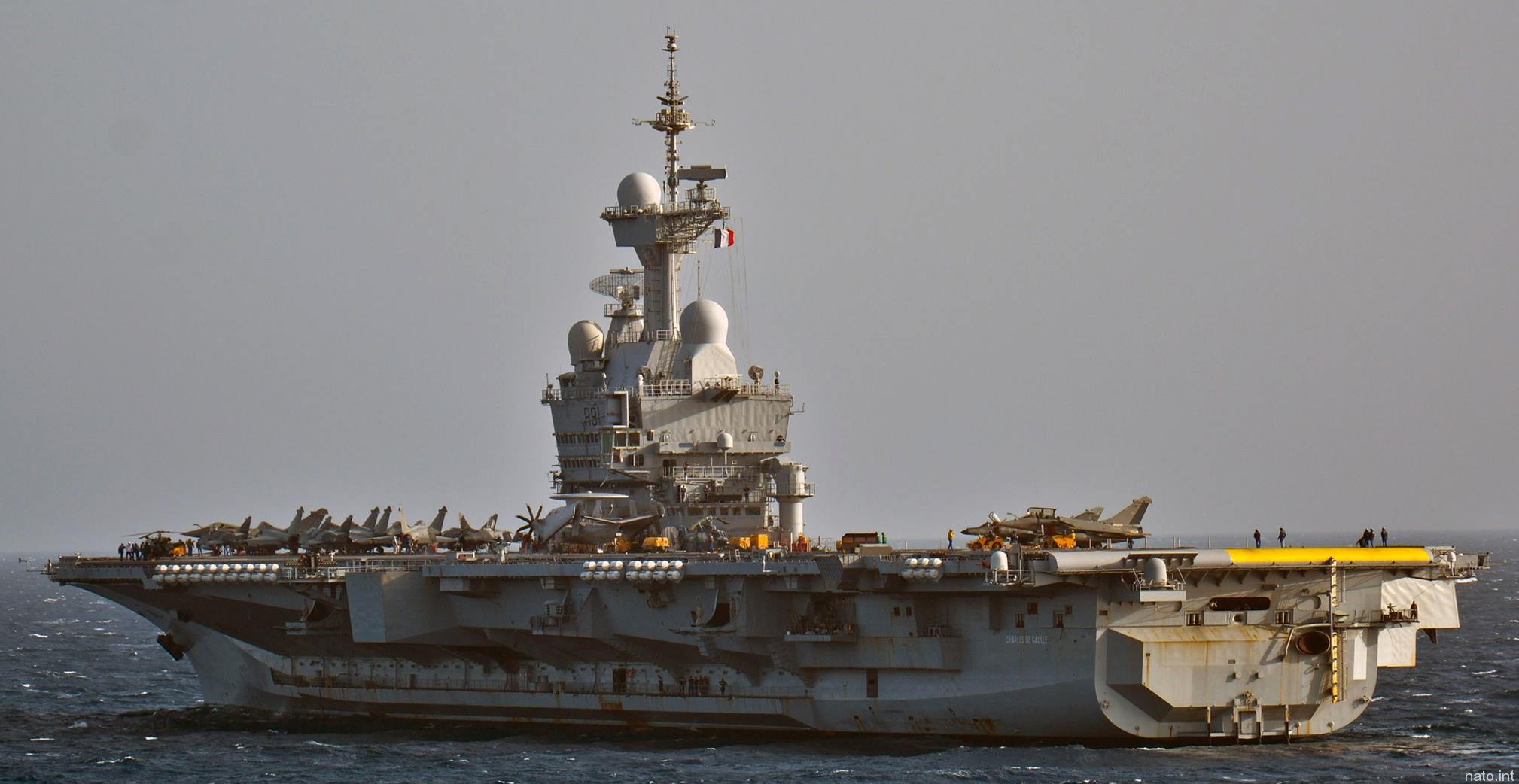 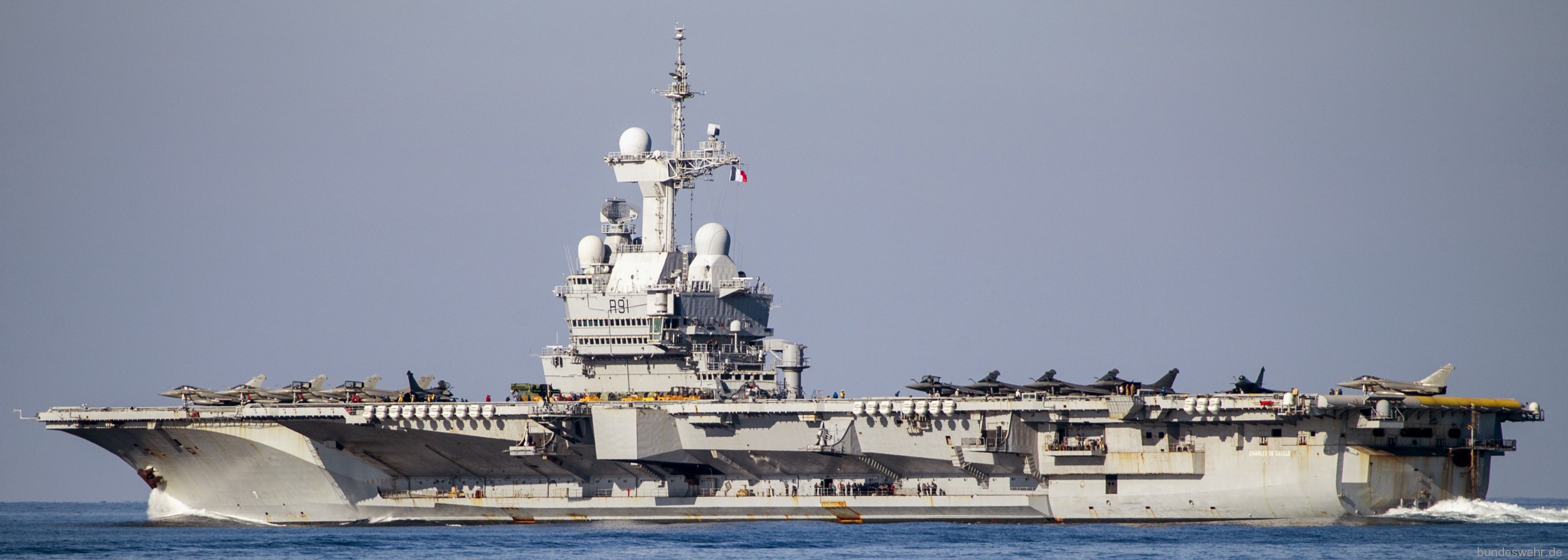 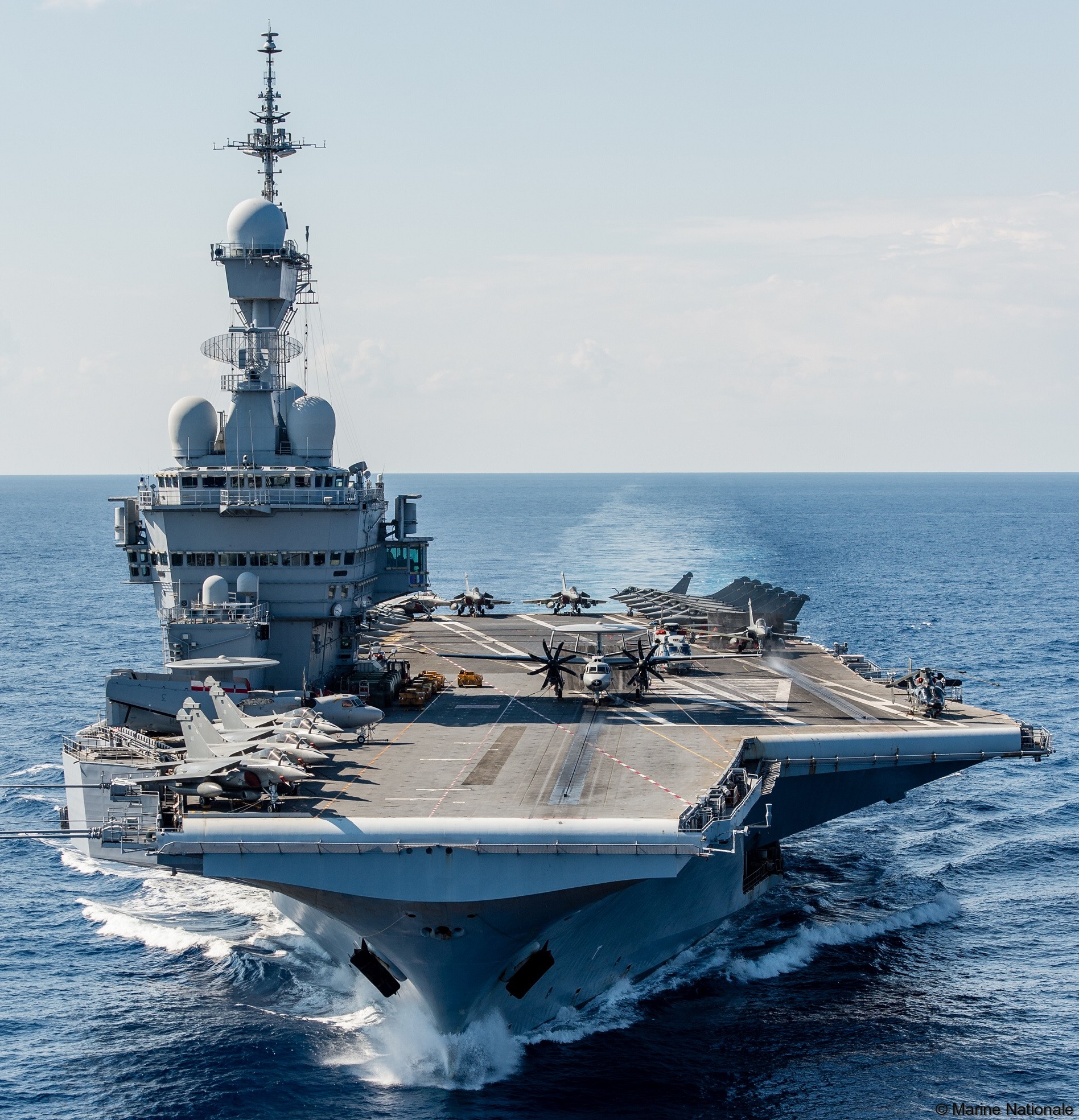 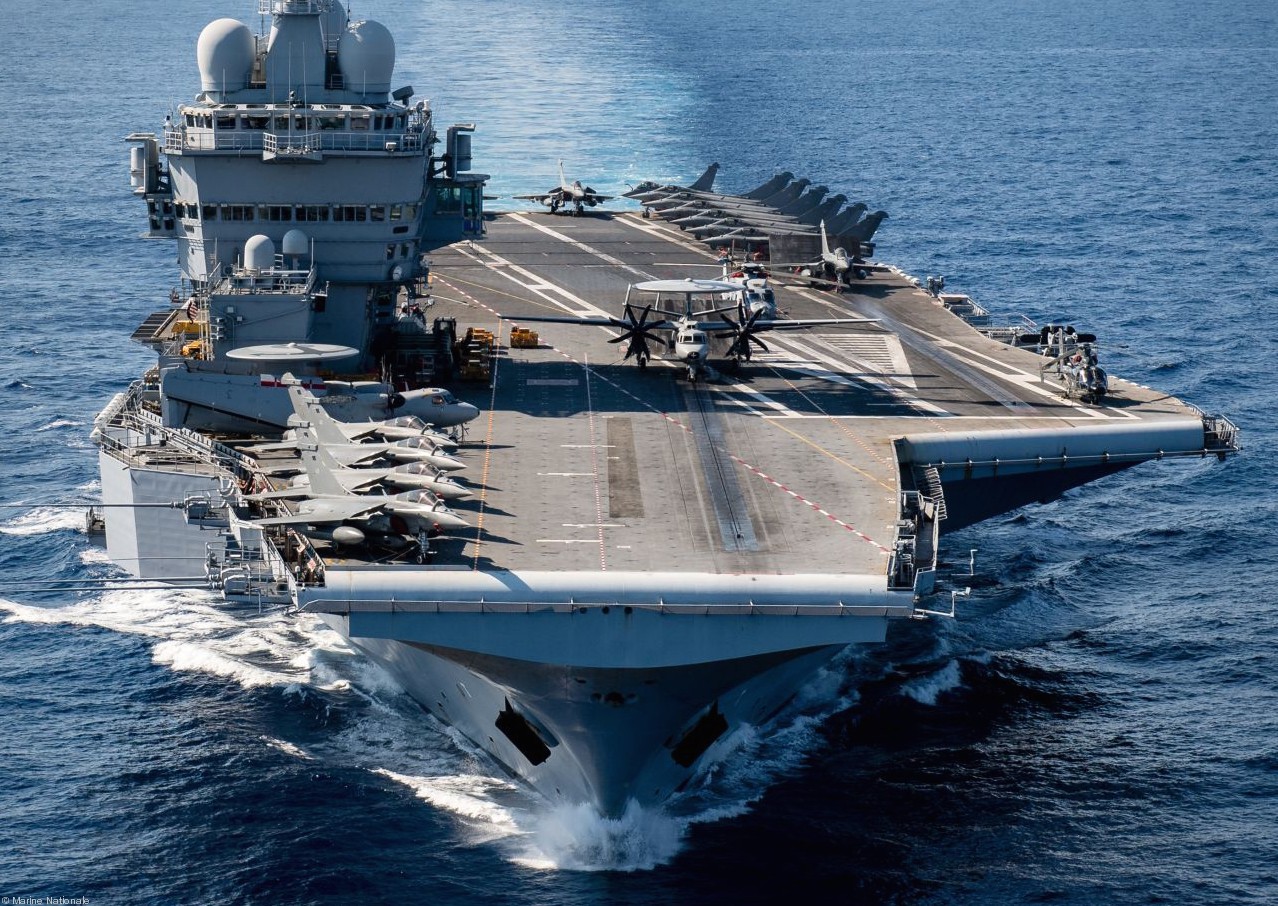 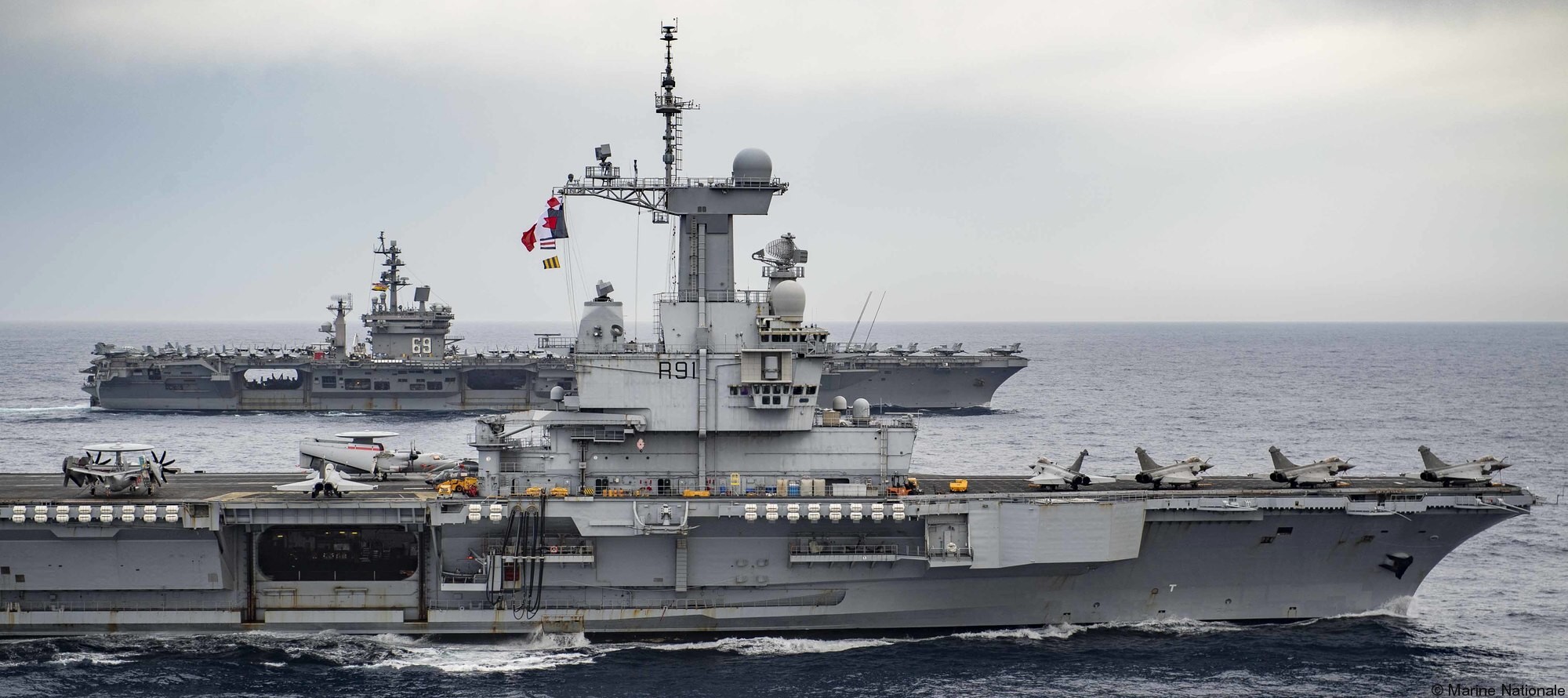 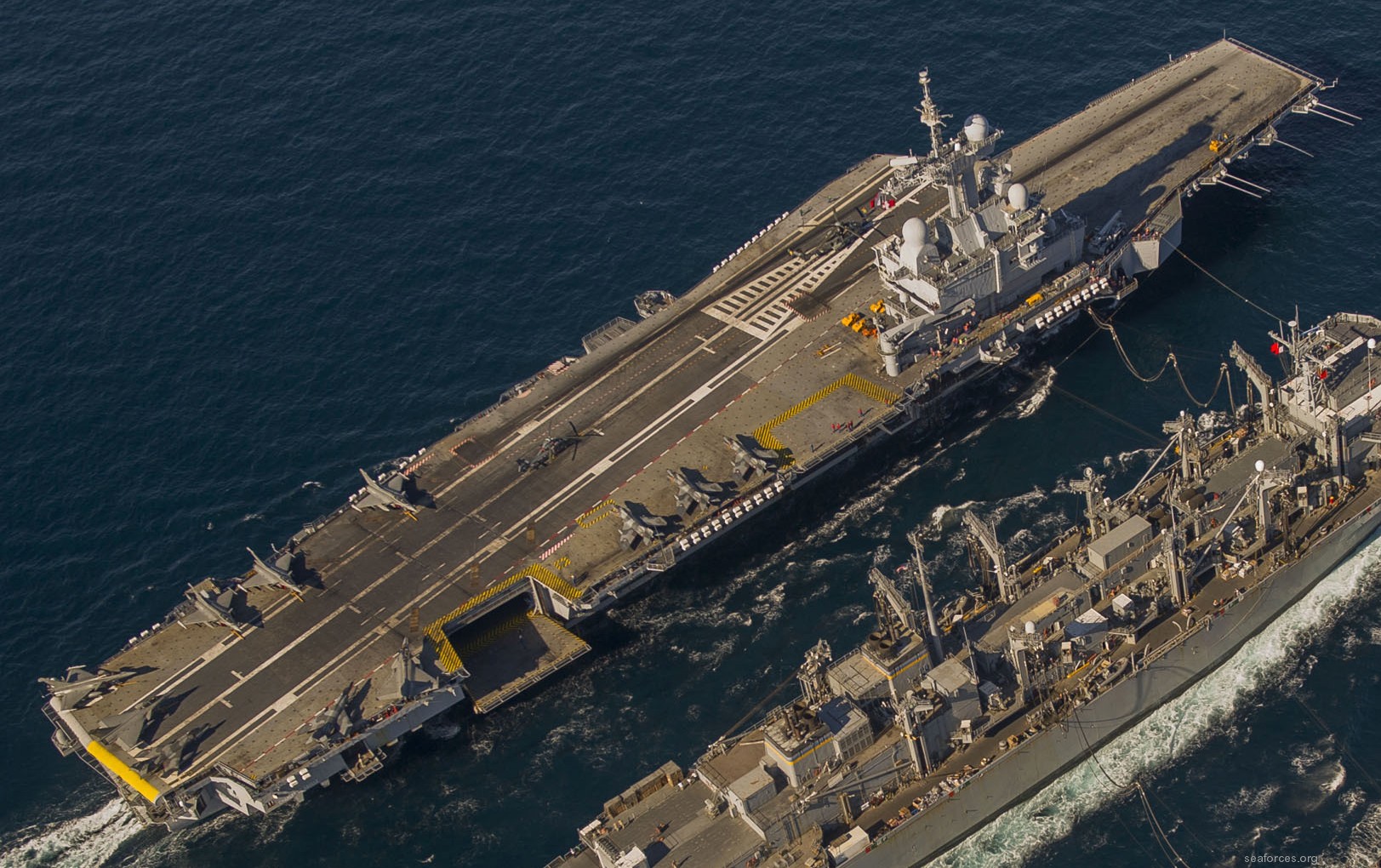 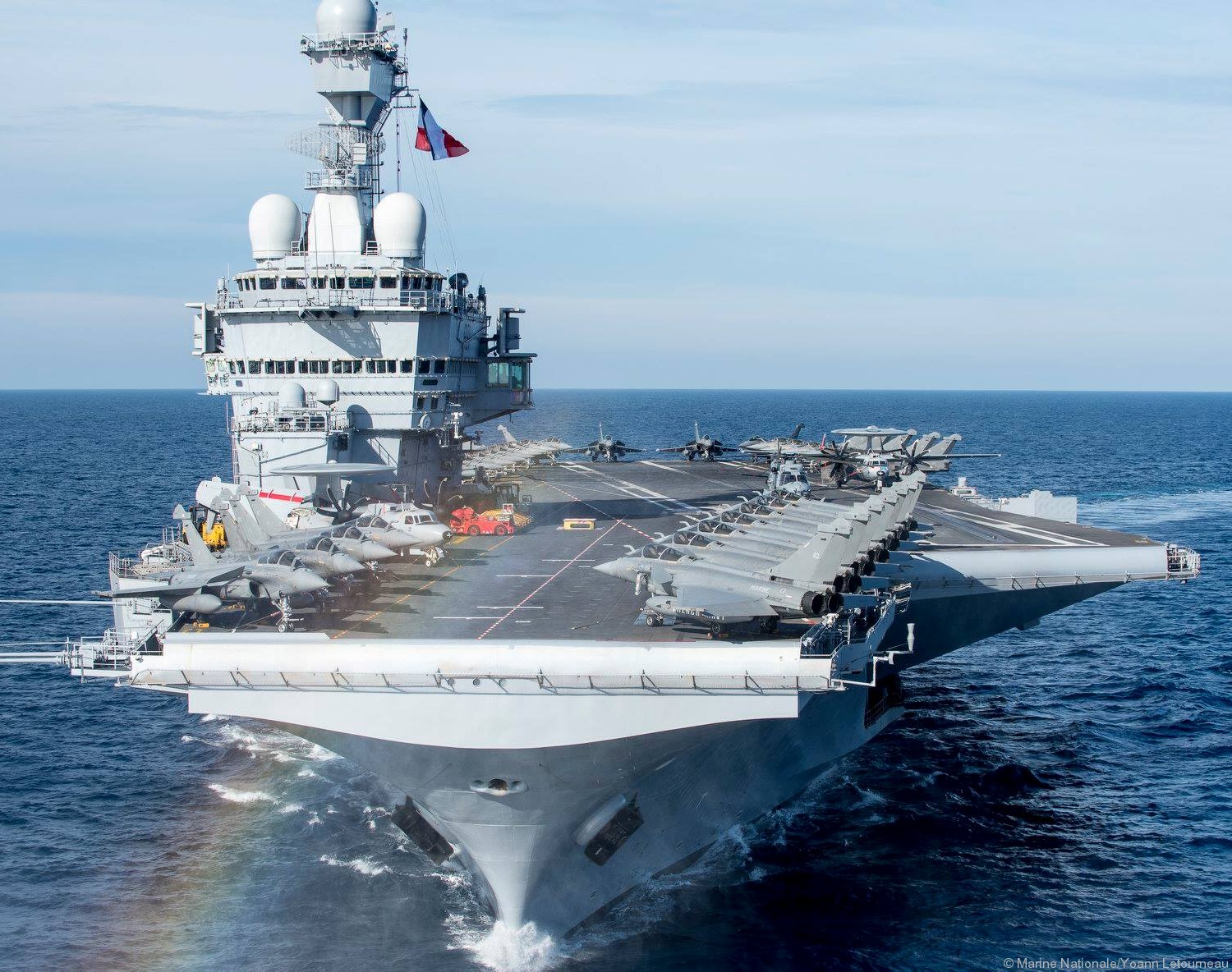 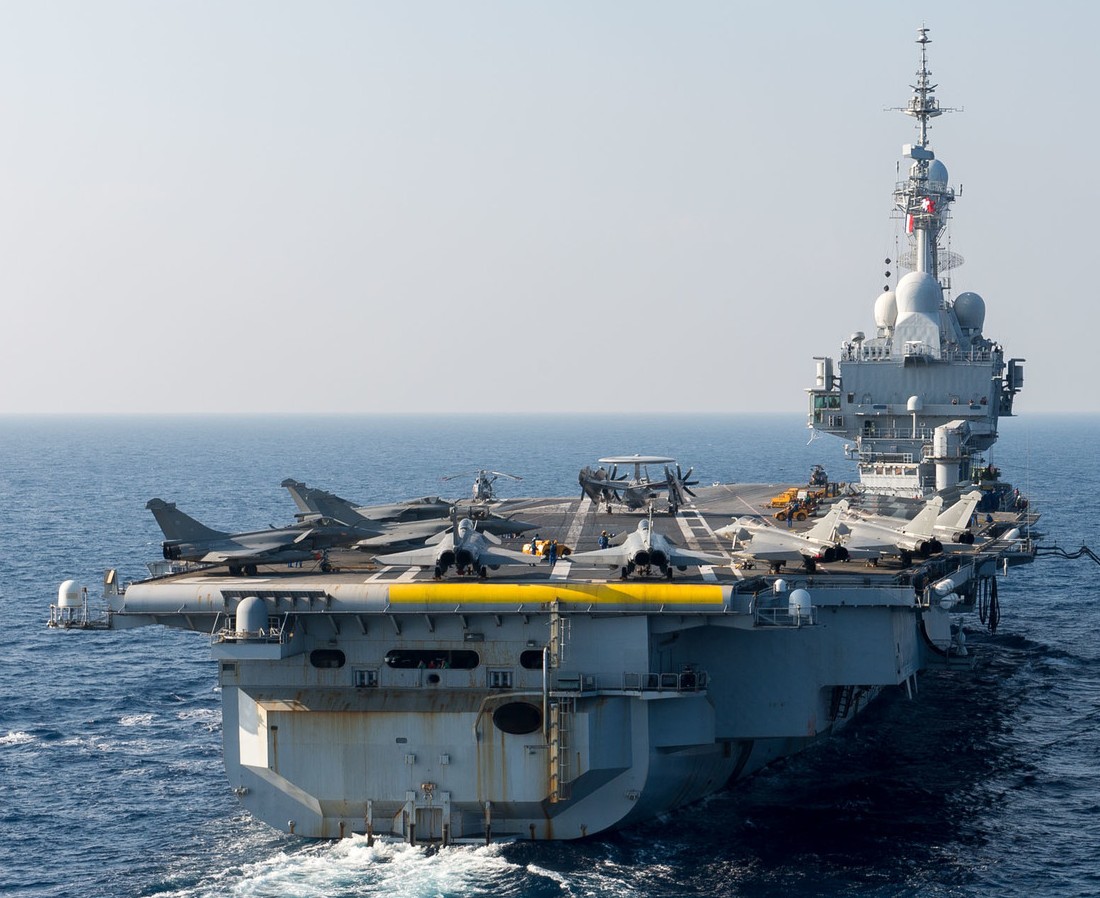 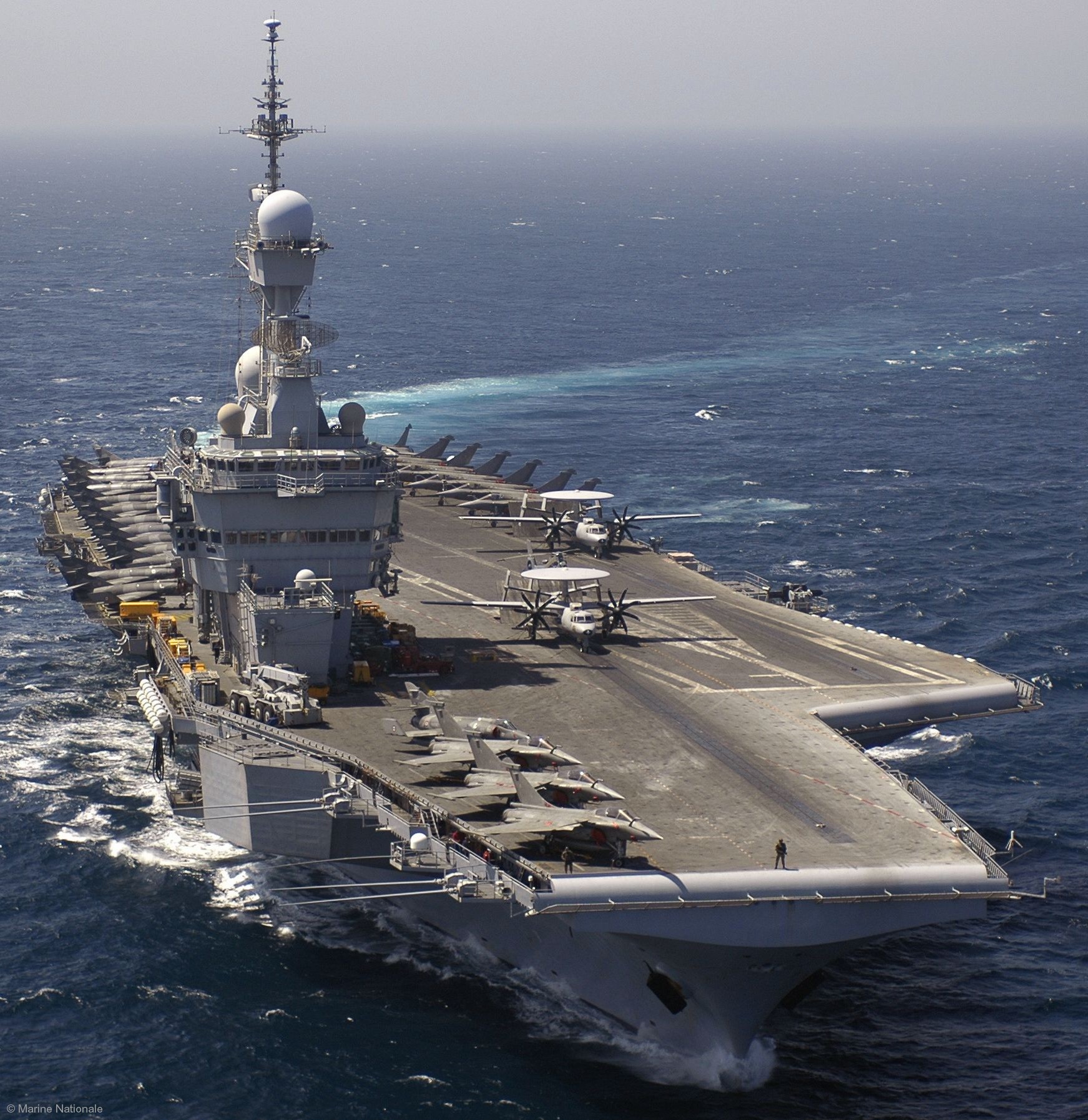 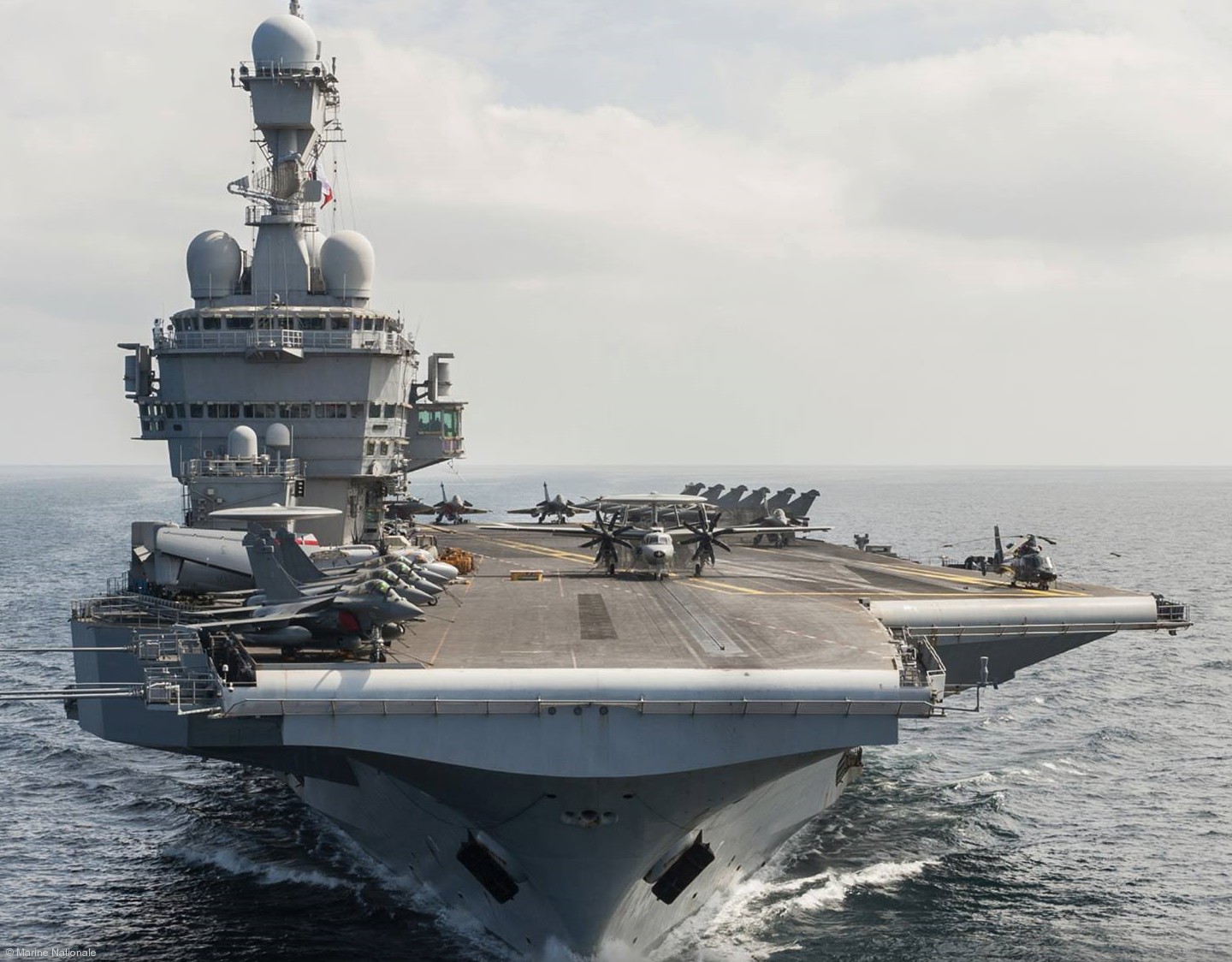 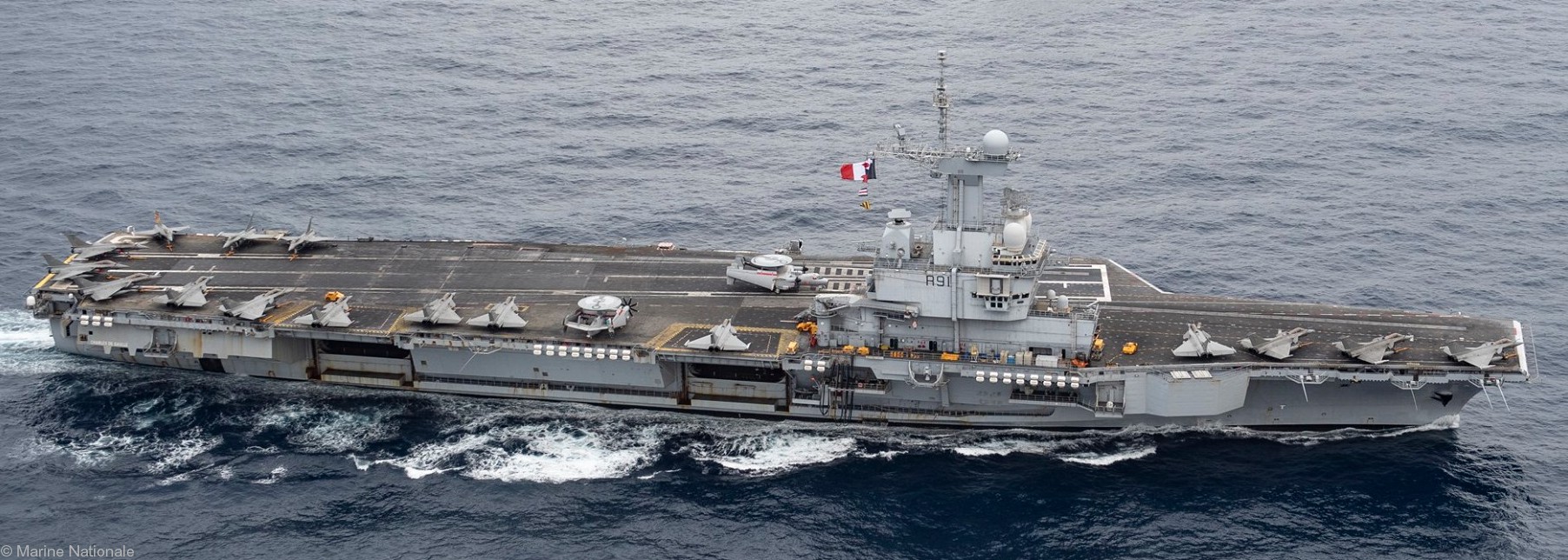 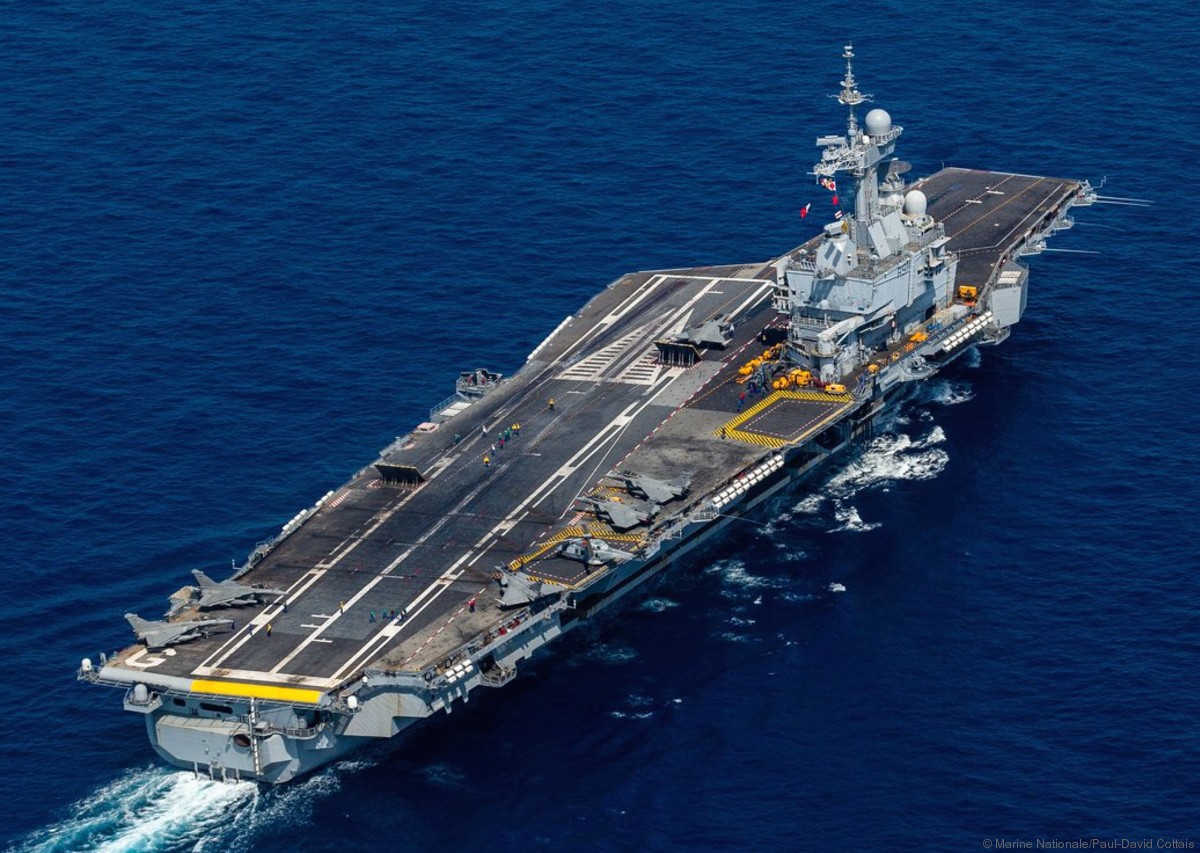 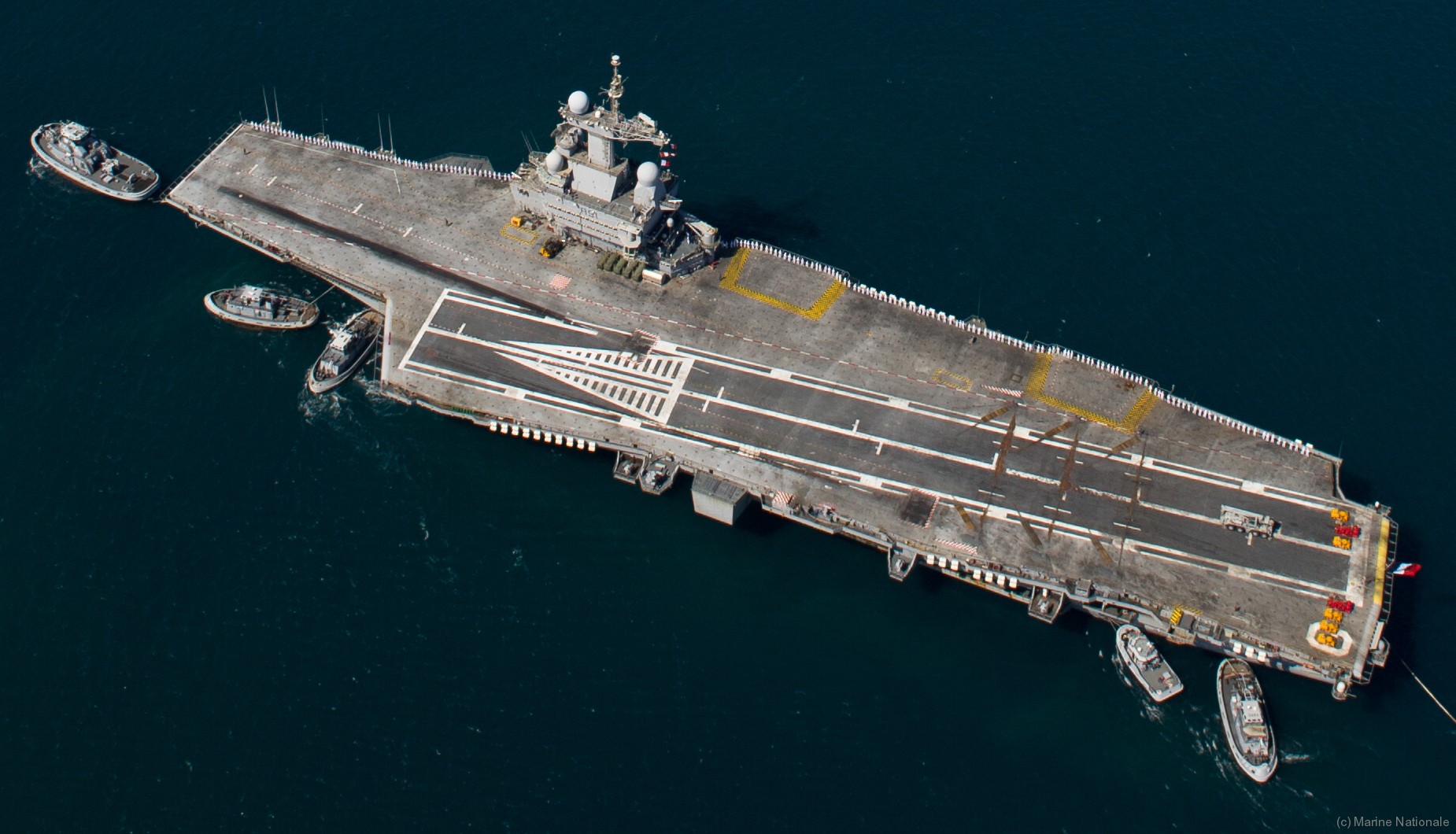 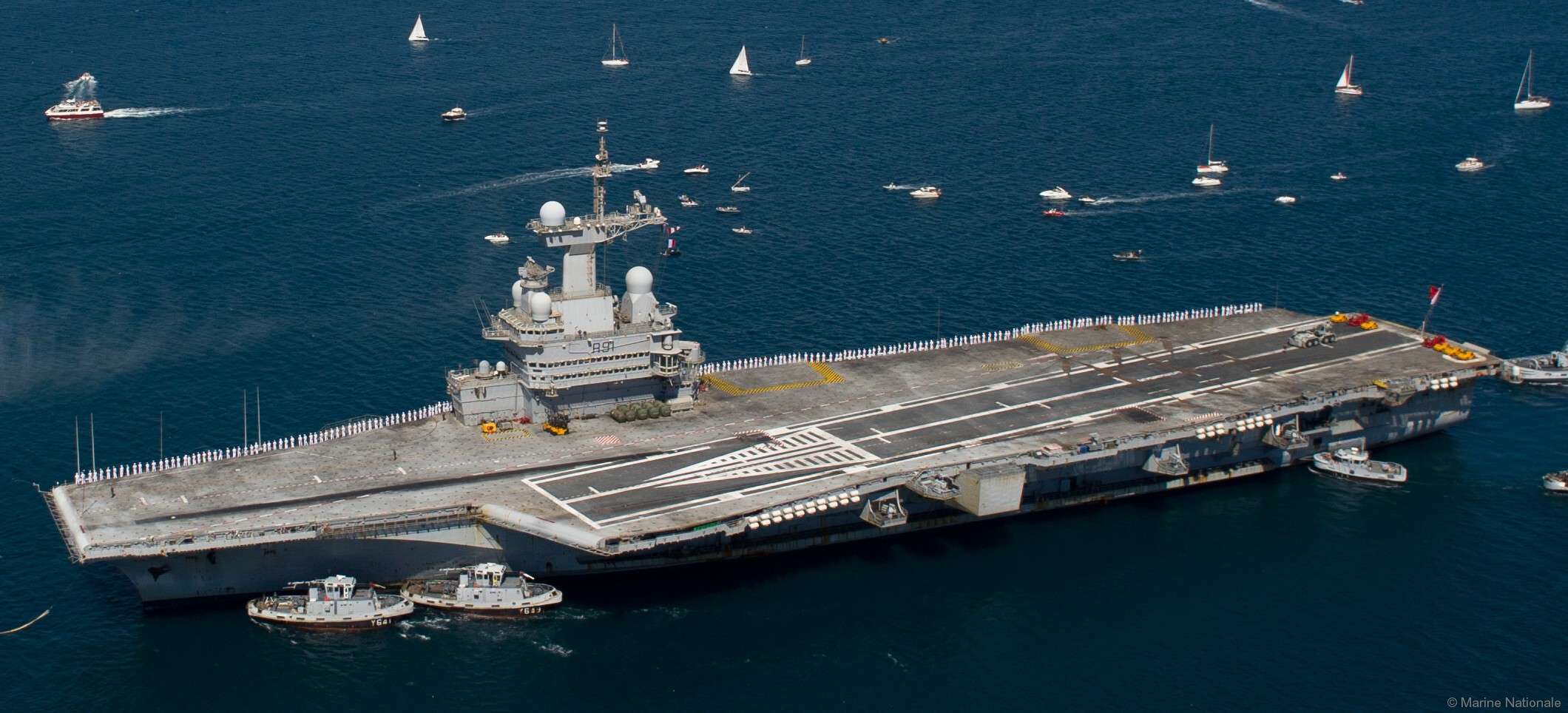 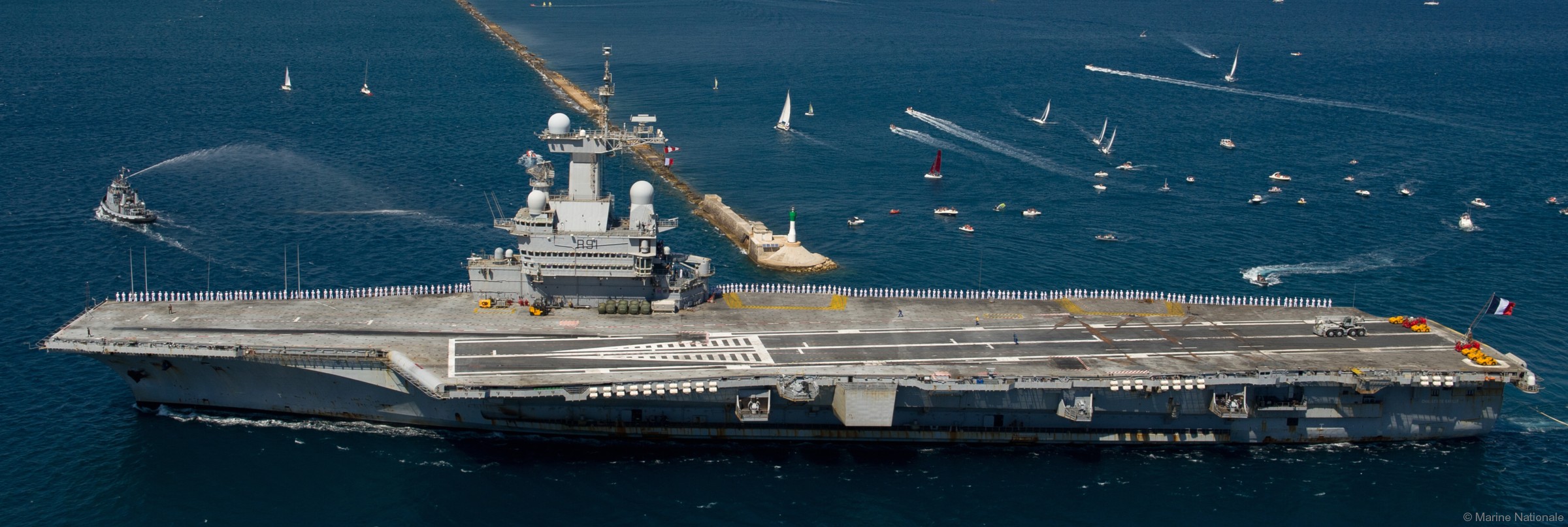   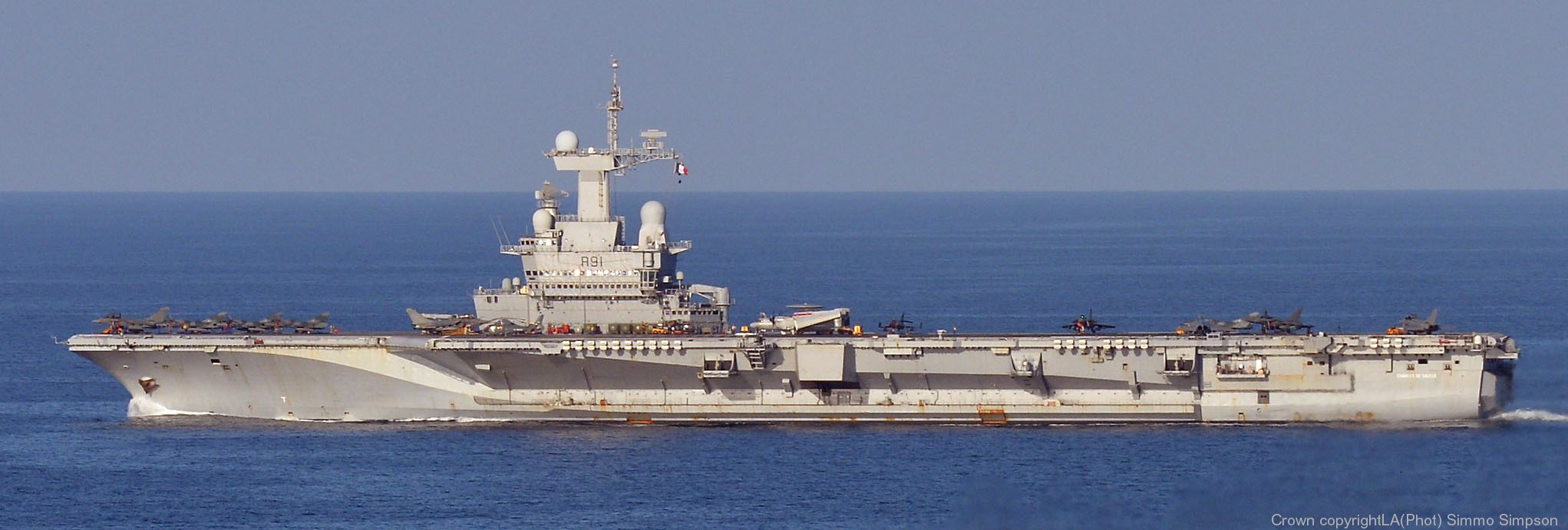 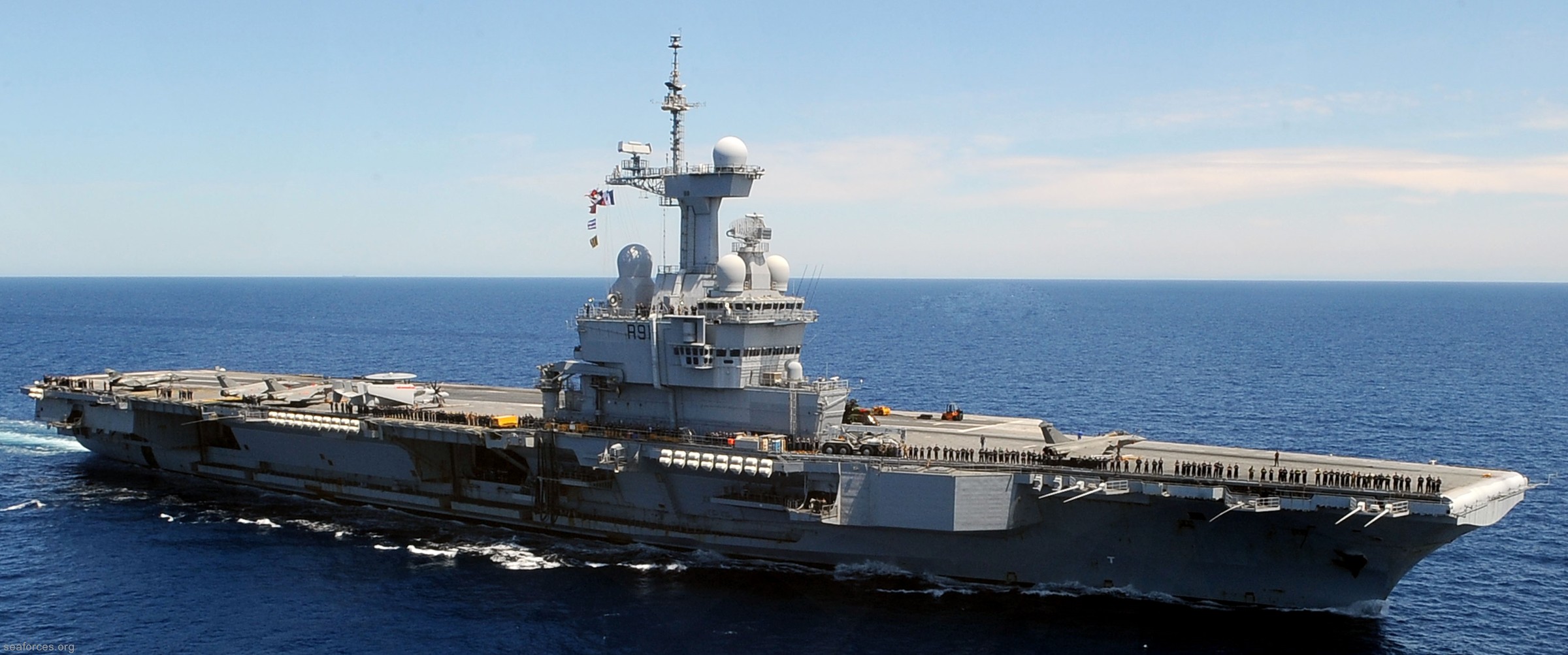 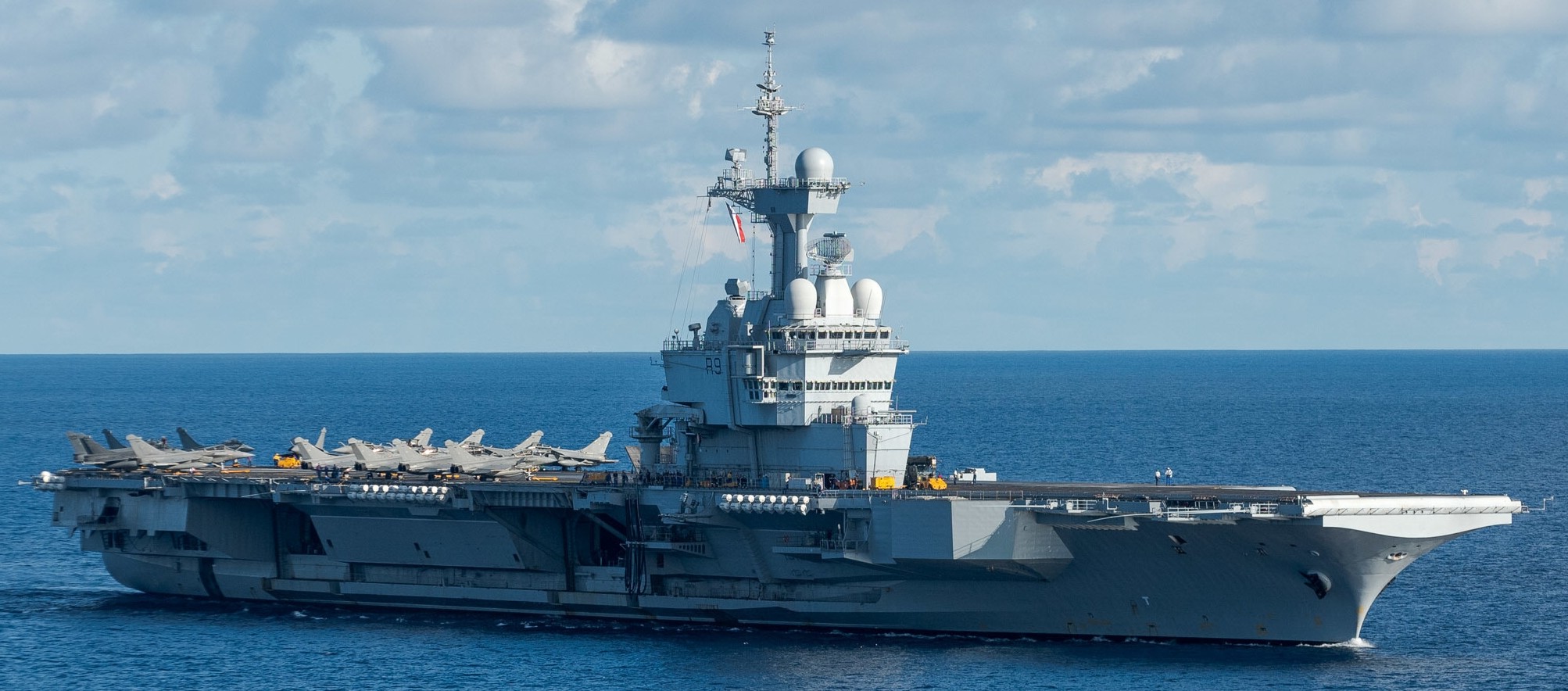 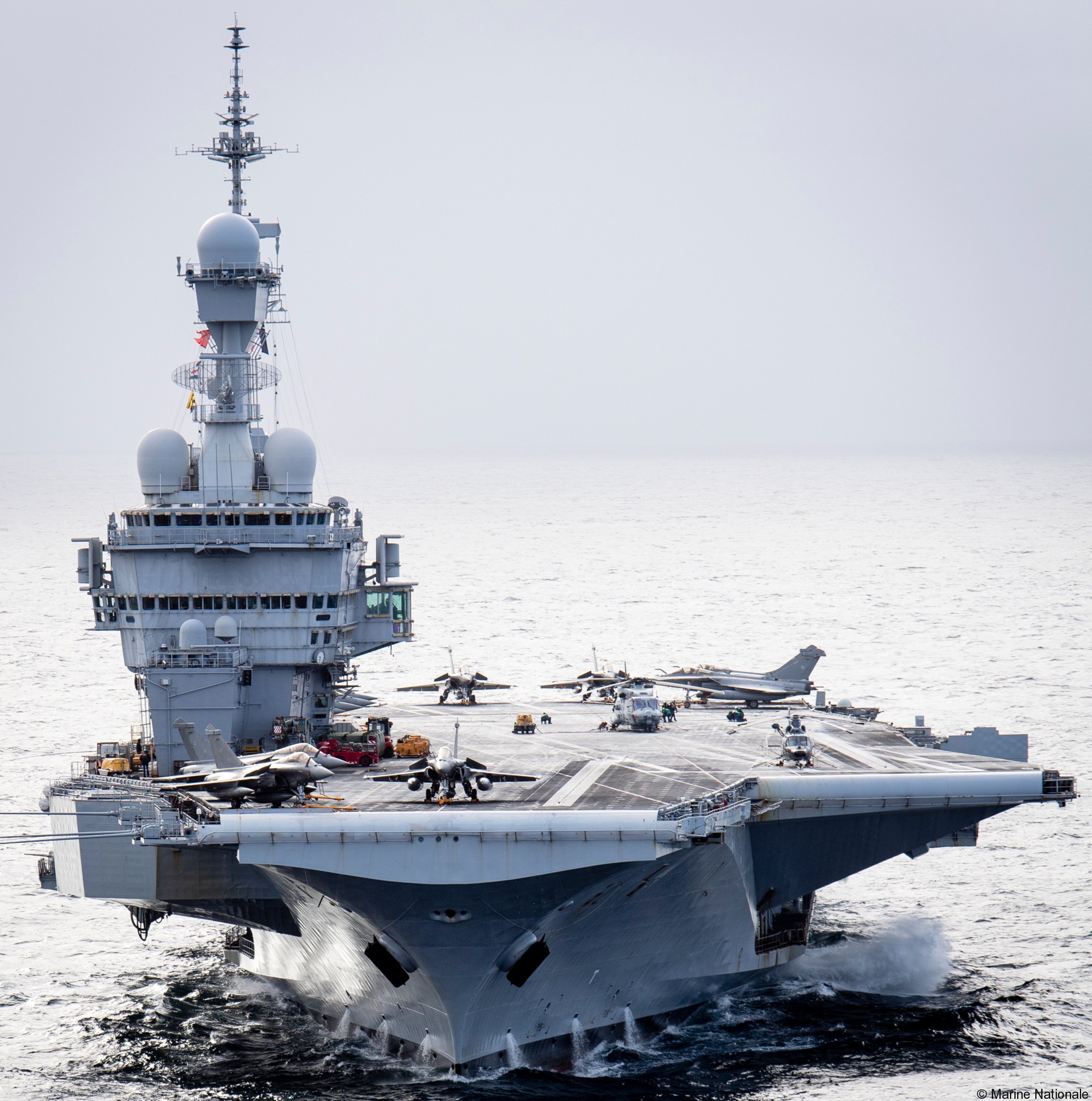 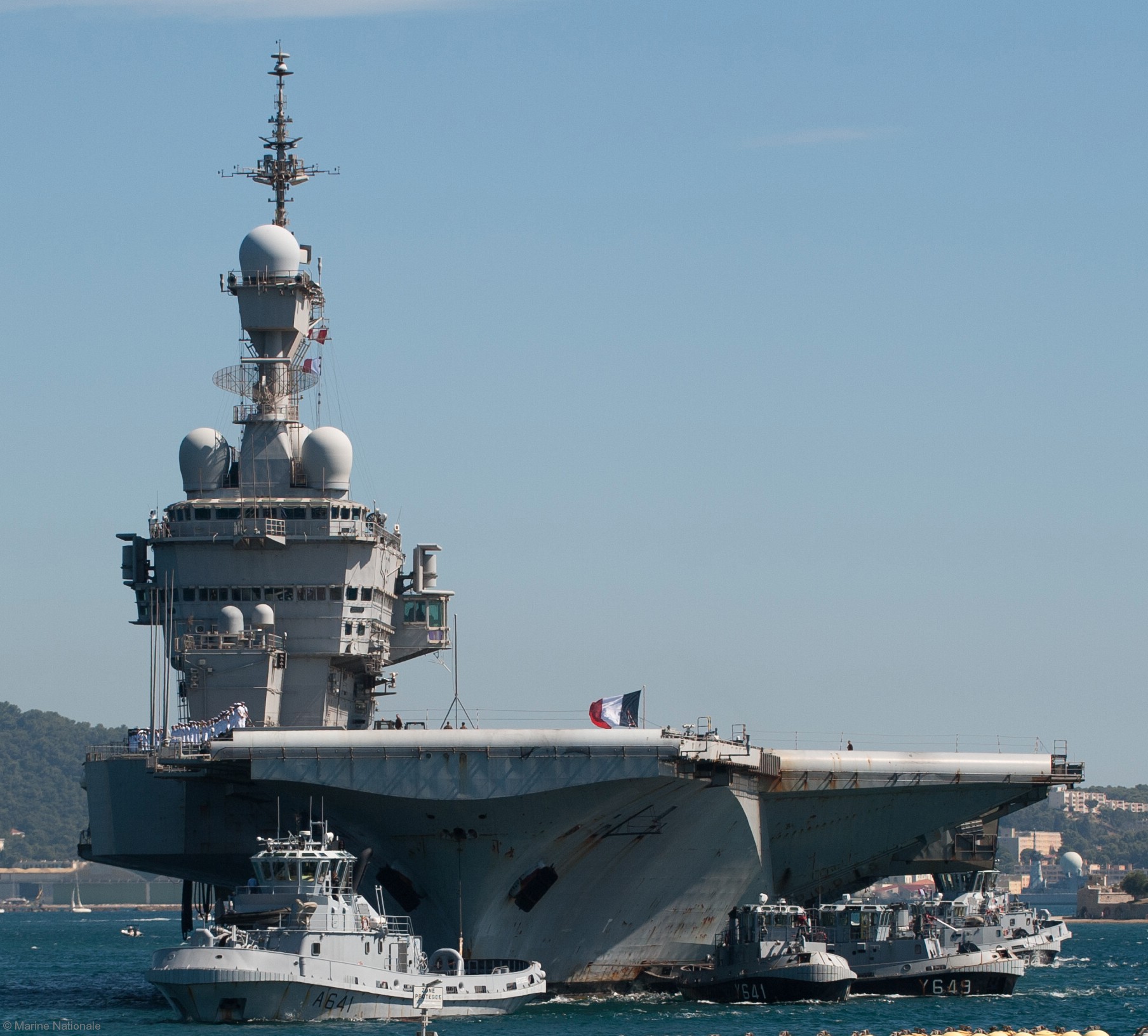 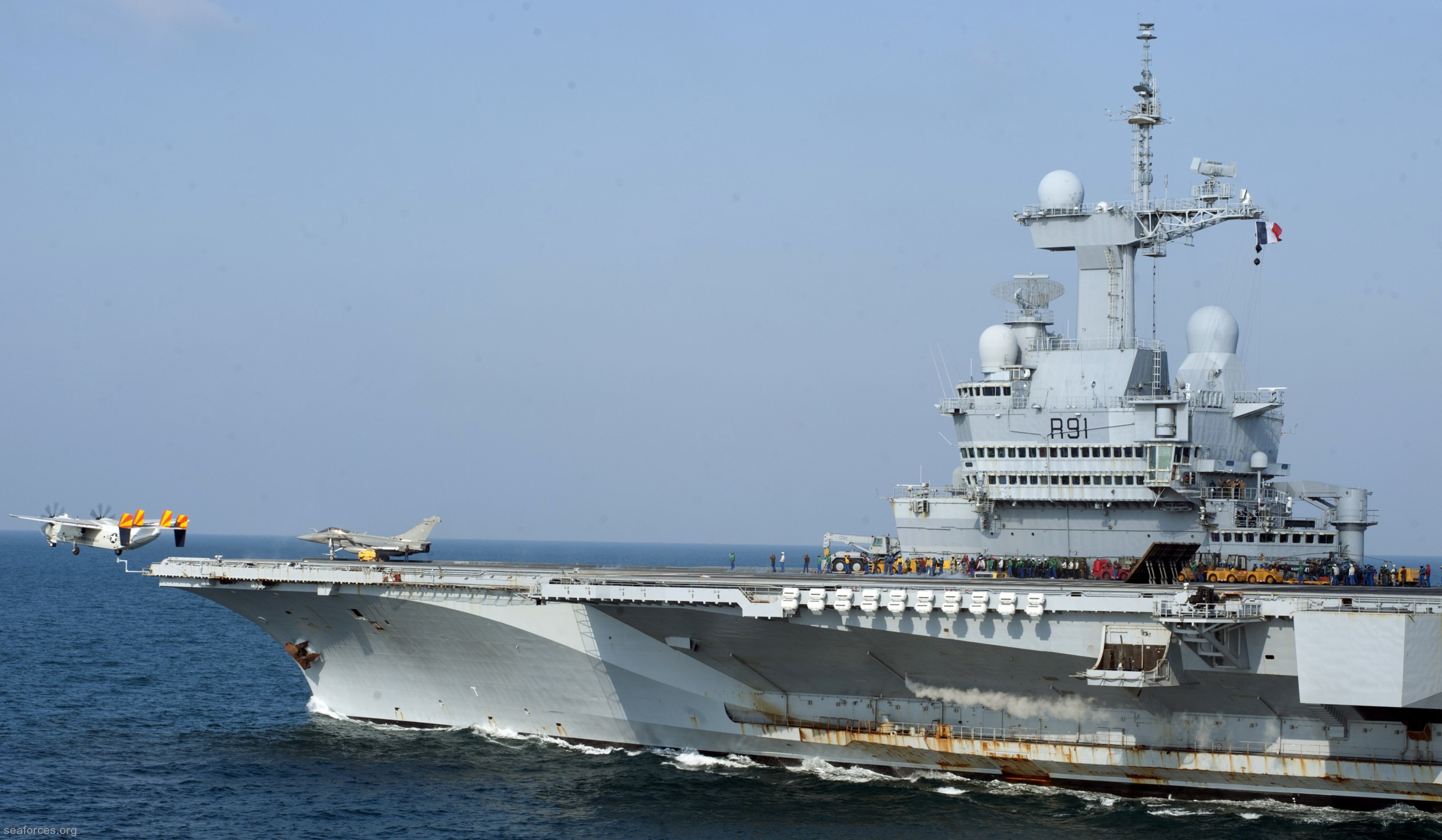 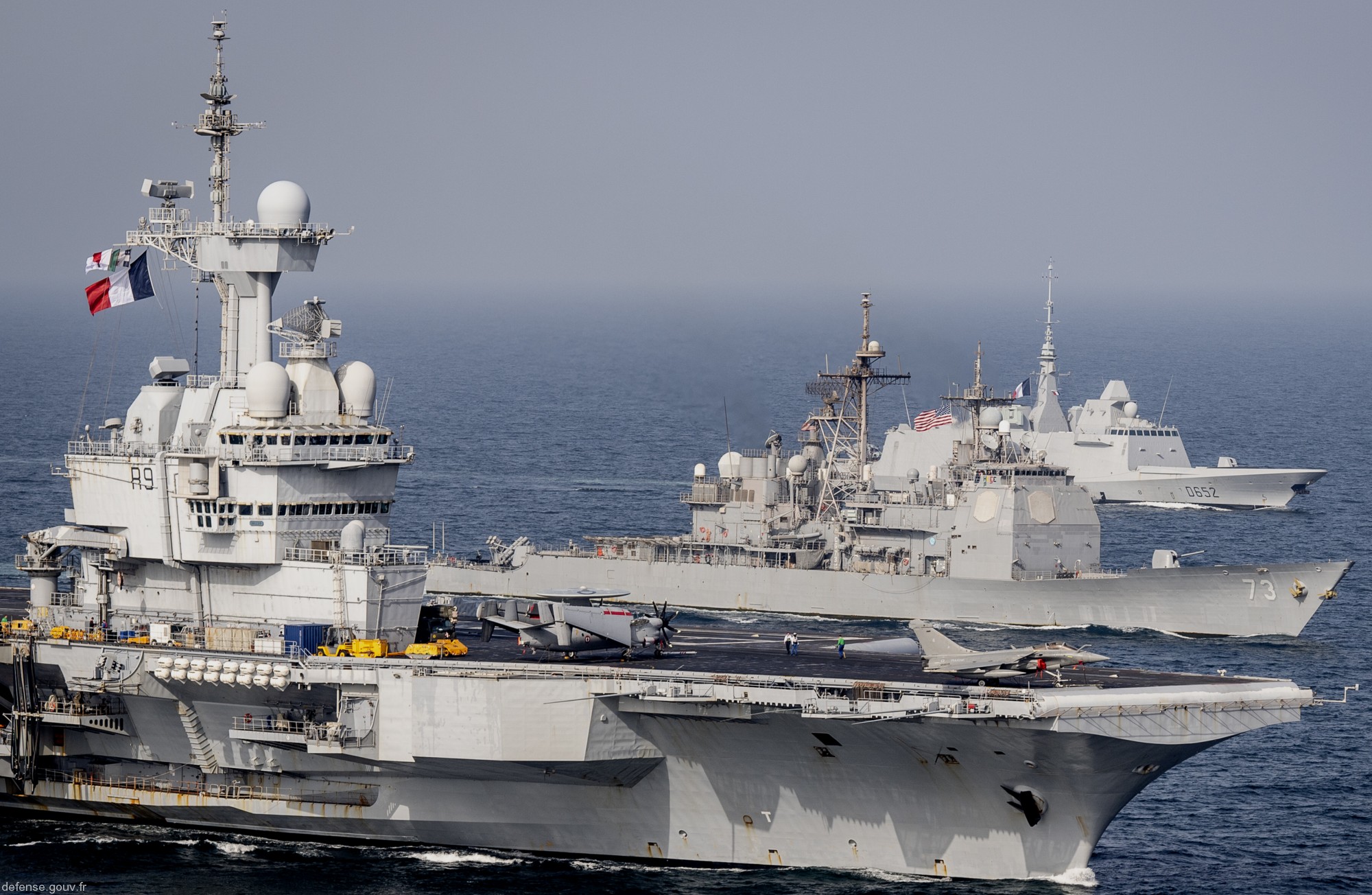 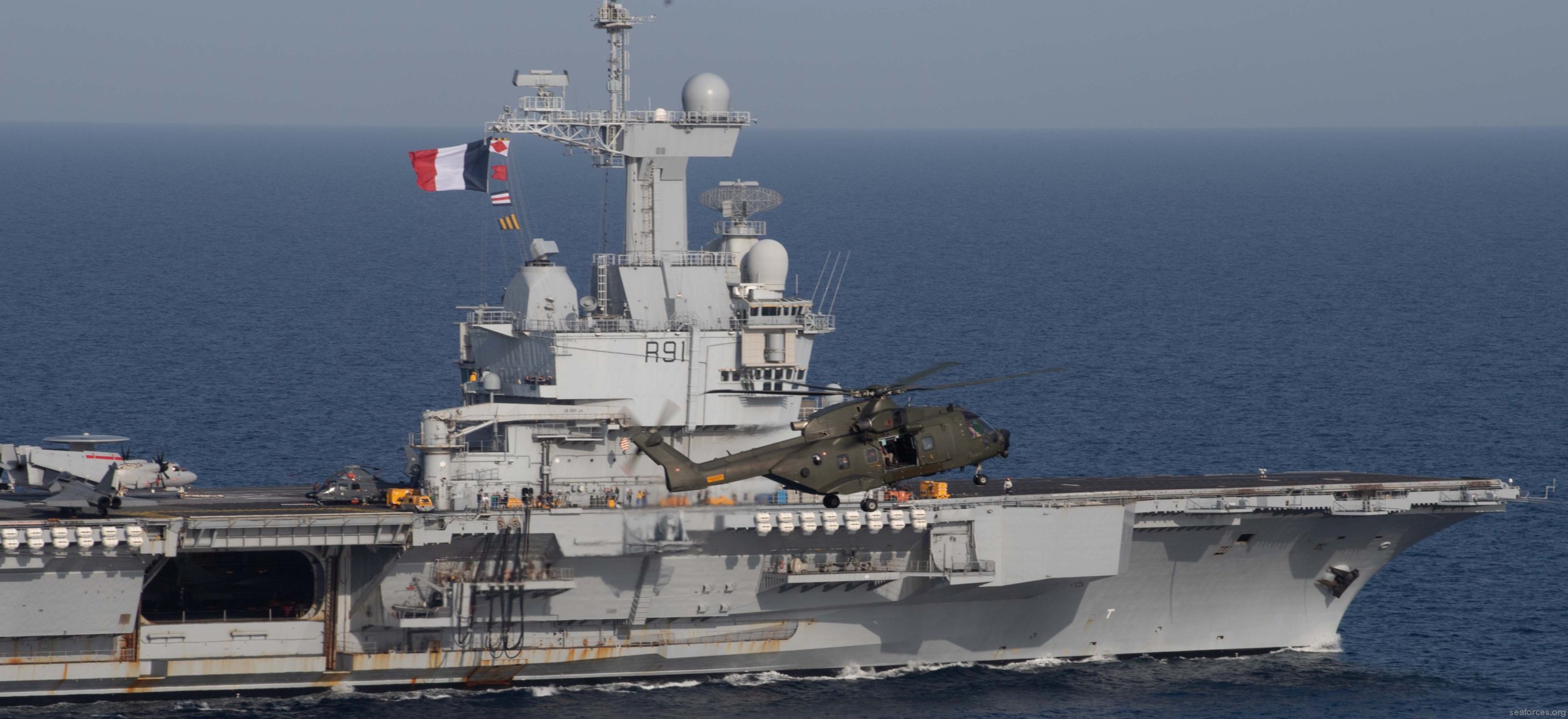 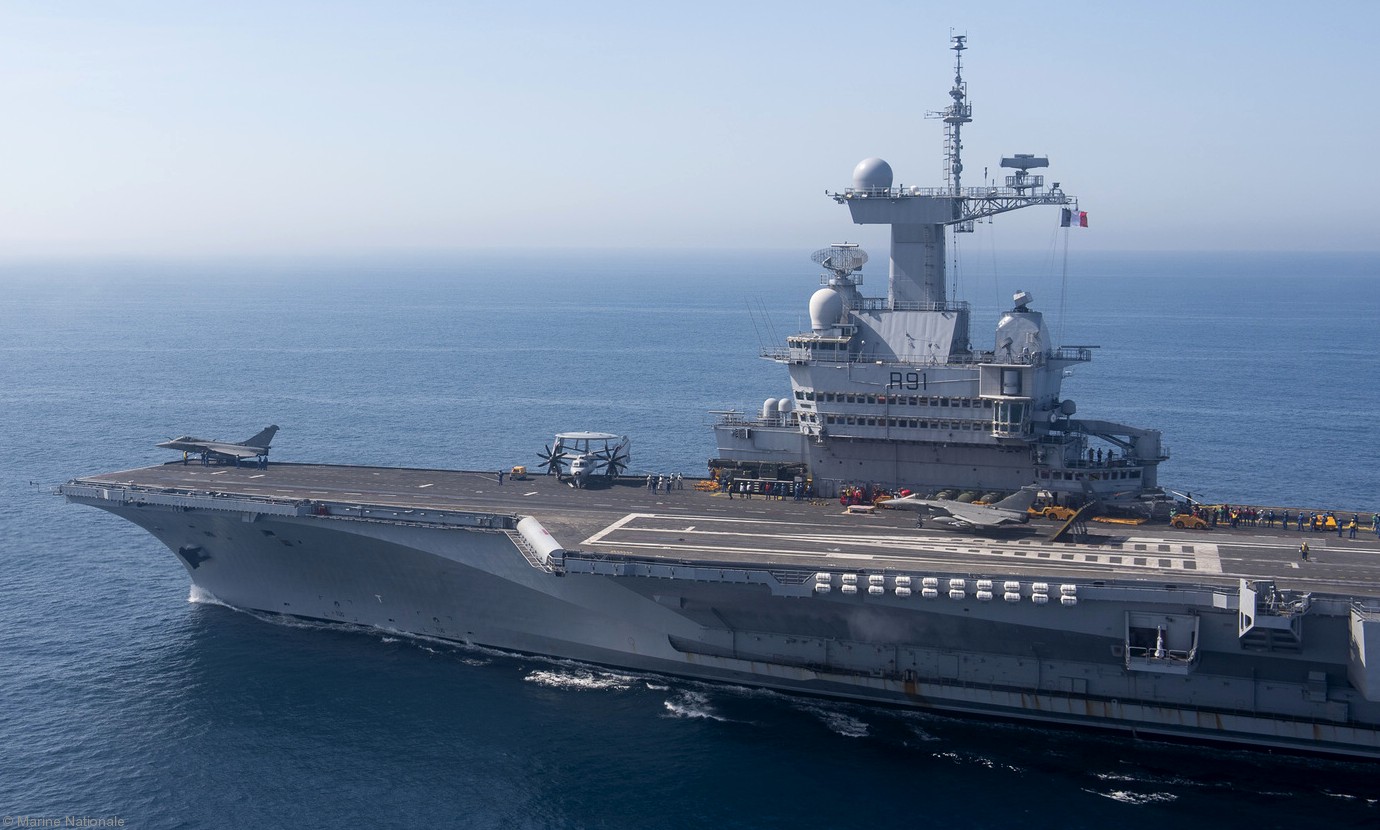 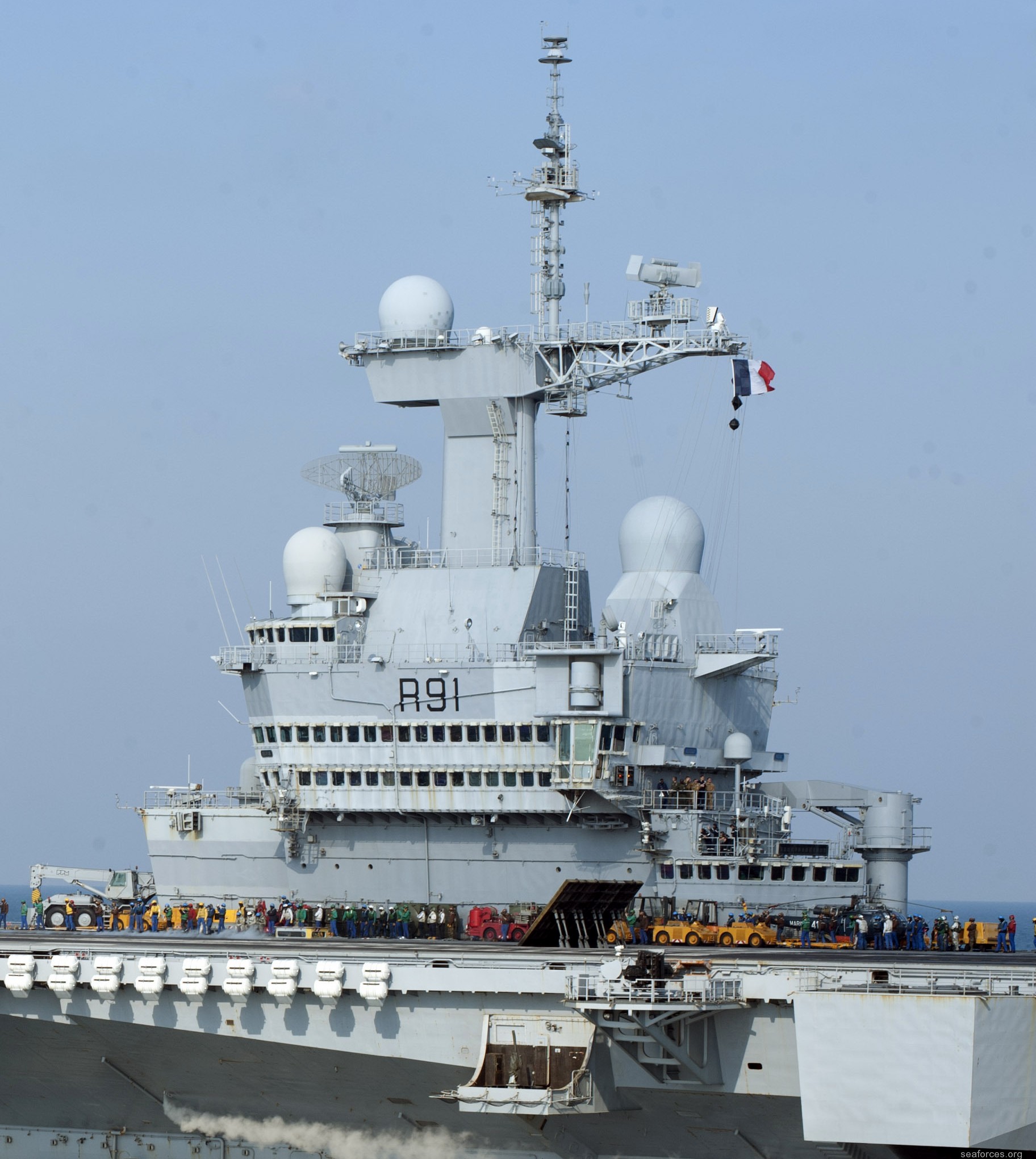 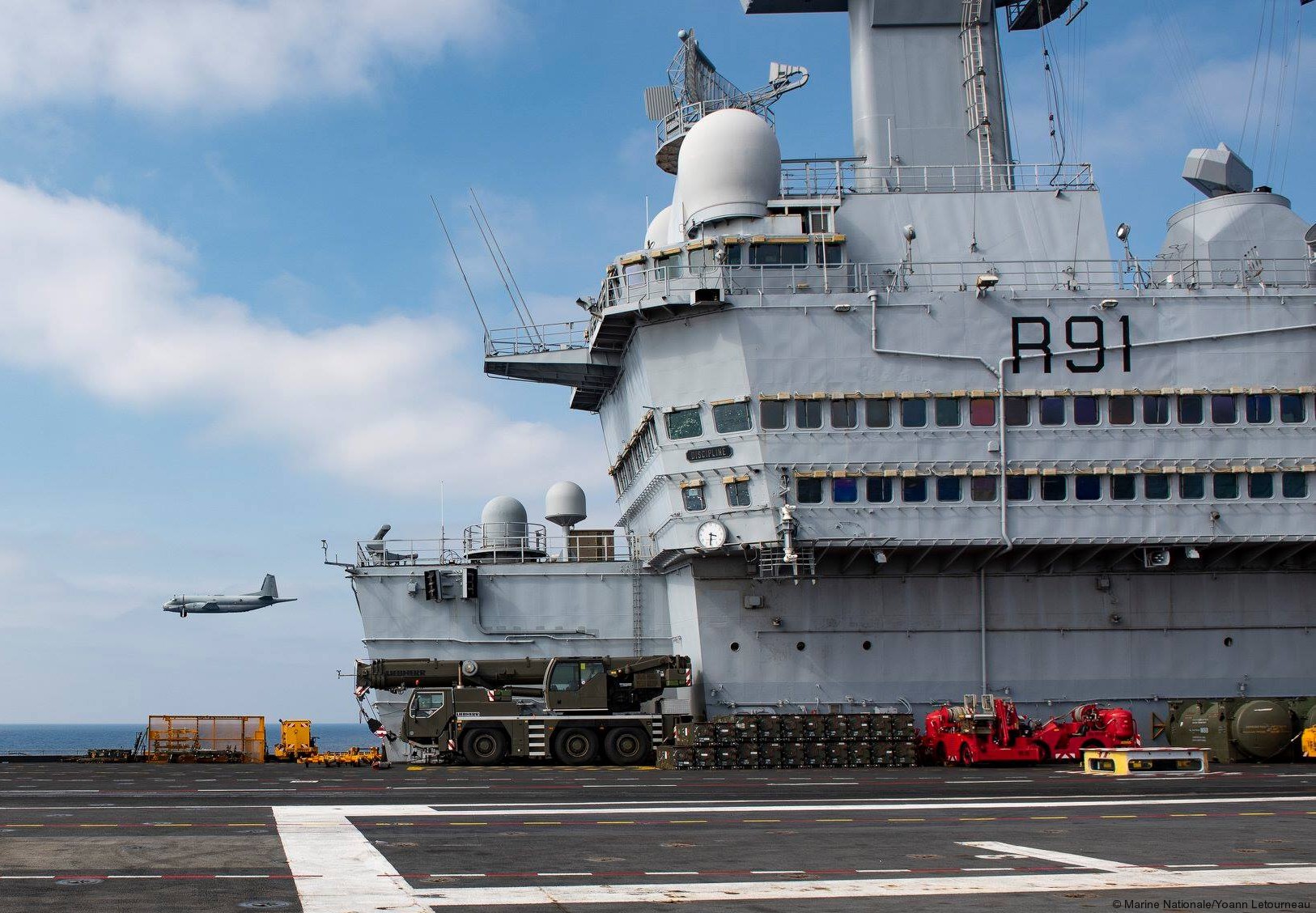 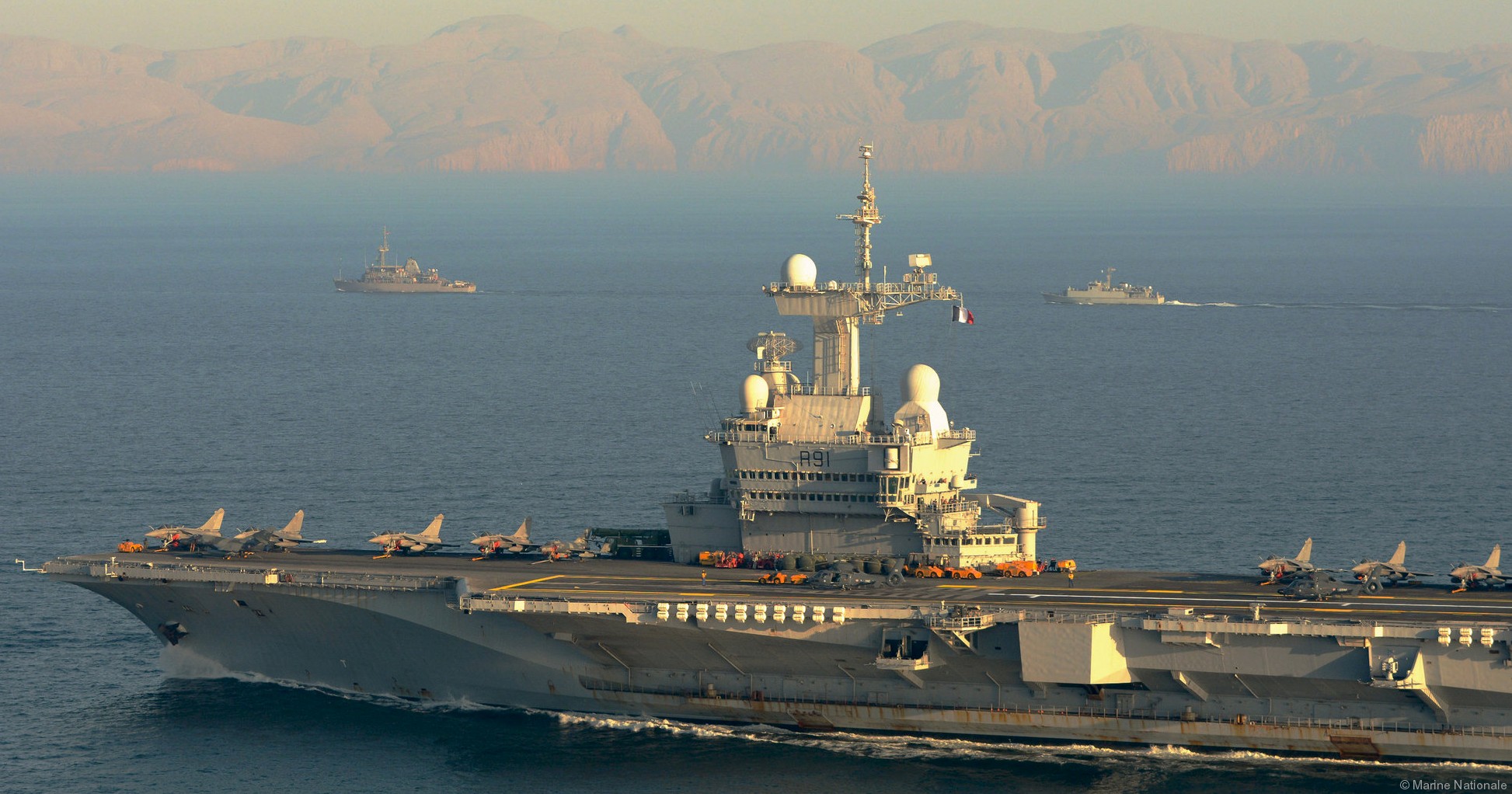 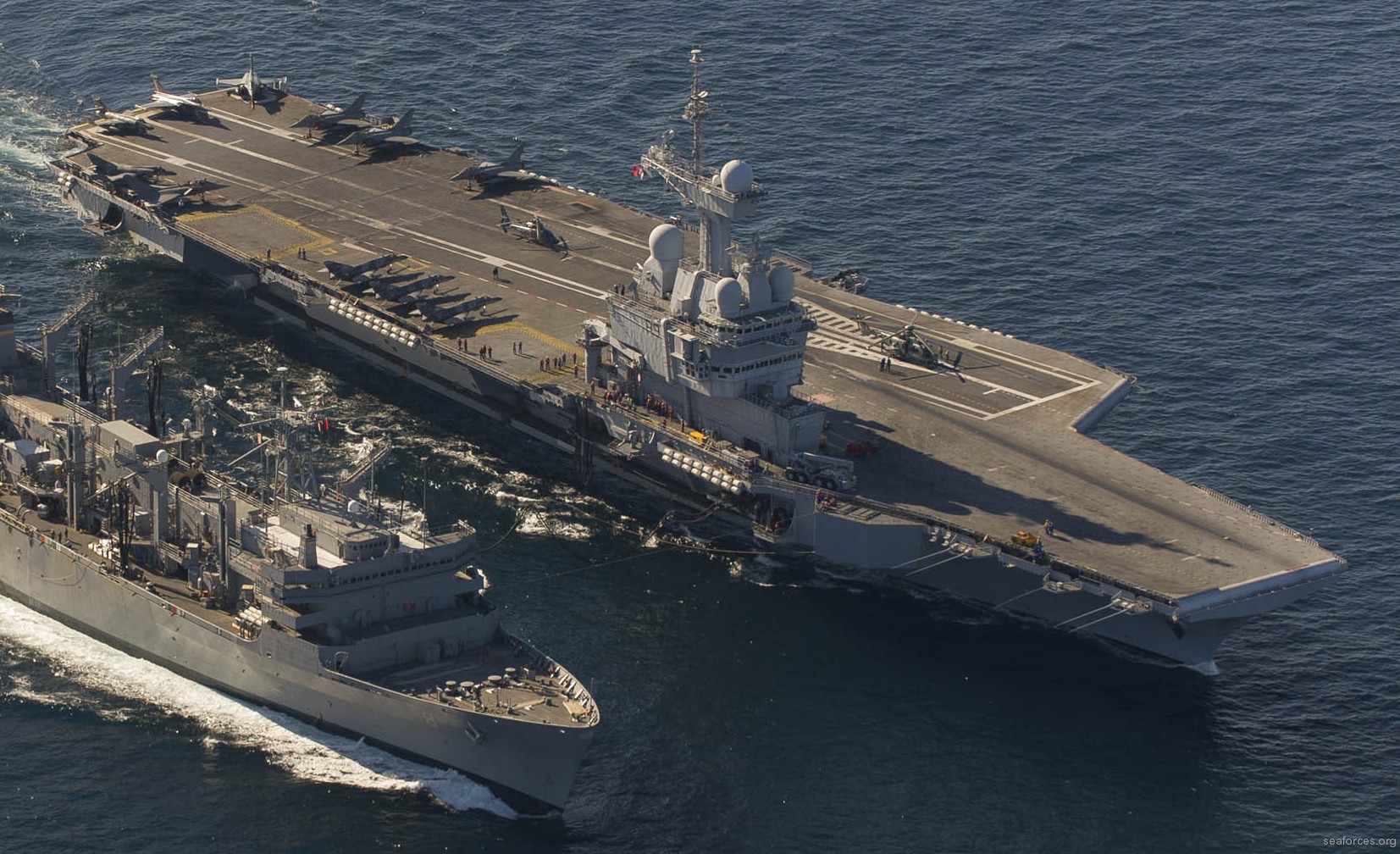 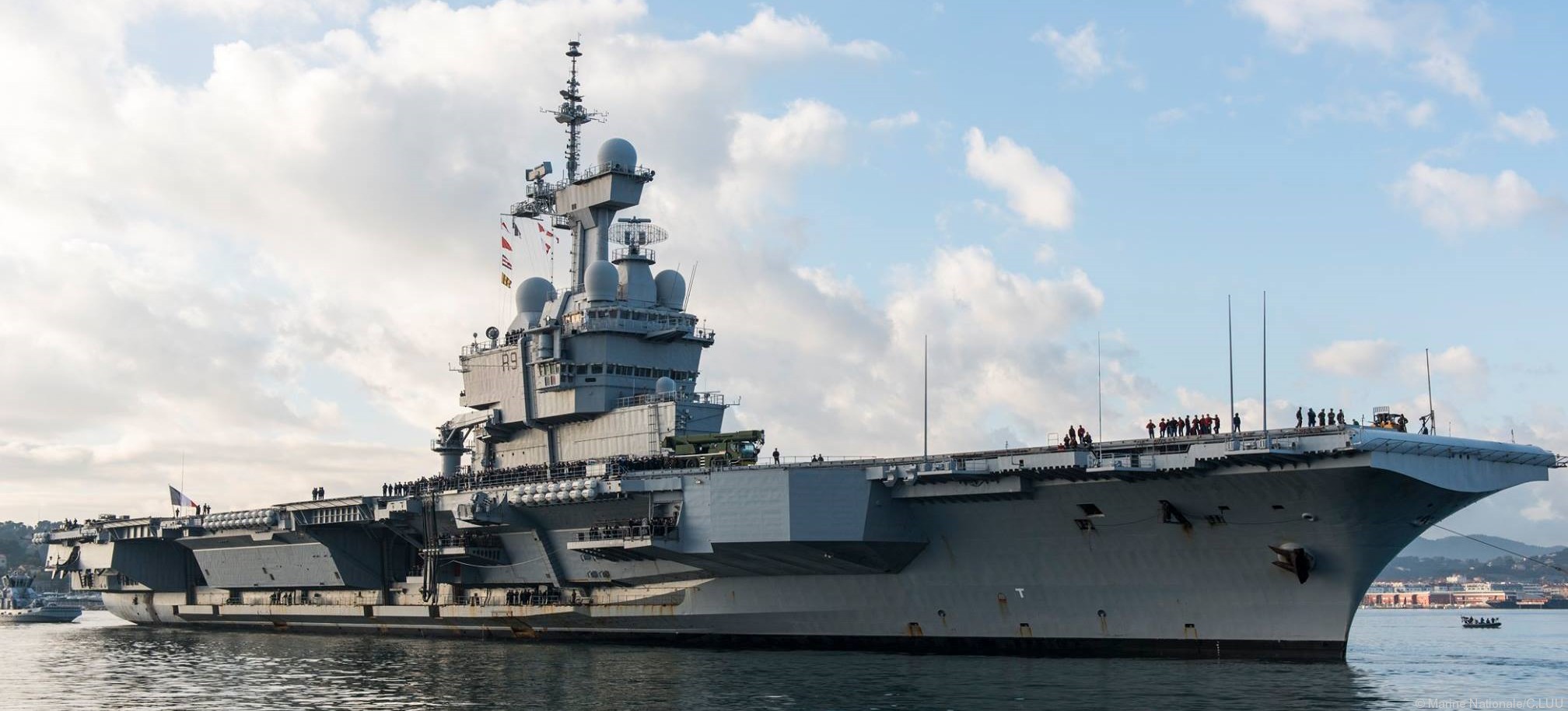 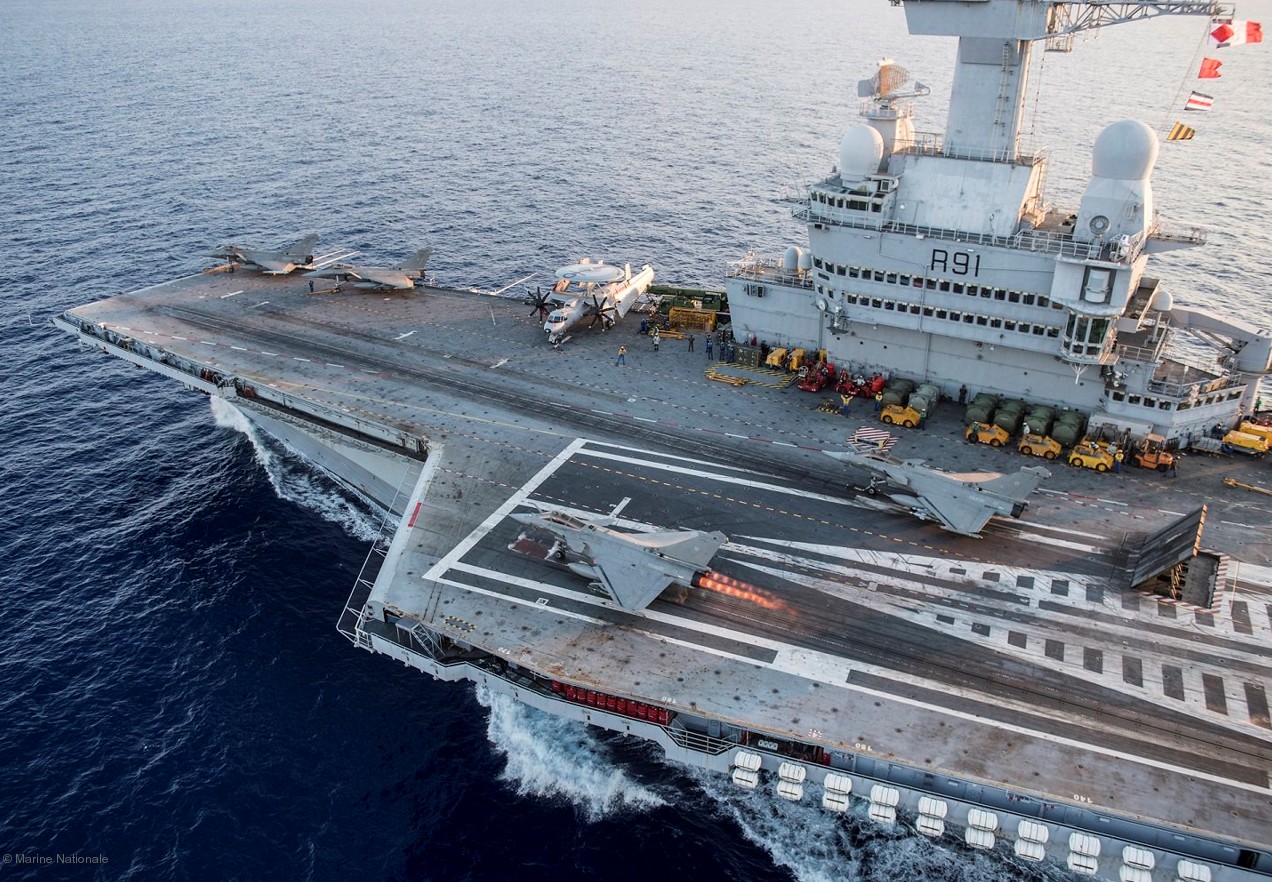 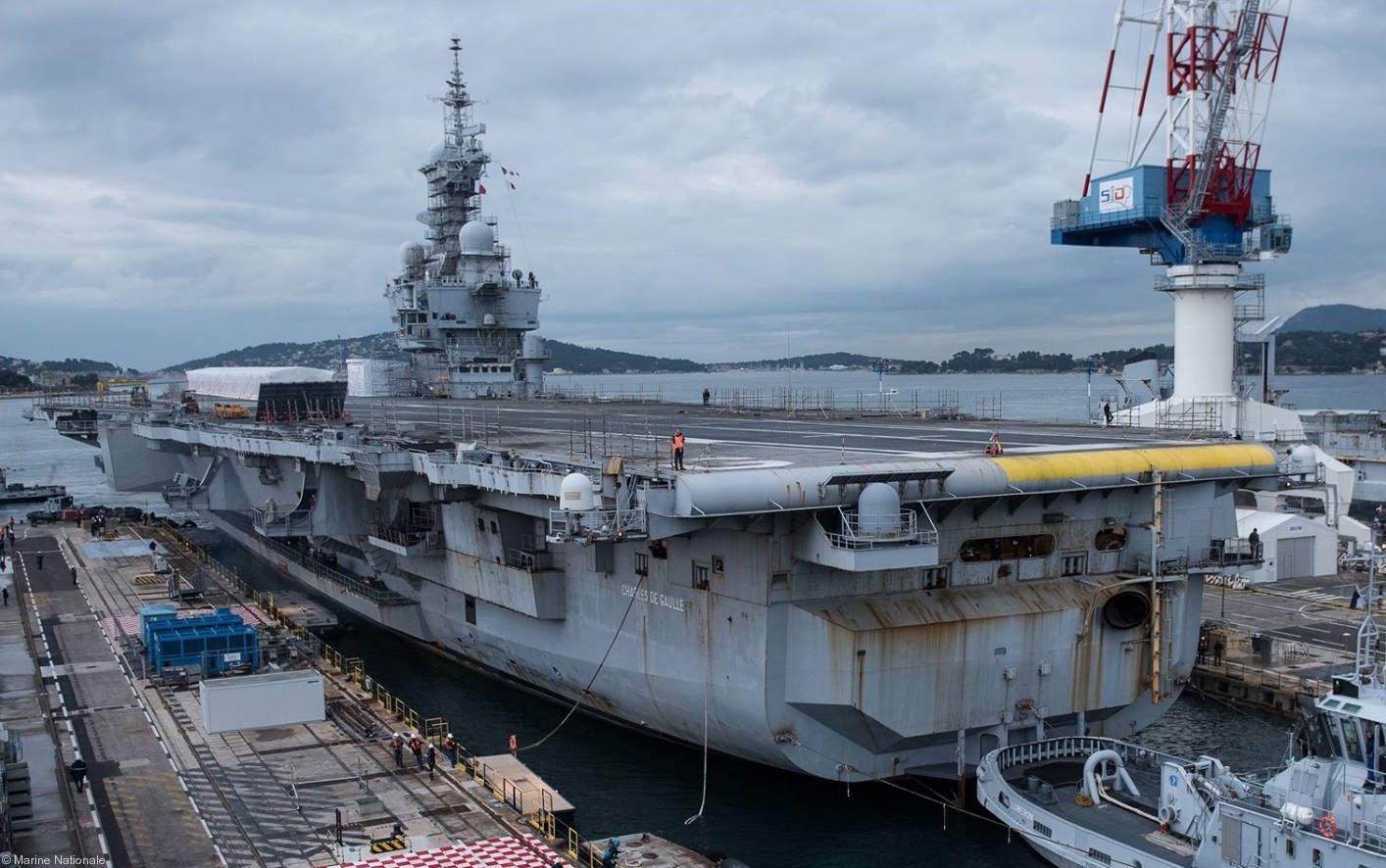 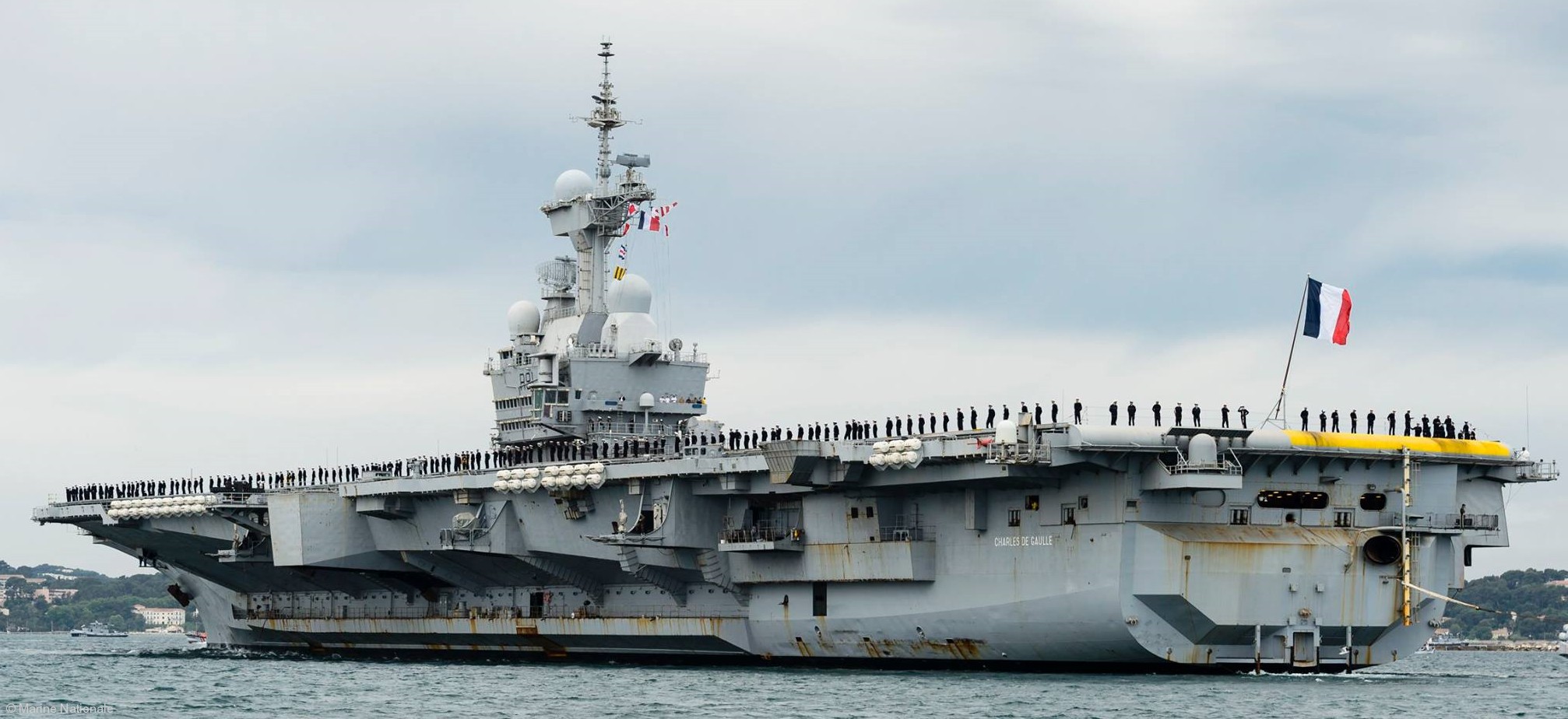 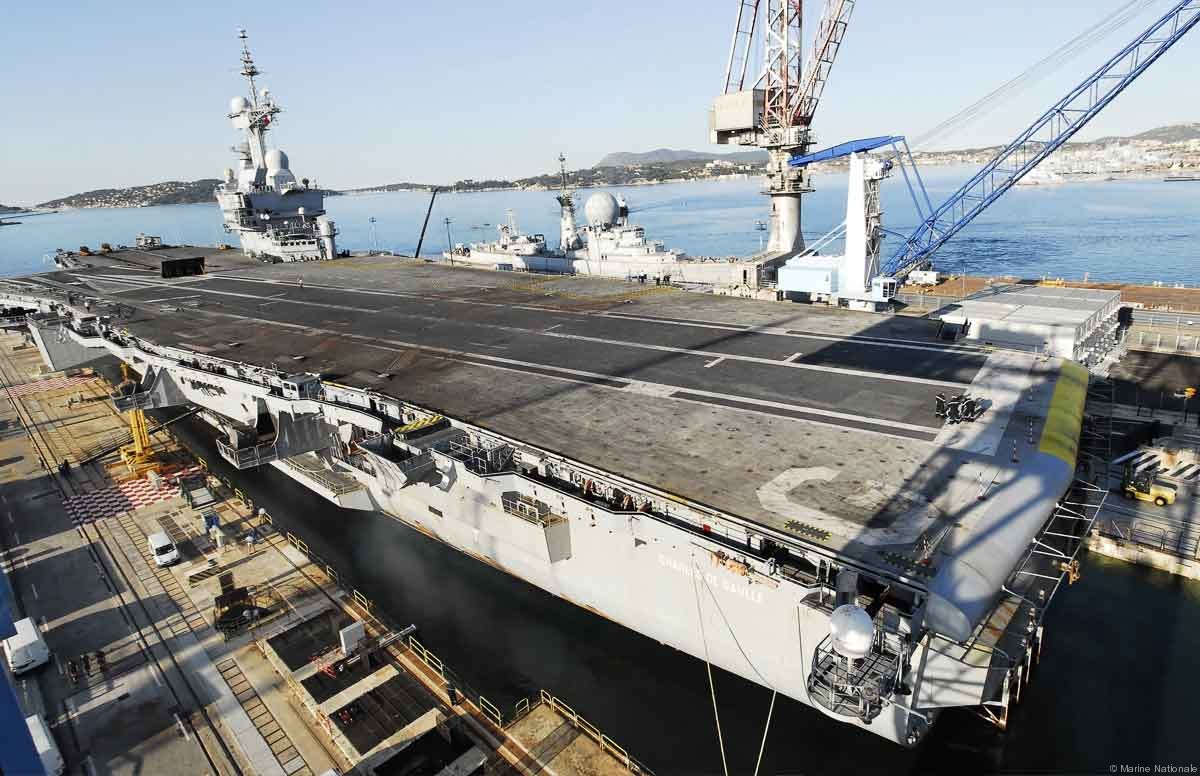 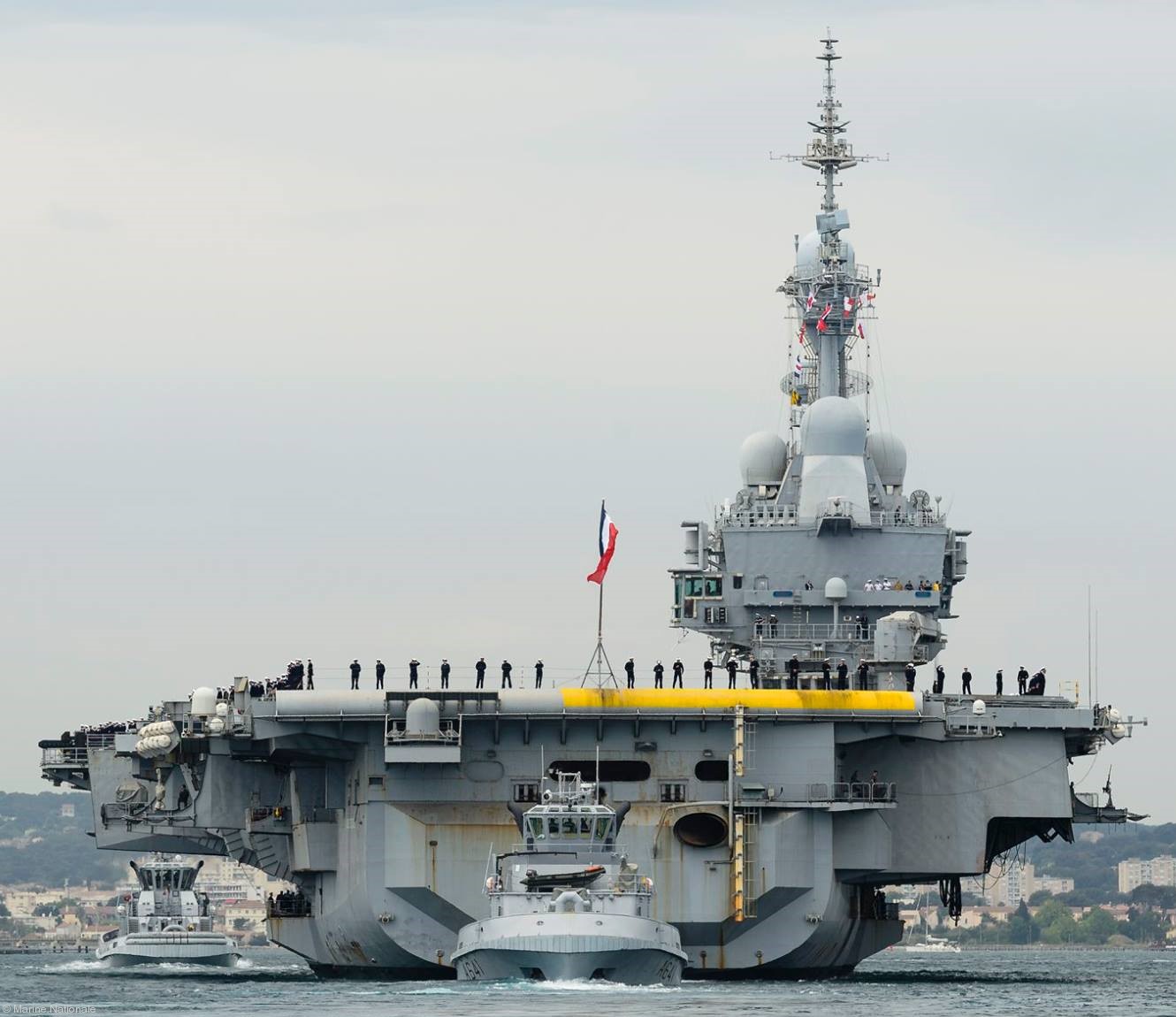 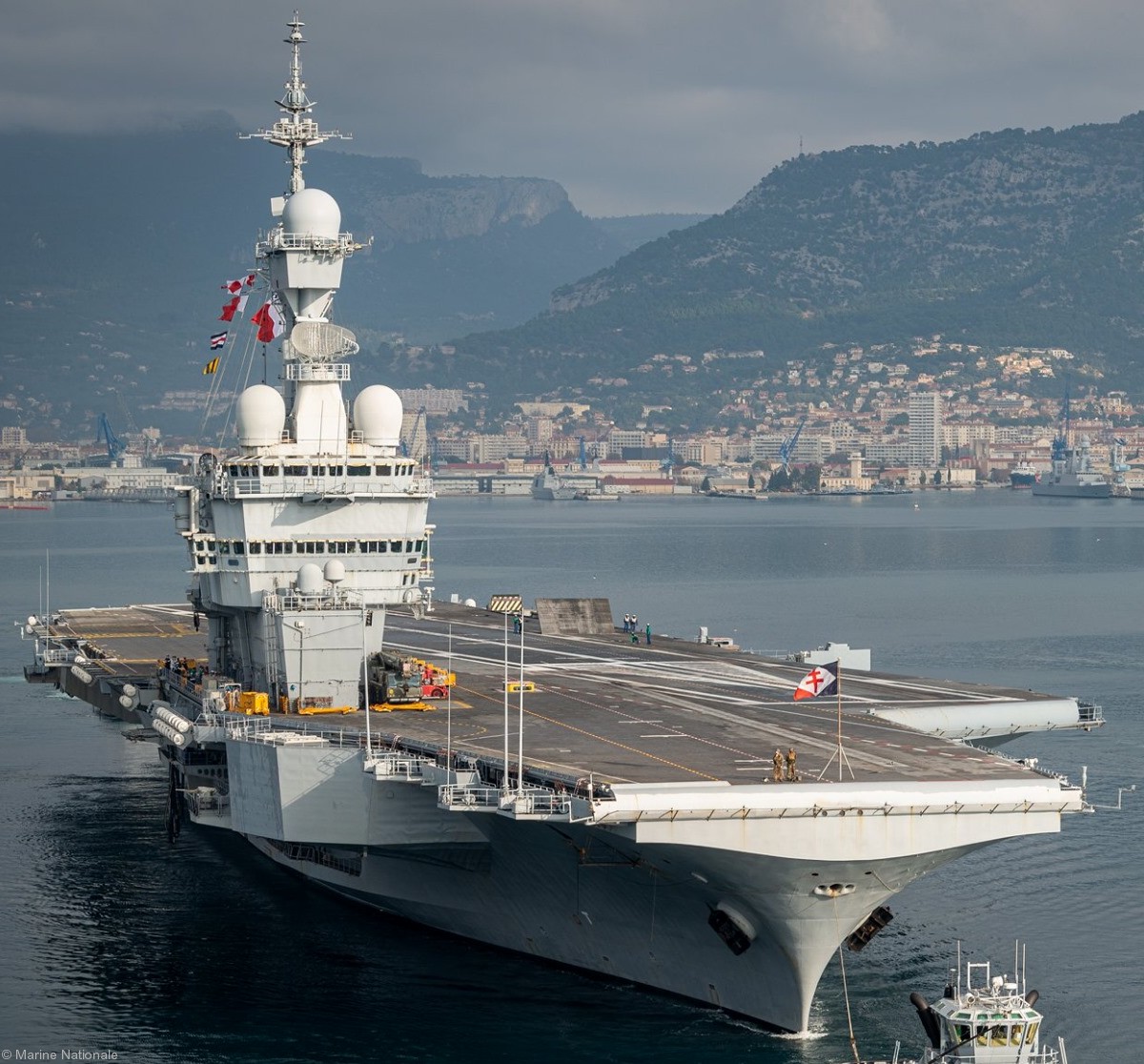 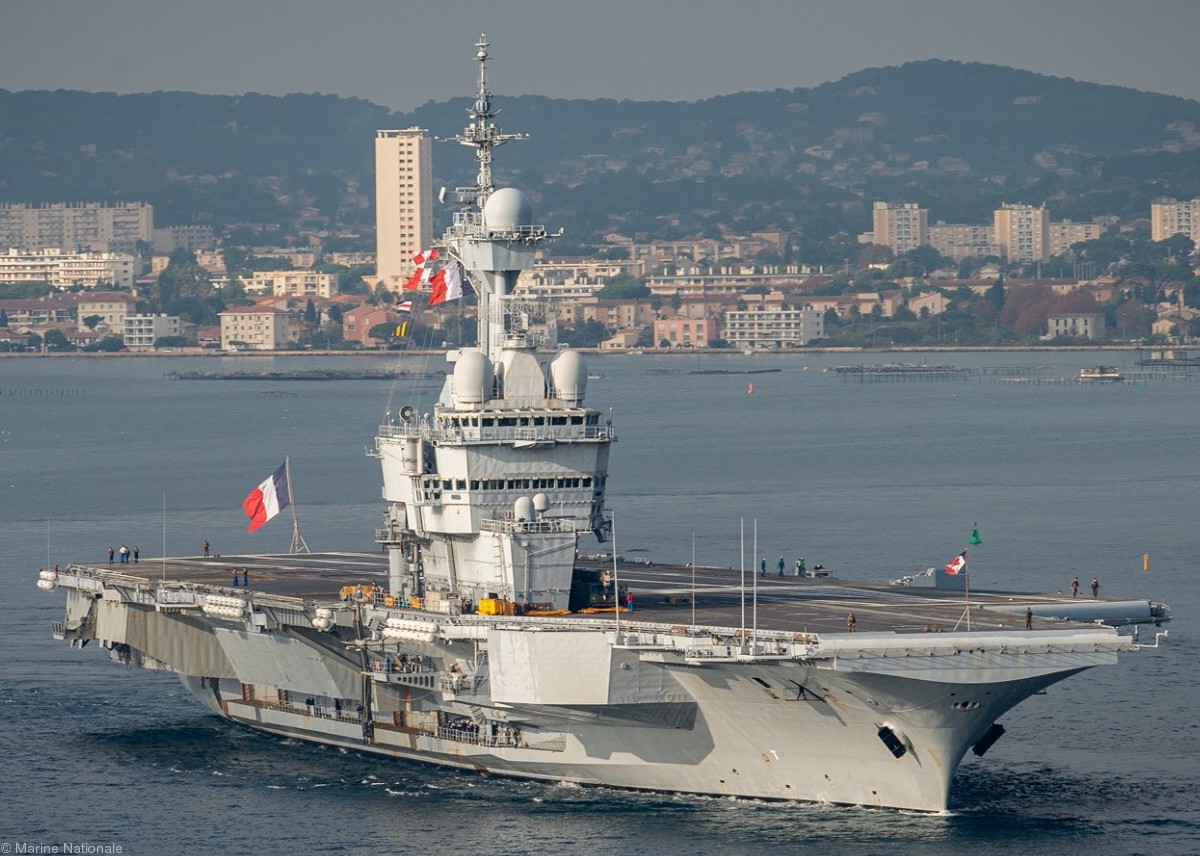 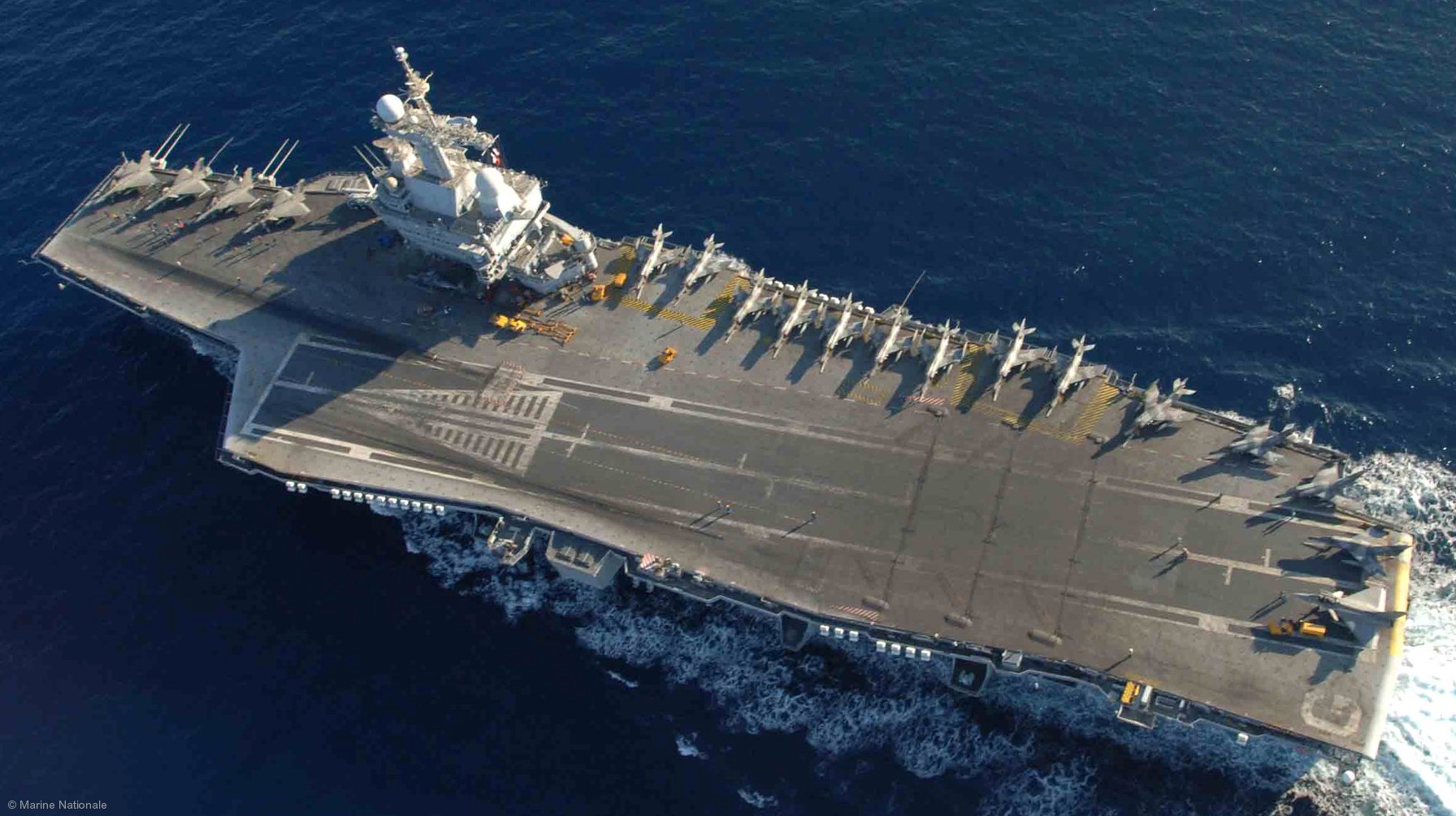 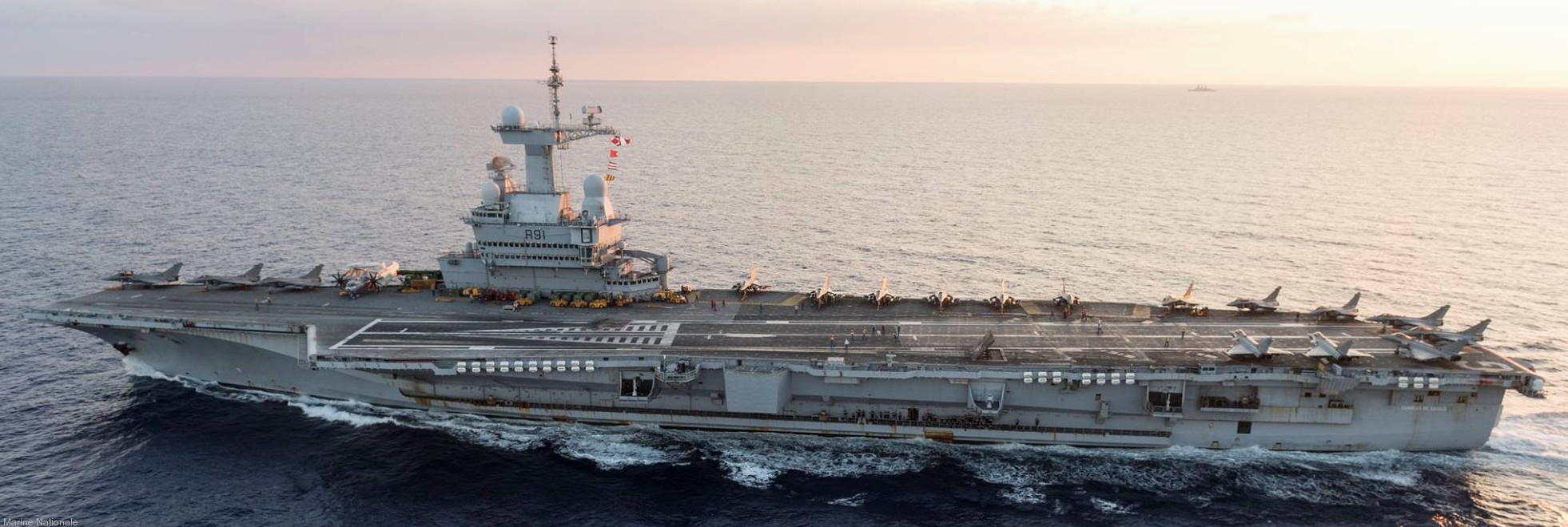  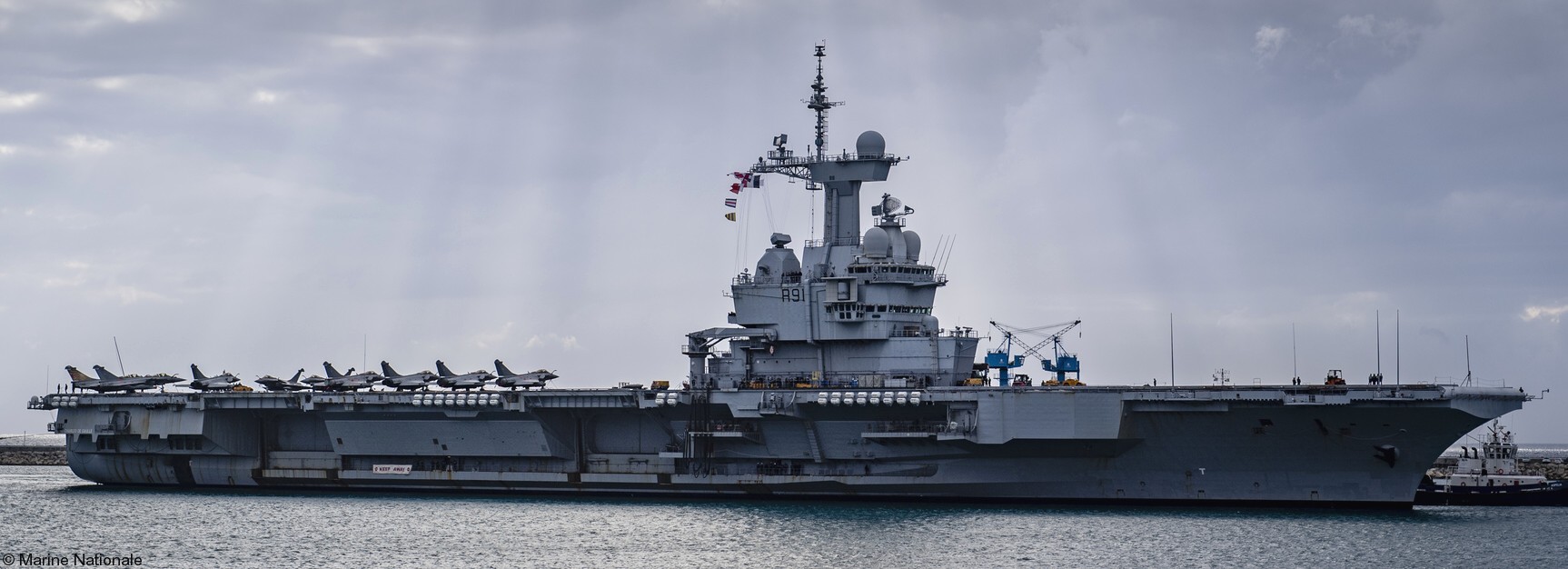 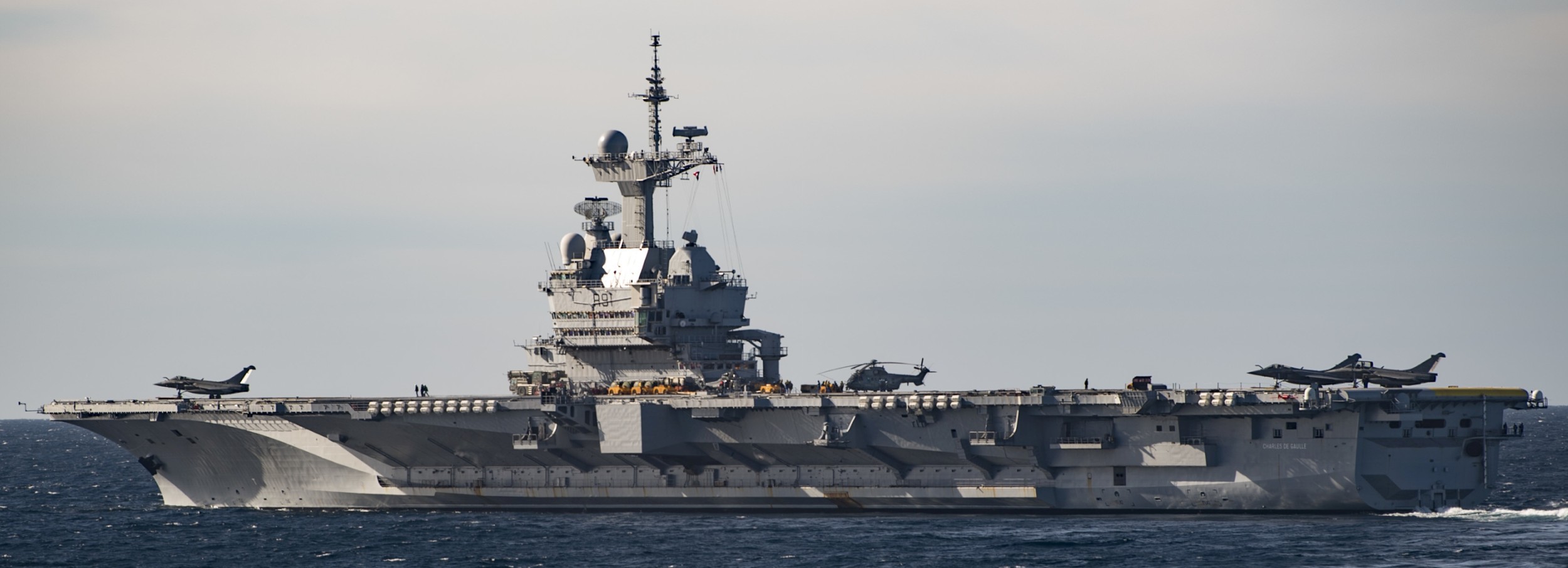  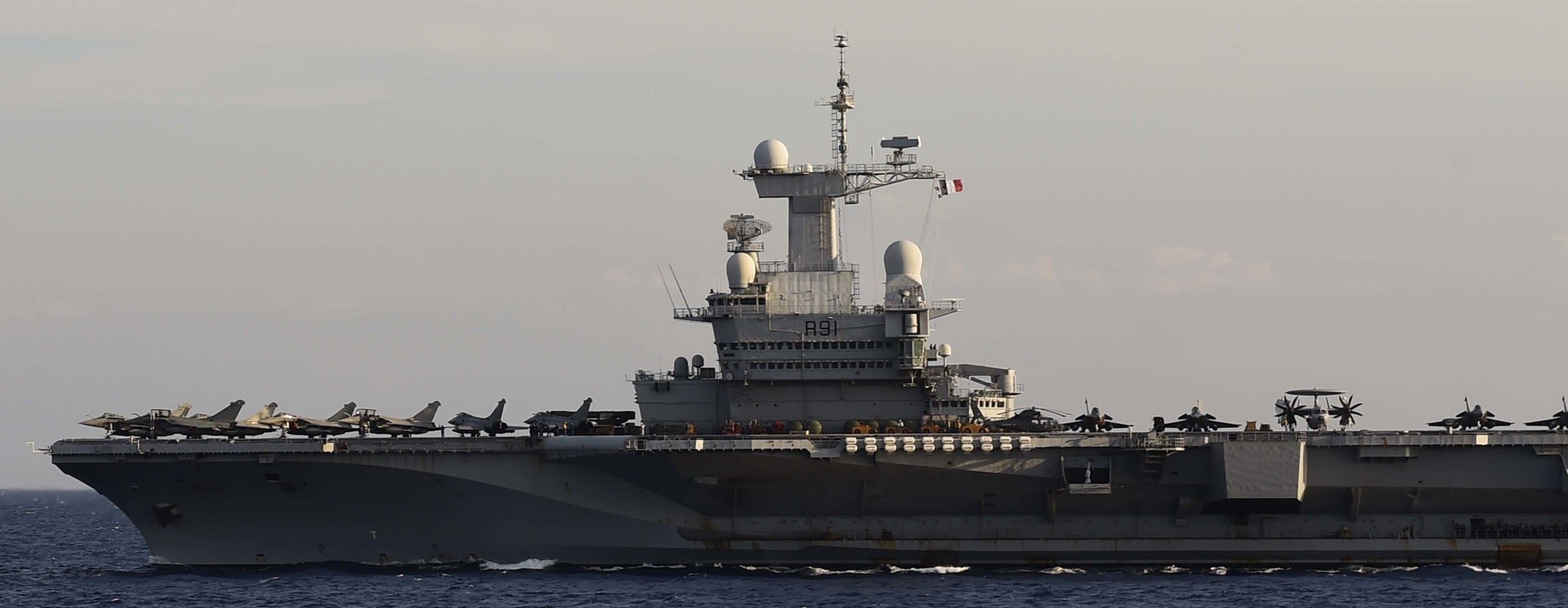  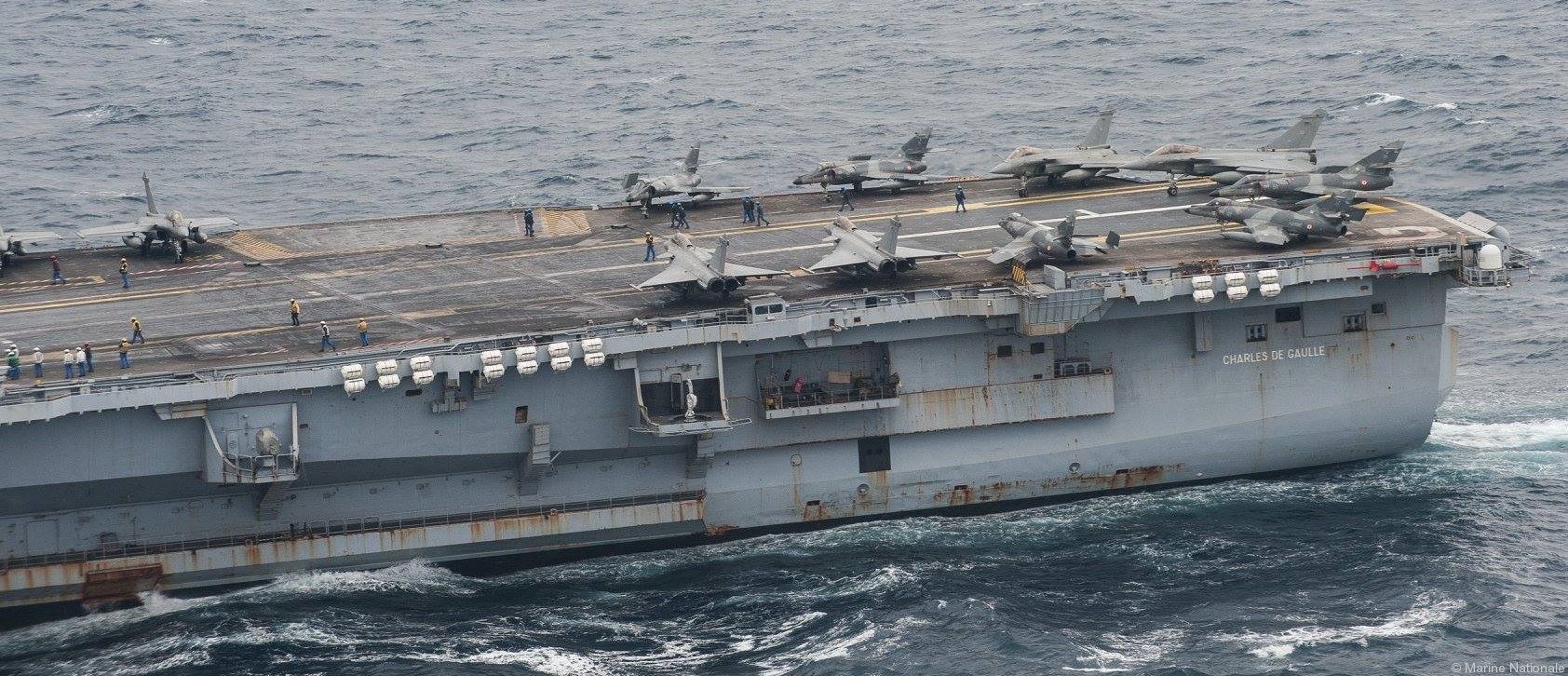  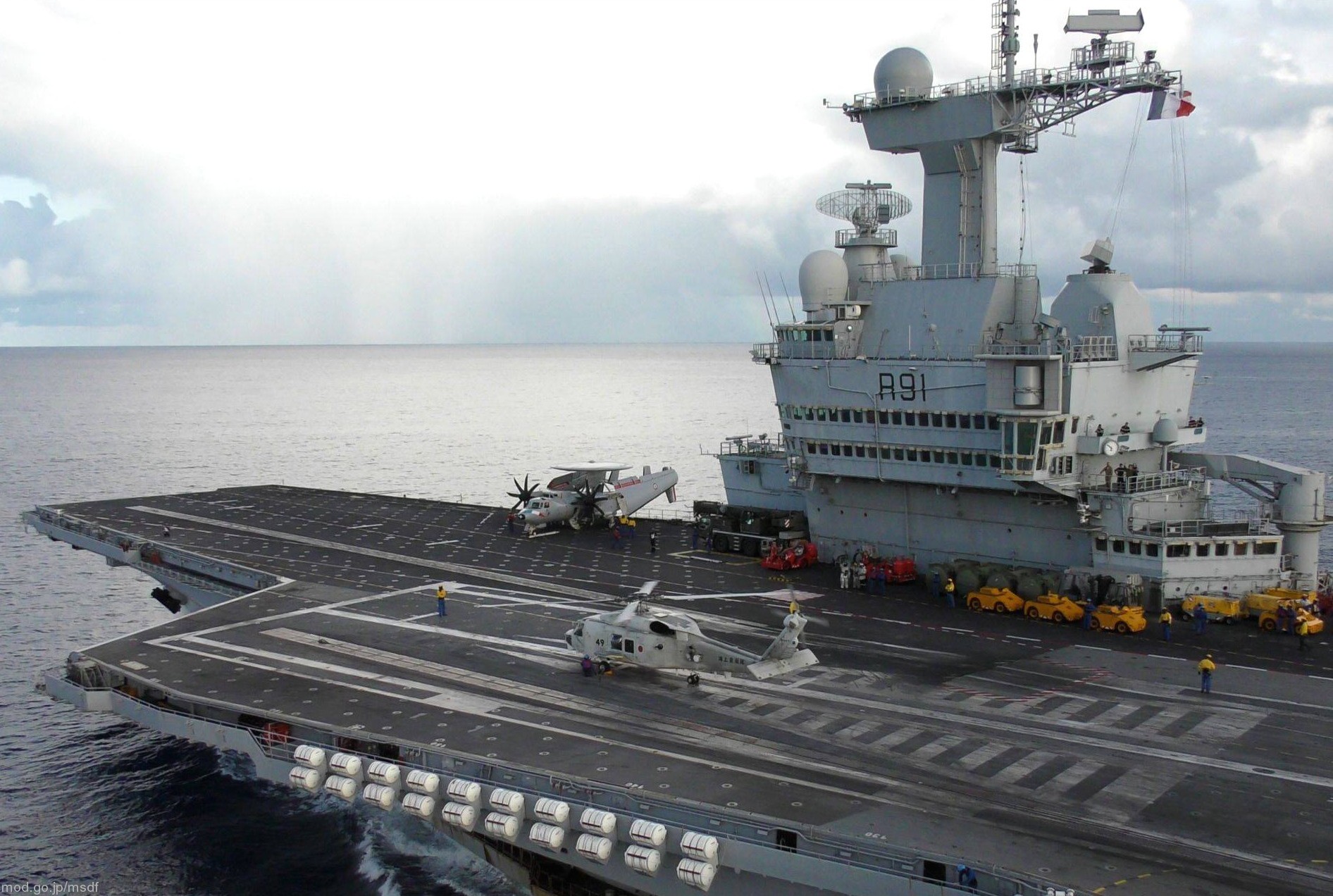 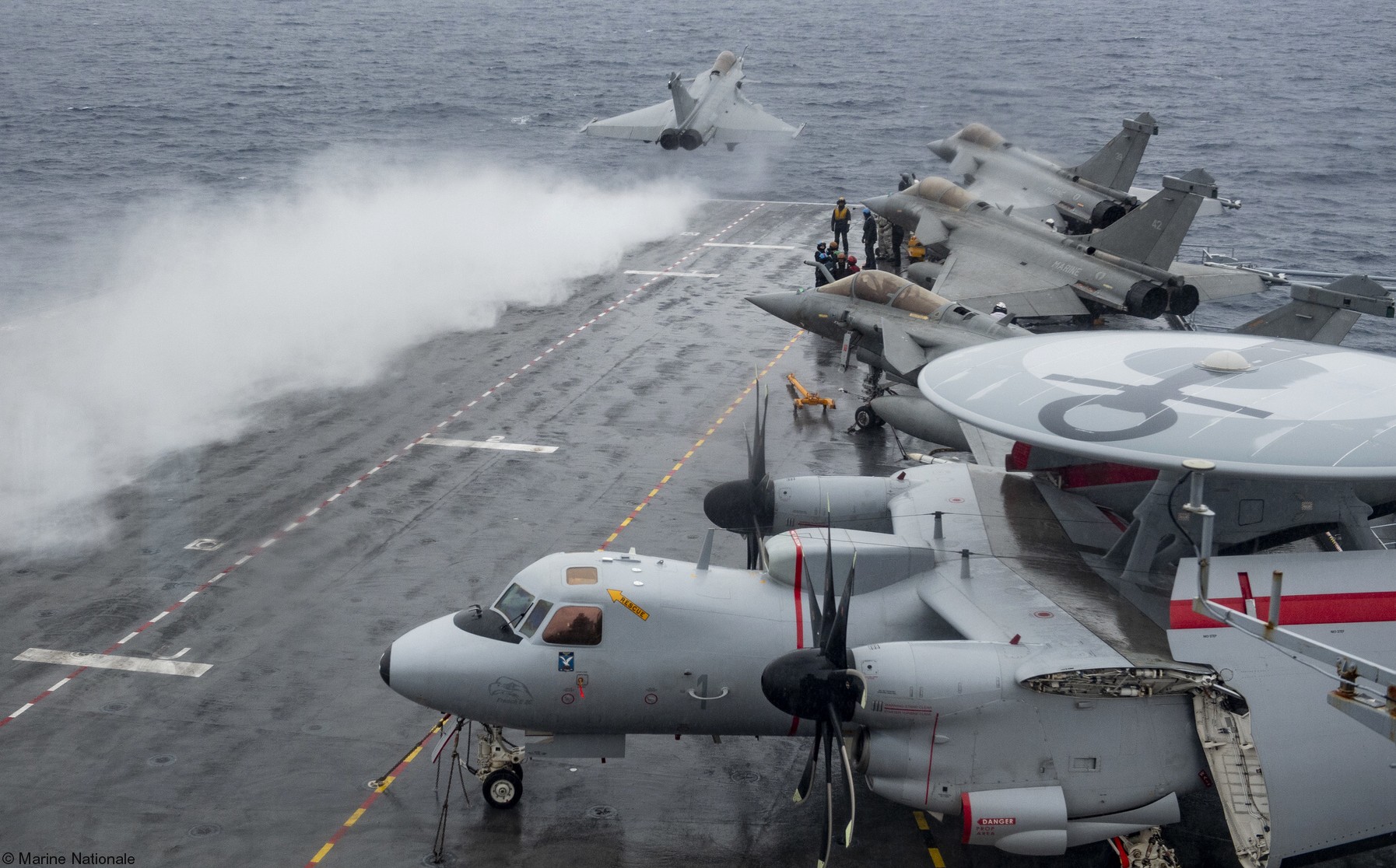 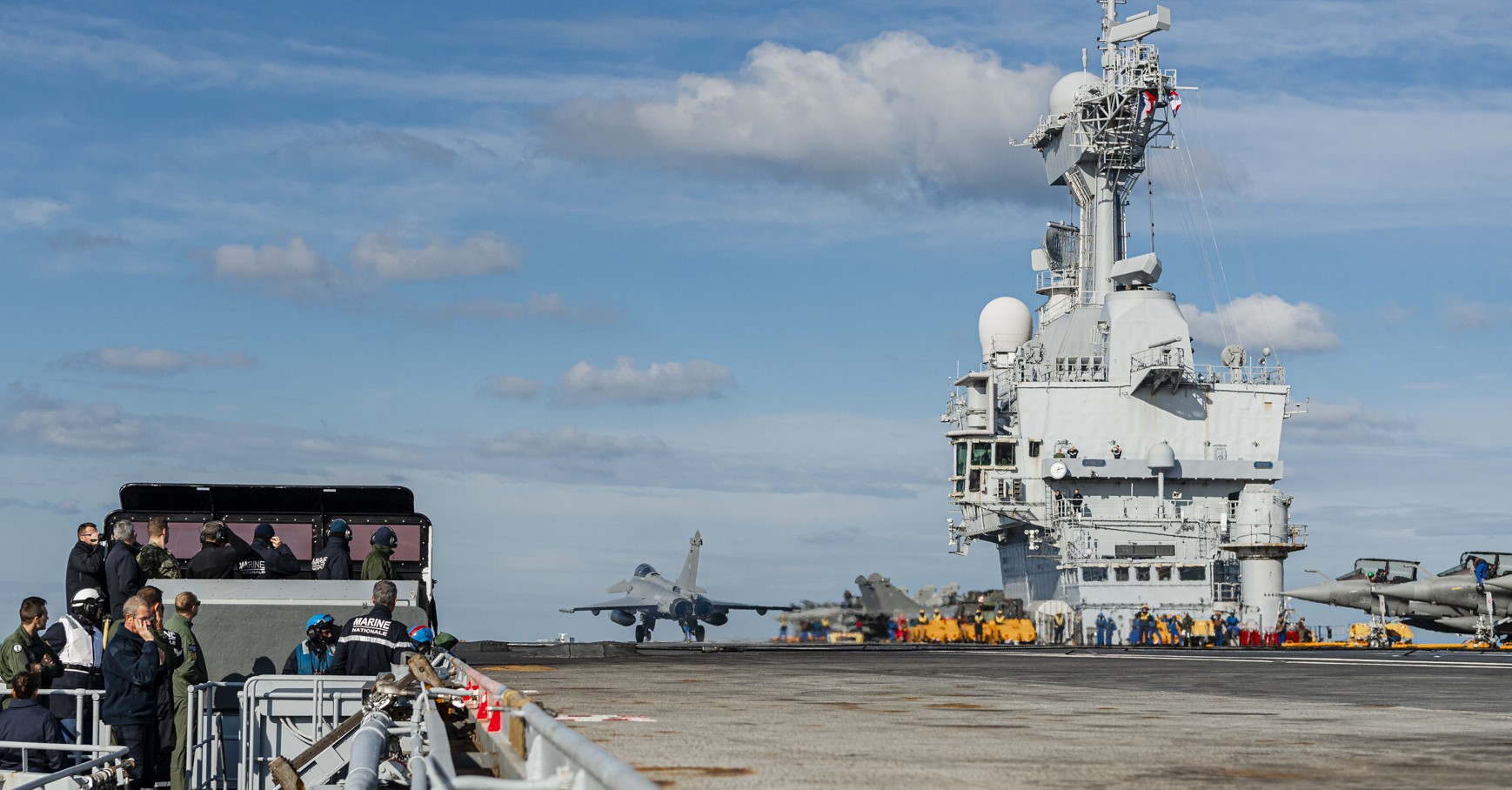 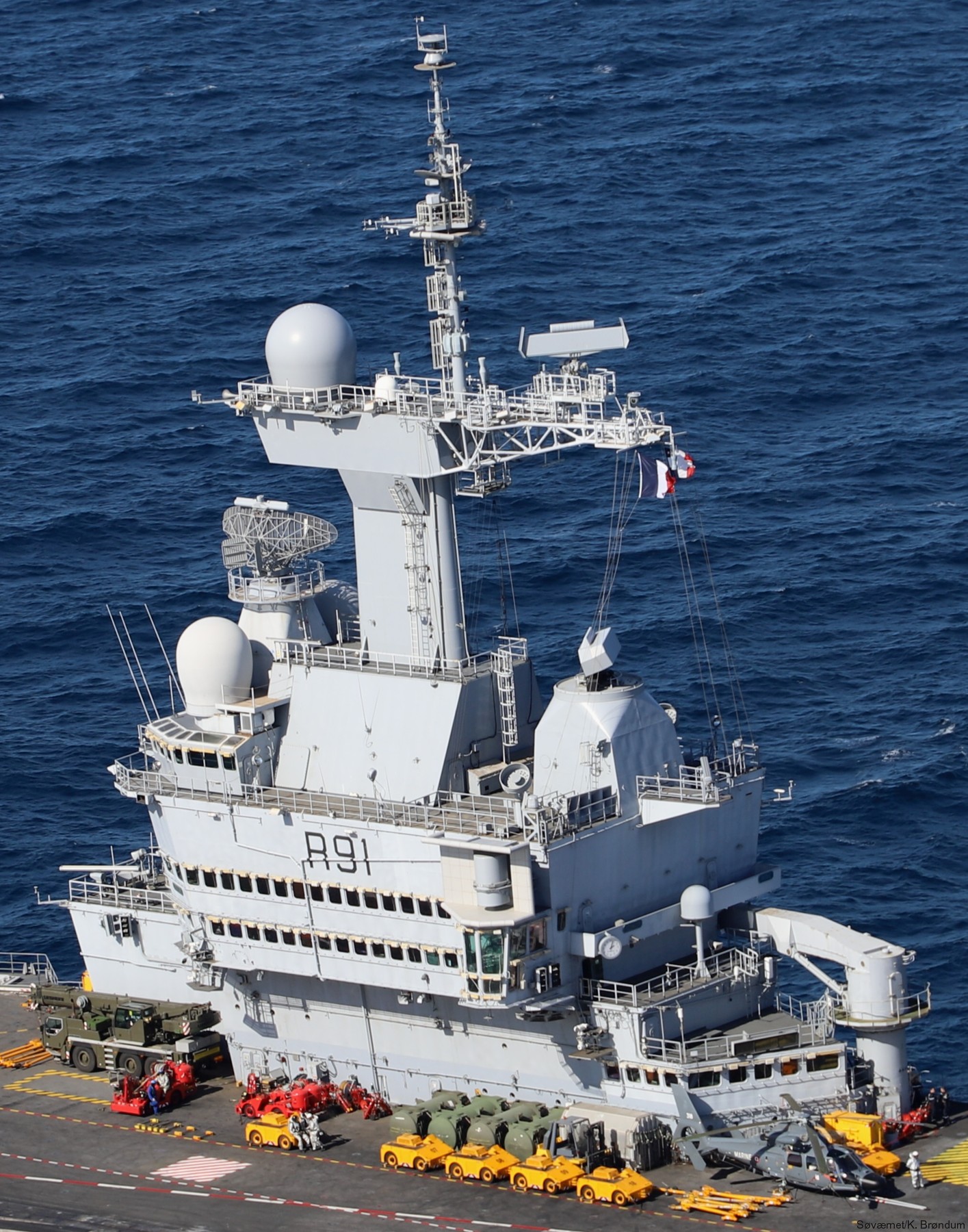 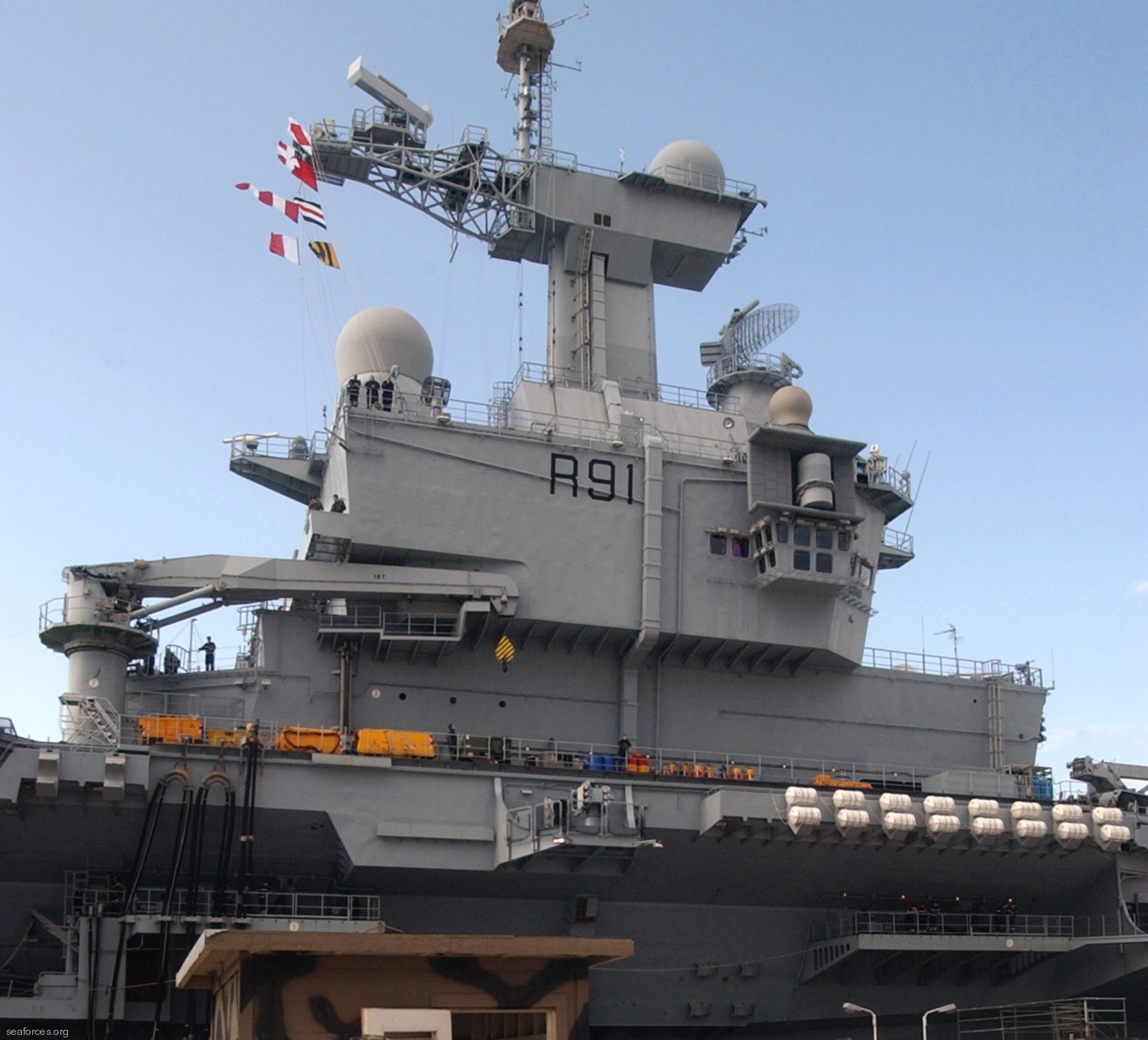 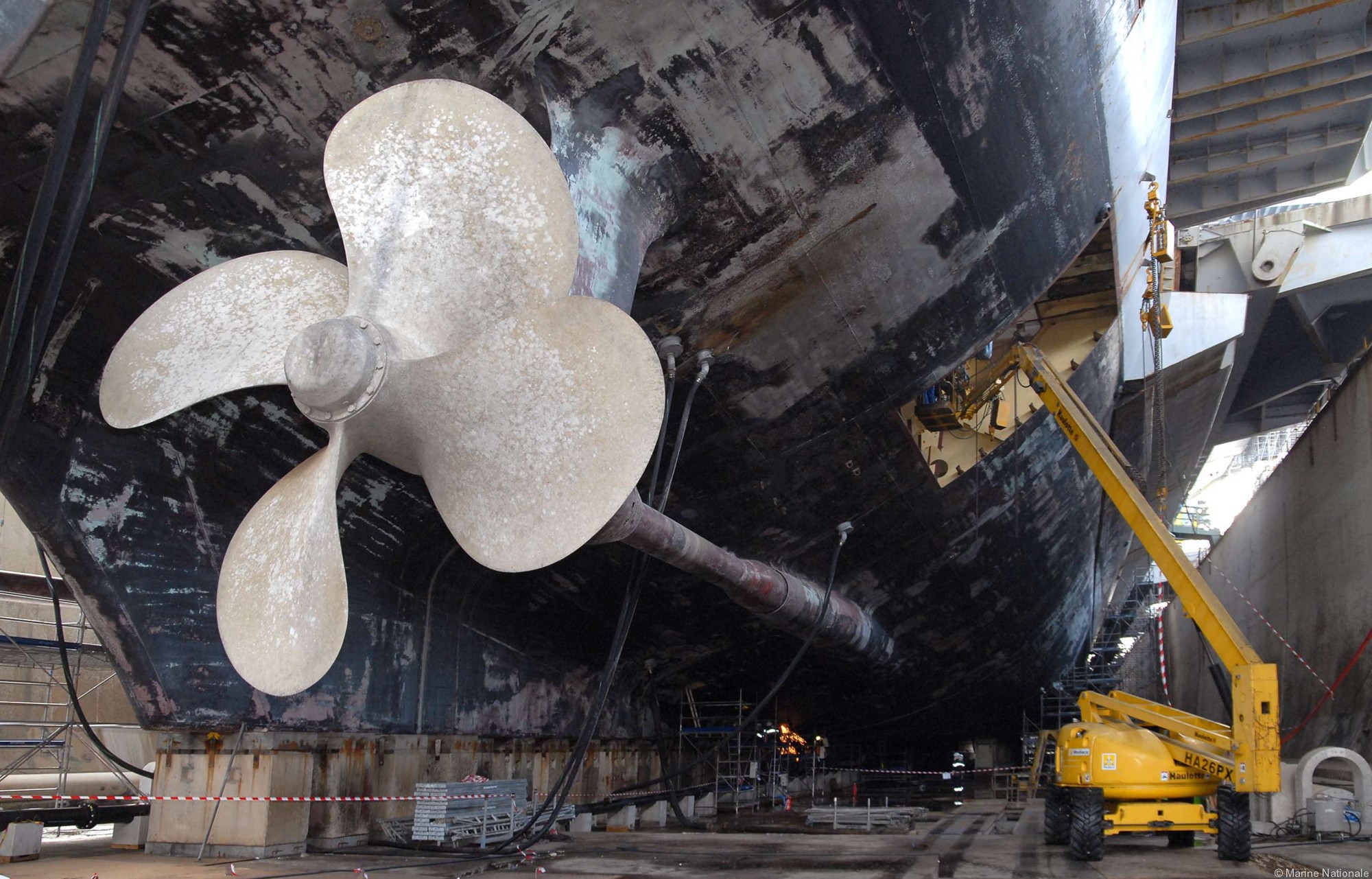 |
||||
|
FS Charles de Gaulle (R 91): Charles de Gaulle is the flagship of the French Navy (Marine Nationale). The ship is the tenth French aircraft carrier, the first French nuclear-powered surface vessel, and the only nuclear-powered carrier completed outside of the United States Navy. She is named after French statesman and general Charles de Gaulle. The ship carries a complement of Dassault Rafale M and E 2C Hawkeye aircraft, EC725 Caracal and AS532 Cougar helicopters for combat search and rescue, as well as modern electronics and Aster missiles. She is a CATOBAR-type carrier that uses two 75 m C13 3 steam catapults of a shorter version of the catapult system installed on the U.S. Nimitz-class aircraft carriers, one catapult at the bow and one across the front of the landing area. As of May 2019, Charles de Gaulle is the only non-American carrier-vessel that has a catapult launch system, which has allowed for operation of F/A-18E/F Super Hornets and C-2 Greyhounds of the US Navy. Construction: The carrier replaced Foch, a conventionally powered aircraft carrier, in 2001. Clemenceau and Foch were completed in 1961 and 1963 respectively; the requirement for a replacement was identified in the mid-1970s. The hull was laid down in April 1989 at the DCNS Brest naval shipyard. The carrier was launched in May 1994 and at 42,000 tonnes (full load) was the largest warship launched in Western Europe since HMS Ark Royal in 1950. She was to be named Richelieu in 1986 by the French president at the time, François Mitterrand, after the famous French statesman Armand-Jean du Plessis, Cardinal Richelieu. On 18 May 1987, however, the name of the ship was changed to Charles de Gaulle by the Gaullist Prime Minister at the time, Jacques Chirac. Construction quickly fell behind schedule as the project was starved of funding, which was worsened by the economic recession in the early 1990s. Total costs for the vessel would top €3 billion. Work on the ship was suspended altogether on four occasions: 1990, 1991, 1993, and 1995. The ship was commissioned on 18 May 2001, five years behind the projected deadline. In 1993, it was alleged by The Guardian that a group of engineers inspecting the vessel during her construction were British Secret Intelligence Service (MI6) operatives, believed to have been learning the method of shielding the nuclear reactors, amongst other technical details. However, the newspaper published a denial by both the British government and the Direction de la surveillance du territoire (DST) (in English: Directorate of Territorial Surveillance) that there had been any incident. Trials and technical problems: Charles de Gaulle entered sea trials in 1999. These identified the need to extend the flight deck to safely operate the E-2C Hawkeye. This operation sparked negative publicity, however, as the same tests had been conducted on both Foch and Clemenceau when the F 8E (FN) Crusader fighter had been introduced. The 5 million francs for the extension was 0.025% of the total budget for the Charles de Gaulle project. On 28 February 2000, a nuclear reactor trial triggered the combustion of additional isolation elements, producing a smoke incident. The ship left Toulon for her fourteenth and final sea trial on 24 October 2000. During the night of 9-10 November, in the Western Atlantic while en route toward Norfolk, Virginia, the port propeller broke, and the ship had to return to Toulon to have a replacement fitted. The investigations that followed showed similar structural faults in the other propeller and in the spare propellers: bubbles in the one-piece copper-aluminium alloy propellers near the centre. Although the supplier, Atlantic Industrie, was not believed to have intentionally been at fault, it was nevertheless blamed for poor-quality construction. Not long after the French defense minister ordered an investigation on quality management, a fire destroyed the archives of the supplier. As a temporary solution, the less advanced spare propellers of Clemenceau were used, limiting the maximum speed to 25 knots (44 km/h) instead of the contractual 27 knots (50 km/h). On 5 March 2001, Charles de Gaulle went back to sea with two older propellers and sailed at 25.2 knots (47 km/h) on her trials. Between July and October, she had to be refitted once more due to abnormal noises, as loud as 100 dB, near the starboard propeller, which had rendered the aft part of the ship uninhabitable. On 16 September 2001 the French press reported slightly higher than acceptable radioactivity levels aboard Charles de Gaulle, thought to be caused by a faulty isolation element. It was later discovered that the radioactivity levels matched the design, but that the regulations concerning acceptable radioactivity levels had changed. While the United States was preparing its response to the September 11 attacks in the form of Operation Enduring Freedom, French media complained about the lack of deployable French military power. At the same time, the Defence Commission reported the maintenance of the Fleet to be substandard. In this context, Charles de Gaulle, then under repairs, was again an object of criticism, with former President Valéry Giscard d'Estaing describing it as a "half-aircraft-carrier" and requesting launching of the second carrier vessel (named PA2) in order to guarantee an availability rate of 100%. Maintenance and upgrades: Charles de Gaulle's first major overhaul began in September 2007. The highlight of this 15-month refit was the refueling of the nuclear power plant, a necessary step after six years in service, during which Charles de Gaulle sailed the equivalent of 12 times around the world, spent 900 days at sea, and performed 19,000 catapult launches. Several improvements were also made, including the installation of new propellers. These allow Charles de Gaulle to reach her design speed of 27 knots (50 km/h), replacing the vintage propellers used as a stop-gap since 2001. Aircraft maintenance and weapons stores were also upgraded to allow operation of new Rafale F3 fighters armed with ASMP A nuclear missiles and SCALP EG cruise missiles, and satellite communications bandwidth will be increased tenfold. This refit increased displacement to 42500 tonnes and was completed in December 2008. After technical problems in March 2009 the carrier was back in Toulon for repairs. An intensive work up period was planned to bring Charles de Gaulle and her airgroup back to operational status. On 14 October 2010, a four-month cruise was cut down to a single day when the ship suffered an electrical fault in its propulsion system. The aircraft carrier underwent an 18-month midlife upgrade and refit begun in February 2017 and returned to service in September 2018. The nuclear reactor was refueled, standard maintenance was completed, and the ship's combat system was modernized, in order to better communicate with allies and support the Rafale fighters employed by the carrier. Service history: On 11 October 2001, the frigate Cassard, four AWACS aircraft and Charles de Gaulle were involved in a successful trial of the Link 16 high-bandwidth secure data network. The network allows real-time monitoring of the airspace from the South of England to the Mediterranean Sea. The collected data were also transmitted in real time to the frigate Jean Bart through the older MIL-STD-6011 system. On 21 November 2001, France decided to send Charles de Gaulle to the Indian Ocean in support of Operation Enduring Freedom against Taliban-controlled Afghanistan. Task Force 473, with 2,900 men under the command of Contre-Amiral François Cluzel, sailed on 1 December 2001. The task force was composed of Charles de Gaulle, frigates Lamotte-Picquet, Jean de Vienne and Jean Bart, the nuclear attack submarine Rubis, the tanker Meuse and the D'Estienne d'Orves-class aviso Commandant Ducuing. Embarked air power comprised sixteen Super Étendards, one E-2C Hawkeye, two Rafale Ms and several helicopters. The Super Étendards carried out their first missions above Afghanistan on 19 December, executing reconnaissance and bombing missions, covering over 3,000 kilometres. Overall they carried out 140 missions, averaging 12 per day. Approximately 770 sorties were carried out from the carrier. On 18 February 2002, a Helios observation satellite spotted abnormal activities near Gardez. The next day, after American Special Forces in the region confirmed these observations, Charles de Gaulle launched two reconnaissance Super Étendards. On 20 February 2002, British and US forces entered the valley and Operation Anaconda began in early March 2002. In March 2002, Super Étendards and six land-based Mirage 2000 aircraft carried out airstrikes against targets claimed to be al Qaeda. A few targets suggested by U.S. forces were denied out of fear of hitting civilians. Nevertheless, French involvement was complimented on 11 March 2002 by US President George W. Bush, who mentioned "our good ally, France, has deployed nearly one-fourth of its navy to support Operation Enduring Freedom". At this point, the French air complement had been increased to 16 Super Étendards, 6 Mirage 2000 D, 5 Rafales, and two Hawkeye AWACS. From February 2002, the air wings of Charles de Gaulle and USS John C. Stennis landed on each other's decks as a means of strengthening the ties between the allies. On 2 May 2002, Charles de Gaulle arrived in Singapore for relief, and returned to Oman on 18 May 2002. In June 2002 while Charles de Gaulle was in the Arabian Sea, armed Rafale fighters conducted combat air-patrols with the United States Navy off the coast of India and Pakistan, marking a significant point in the Rafale M's operational career and its integration with the carrier. Charles de Gaulle participated in further actions as part of Operation Enduring Freedom in 2005. She returned to Southwest Asia in May 2006 and shortly after supported coalition efforts over Afghanistan. The aircraft carrier regularly participates in the annual bilateral naval exercises between the Indian and French navies called 'Varuna'. A French naval task group, designated Task Force 473, led by Charles de Gaulle departed Toulon on 30 October 2010 for a four-month deployment, code-named Operation Agapanthus 2010, to the Mediterranean Sea, Red Sea, Indian Ocean. and Persian Gulf. The task group also included the frigates Forbin and Tourville; the nuclear attack submarine Améthyste; the replenishment oiler Meuse, 3,000 sailors, and an Embarked Aviation Group (EAG) consisting of 12 Super-Étendard attack aircraft, 10 Rafale multi-role fighters, and two E-2C Hawkeye 2000 AEW aircraft. The task group commander, Rear Admiral Jean-Louis Kerignard, defined force's mission as follows: "The force would help allied navies fight piracy off the coast of Somalia and send jets to support NATO in the skies above Afghanistan." Once on station, Task Force 473 joined two U.S. Navy carrier strike groups operating in the Persian Gulf, the Carrier Strike Group Nine led by USS Abraham Lincoln and Carrier Strike Group Ten led by USS Harry S. Truman. On 28 November 2010, according to an Associated Press dispatch, the French Ministry of Defense announced that a French Rafale fighter jet crashed near Charles de Gaulle, which was operating 60 miles (100 kilometres) off the coast of Pakistan in the Arabian Sea in support of coalition forces in Afghanistan. The pilot parachuted to safety and was picked up by helicopter, and the cause of the crash was under investigation. In December 2010, during its deployment to the Persian Gulf, the British Type 22 frigate Cumberland and the United States destroyer USS Halsey rotated from maritime security patrol to escort Charles de Gaulle in support of coalition military operations in Afghanistan. This represented an example of interoperability pursuant to the recently ratified Anglo-French defence cooperation treaty. Between 7-14 January 2011, Task Force 473 participated in bilateral naval exercises, code named Varuna 10, with the Indian Navy. Indian naval units participating in Varuna 10 included the aircraft carrier Viraat, the frigates Godavari and Ganga; and the diesel-electric submarine Shalki. Varuna 10 was a two-phase naval exercise, with the harbor phase taking place between 7-11 January and the sea phase between 11-14 January in the Arabian Sea. Task Force 473 paid a port visit to Goa between 7-14 January 2011. The carrier Charles de Gaulle and the frigate Forbin also paid a goodwill visit to Khor Fakkan, United Arab Emirates, on 30 January 2011, docking at its container terminal facilities. Operation Agapanthus 2010 concluded on 21 February 2011. Task Force 473 completed more than 1,000 flying hours flown from Charles de Gaulle in support of NATO's International Security Assistance Force (ISAF) deployed in Afghanistan. Task Force 473 also participated in bilateral exercises with armed forces of India, Saudi Arabia, and the United Arab Emirates to test the interoperability of French military forces and share expertise with the regional partners. On 20 March 2011, Charles de Gaulle was deployed to the Mediterranean Sea to enforce United Nations Security Council Resolution 1973 which called for a no-fly zone over Libya. Accompanying Charles de Gaulle were the frigates Dupleix and Aconit and the fleet replenishment tanker Meuse. During Unified Protector, the air fleet had flown 1,350 sorties during the intervention in Libya. Charles de Gaulle was then withdrawn for maintenance at Toulon on 10 August. Following this deployment, Charles de Gaulle underwent maintenance and upkeep during an at-sea underway period in December 2011. On 2 February 2012, Charles de Gaulle was underway for three days of sea trials. Beginning on 5 February 2012, carrier qualifications began for the pilots of its air group. This included transitioning of pilots flying Super Étendard Modernisé (SEM) strike fighters to the new Rafale M fighters. On 16 March 2012, Charles de Gaulle departed for a one-month deployment to the Mediterranean Sea. Charles de Gaulle's task force was under the overall command of Rear Admiral Philippe Coindreau, and it consisted of the frigates Chevalier Paul, Dupleix, Montcalm, and Enseigne de vaisseau Jacoubet; the replenishment tanker Meuse; and the nuclear-powered submarine Émeraude. Charles de Gaulle's embarked air group consisted of 7 Rafale fighters, 7 Super Étendards Modernisés (SEM) strike fighters, and 2 E 2C Hawkeye airborne early warning (AEW) aircraft. The highlight of the deployment for the task group was 2012 FANAL exercises that began on 5 April 2012 which also included land-based Atlantique 2 maritime patrol aircraft. 2012 FANAL concluded on 12 April, and this was the first major exercise involving the French Navy's new Caïman helicopter. In January 2015, Charles de Gaulle began being prepared for exercises in the Indian Ocean. In late February, the carrier and its battle group entered the Persian Gulf to participate in Opération Chammal against Islamic State militants in Iraq. France was the first country to join the American-led intervention and has 15 fighters, a patrol aircraft, and refueling aircraft based on land in neighboring countries. The addition of Charles de Gaulle added up to another 30 aircraft to France's commitment to operations. The carrier battle group arrived in the Persian Gulf on 15 February 2015 and began launching airstrikes on 22 February; this occurred seven weeks after the Charlie Hebdo attacks, as France vowed to be more responsive to jihadist terrorism. Sailing off the north coast of Bahrain, the carrier's 12 Rafale and 9 Super Étendard fighters could reach targets in half the time it would take French fighters based in the United Arab Emirates. Charles de Gaulle left the Persian Gulf in late-April 2015 after launching strike and surveillance missions against IS targets to participate in exercises with the Indian military; the carrier launched 10-15 sorties per day during its two-month deployment. On 5 November 2015, France announced Charles de Gaulle would return to the area to conduct operations and the ship departed from its base in Toulon, southern France, on 18 November. Although originally planned to redeploy to the Persian Gulf, the carrier and its strike group was re-routed to the Eastern Mediterranean Sea off the Syrian coastline, much closer to targets within Syria. Sources claim Charles de Gaulle has a larger than normal air wing of 26 fighters consisting of 18 Rafales and 8 Super Étendards; the carrier has approximately 31-34 aircraft total (the official limit is 40 aircraft). The carrier began operations on 23 November 2015, 10 days after the ISIL terrorist attacks in Paris. On 7 December 2015, Rear Admiral René-Jean Crignola of the French Maritime Force, embarked in Charles de Gaulle, took command of U.S. Naval Forces Central Command's Task Force 50, leading coalition naval strike operations. He was the first non-American to do so. In June 2016, the United States Navy awarded the crew of the Charles de Gaulle a Meritorious Unit Commendation for its accomplishments. In late September 2016, Charles de Gaulle was deployed from Toulon to the Syrian coast for the Battle of Mosul. Its squadron of 24 Rafale M aircraft supported the international coalition against ISIL through airstrikes and reconnaissance missions. In 2020, while continuing Opération Chammal in the Eastern Mediterranean, Charles de Gaulle was joined by the US Navy Arleigh Burke-class destroyer Ross. They joined forces on Operation Inherent Resolve which is an international coalition against the Daesh. Throughout the mission, the carrier strike group was joined by allied navy vessels from Germany, Belgium, Denmark, Greece, Spain, the Netherlands and Portugal. The cooperation illustrated common operational efficiency in the Mediterranean. During the operation, the Charles de Gaulle carrier group, its 2,000-member crew, a Durance-class tanker and a Hellenic Navy frigate docked at the Port of Limassol for a five-day port call. The President of Cyprus, Nicos Anastasiades, and ambassador Isabelle Dumont addressed the aircraft crew in the presence of Captain Guillaume Pinget. The aircraft carrier led the carrier strike group Task Force 473 on a five-month long operation that began in March 2019, through the Mediterranean Sea. Aircraft from Charles de Gaulle participated in the last major combat against the Islamic State in the Battle of Baghuz Fawqani and then sailed for the Indian Ocean. Arriving in Singapore on 28 May, the aircraft carrier participated in a bilateral exercise with the Singapore Armed Forces. In April 2020, 40 crew members began to show symptoms of COVID-19, requiring Charles de Gaulle to return to her home port Toulon arsenal earlier than planned, as reported on 8 April by the Ministry of Armed Forces. FS Charles de Gaulle led the carrier strike group (CSG), as part of the Operation Clemenceau 21 mission, which set sail on 21 February 2021. The CSG is deployed for several months to the Mediterranean Sea, then to the Indian Ocean and the Persian Gulf and is set to return to Toulon in June. From 18 November to 2 December 2021, the Charles de Gaulle took part in Exercise POLARIS 21 in the western Mediterranean sea. FS Charles de Gaulle set sail on 1 February leading the French Carrier Strike Group (CSG) to the Mediterranean as part of Operation Clemenceau 22 from February to April 2022. This CSG consist of 1 Air defence Destroyer, Forbin (D 620), 1 Air Defence Frigate, Alsace (D 656), 1 Anti-Submarine Frigate, Normandie (D 651), 1 Rubis-class SSN and 1 Durance-class replenishment oiler, Marne (A 630). The CSG will be joined by other 3 other allies' ships and 1 submarine. source: wikipedia (11/22) |
||||
|
|
||||
|
Charles André Joseph Marie de Gaulle (November 22, 1890 -
November 9, 1970): ... was a French general, resistant, writer and statesman. He was the leader of Free France (1940-44) and the head of the Provisional Government of the French Republic (1944-46). In 1958, he founded the Fifth Republic and was elected as the 18th President of France, until his resignation in 1969. He was the dominant figure of France during the Cold War era and his memory continues to influence French politics. Born in Lille in a devout Catholic and patriotic family, he embraced a military career and graduated from Saint-Cyr in 1912. He was a decorated officer of the First World War and came to the fore in the Interwar period as a proponent of mobile armoured divisions. At the beginning of the Second World War, he led an armoured division that inflicted several reverses on the invading German army. Refusing to accept his government's armistice with Nazi Germany in 1940, De Gaulle exhorted the French population to resist occupation and to continue the fight against Axis powers in his Appeal of 18 June. He led a government in exile and the Free French Forces against the Axis. Despite frosty relations with Britain and especially the United States, he emerged as the undisputed leader of the French resistance. He became Head of the Provisional Government of the Republic in June 1944, the interim government of France following the liberation of France. When the Algerian war was ripping apart the unstable Fourth Republic, the National Assembly brought him back to power during the May 1958 crisis. De Gaulle founded the Fifth Republic with a strengthened presidency, and he was elected in the latter role. He managed to keep France together while taking steps to end the war, much to the anger of the Pieds-Noirs (Frenchmen settled in Algeria) and the military; both previously had supported his return to power to maintain colonial rule. He granted independence to Algeria and progressively to other French colonies. Economically, he pursued a dirigist policy, which included substantial state-directed control over a capitalist economy. In the context of the Cold War, de Gaulle initiated his "Politics of Grandeur", asserting that France as a major power should not rely on other countries, such as the United States, for its national security and prosperity. To this end, de Gaulle pursued a policy of "national independence" which led him to withdraw from NATO's military integrated command and to launch an independent nuclear development program that made France the fourth nuclear power. He restored cordial Franco-German relations in order to create a European counterweight between the "Anglo-Saxon" (American and British) and Soviet spheres of influence. However, he opposed any development of a supranational Europe, favouring a Europe of sovereign Nations and vetoed twice Britain's entry into the European Community. De Gaulle openly criticised the U.S. intervention in Vietnam and the "exorbitant privilege" of the U.S. dollar, and supported an independent Quebec. In May 1968, he appeared likely to lose power amidst widespread protests by students and workers, but survived the crisis with backing from the Army and won an election with an increased majority in the Assembly. Nonetheless, de Gaulle resigned in 1969 after losing a referendum in which he proposed more decentralization. He died a few months later at his residence in Colombey-les-Deux-Églises. His War Memoirs, written in the 1950s, quickly became a classic of modern French literature. Many French political parties and figures claim the gaullist legacy. source: wikipedia
|
||||
| patches + more | ||||
|
|
seaforces.org
|
French
Navy start page
| |
